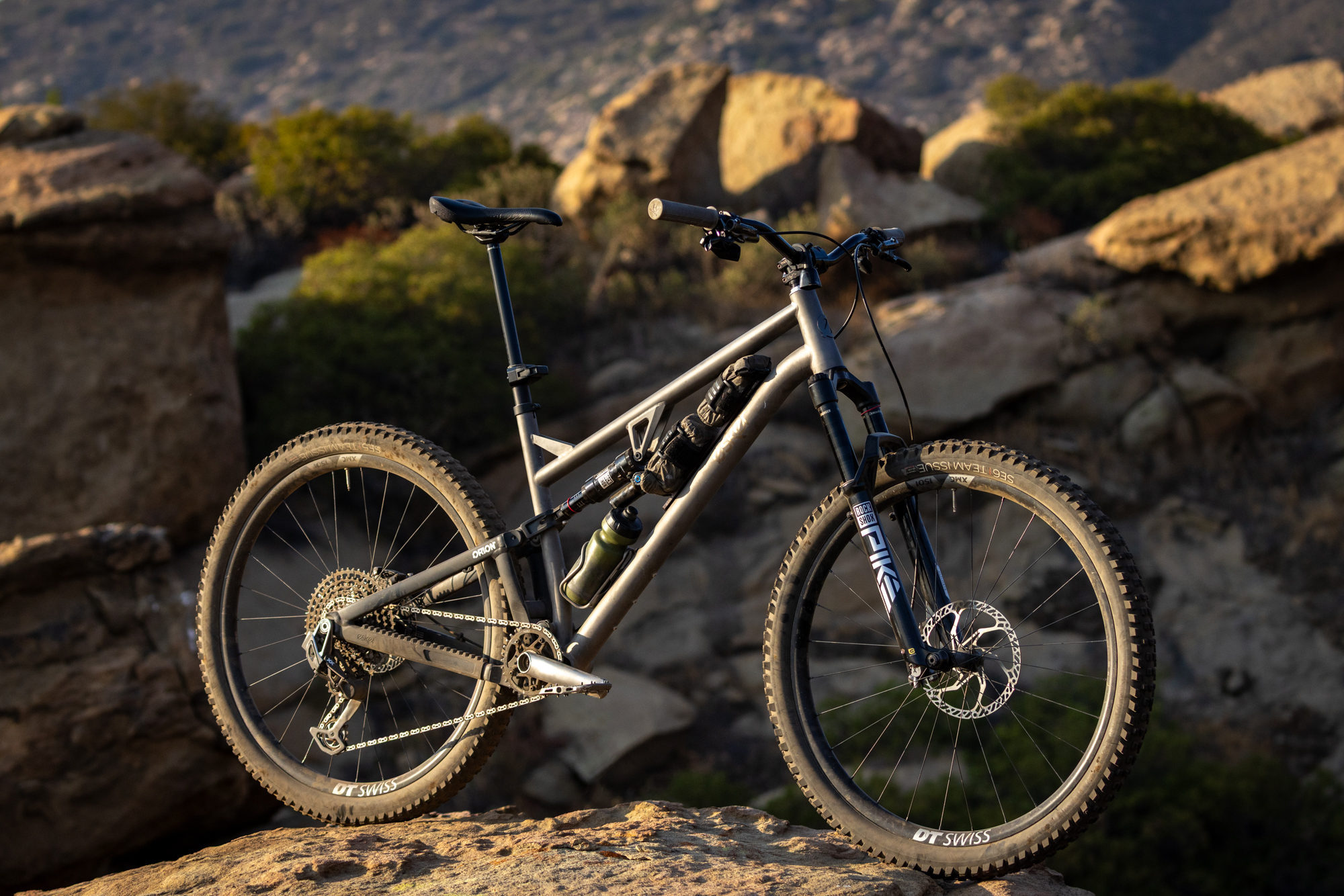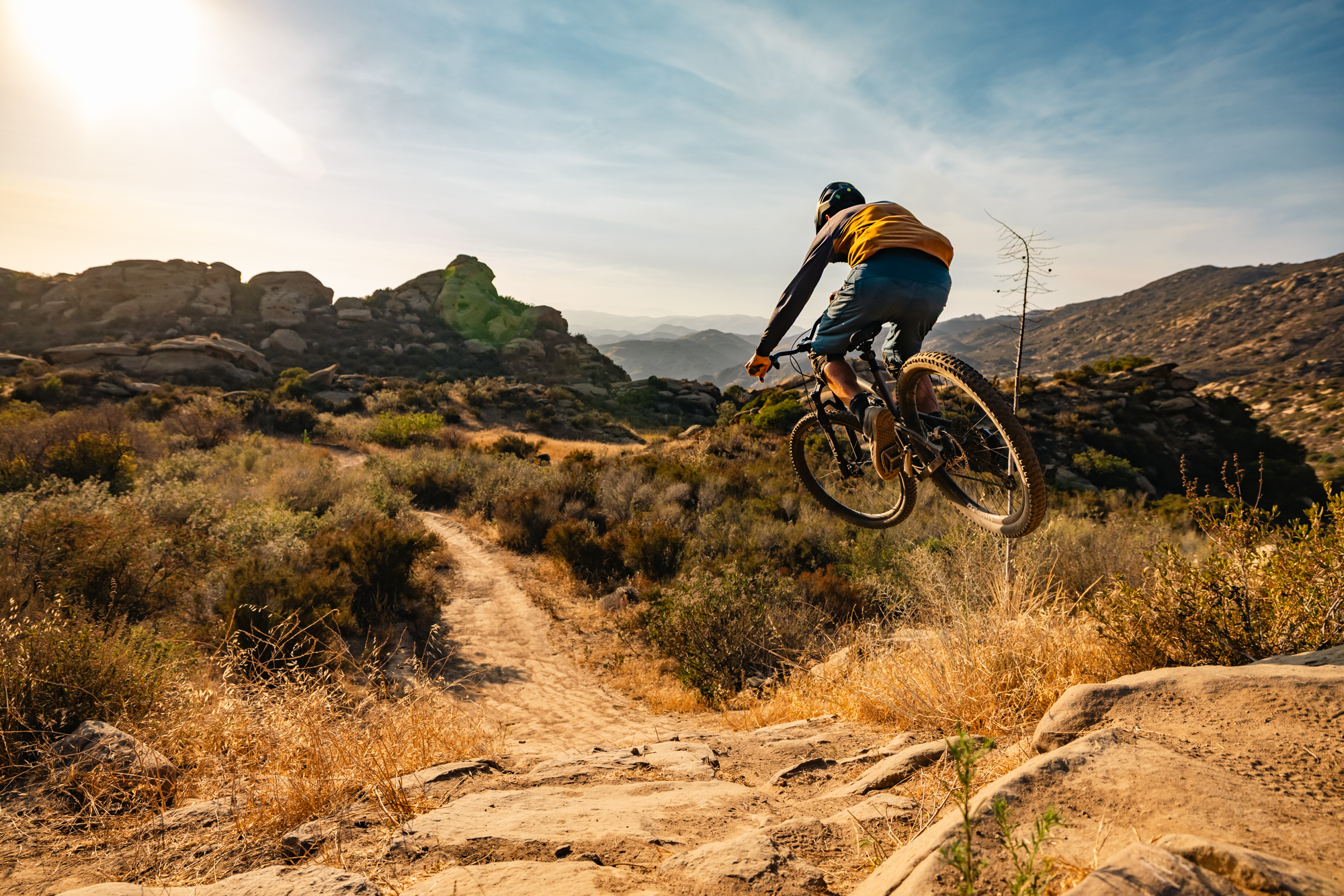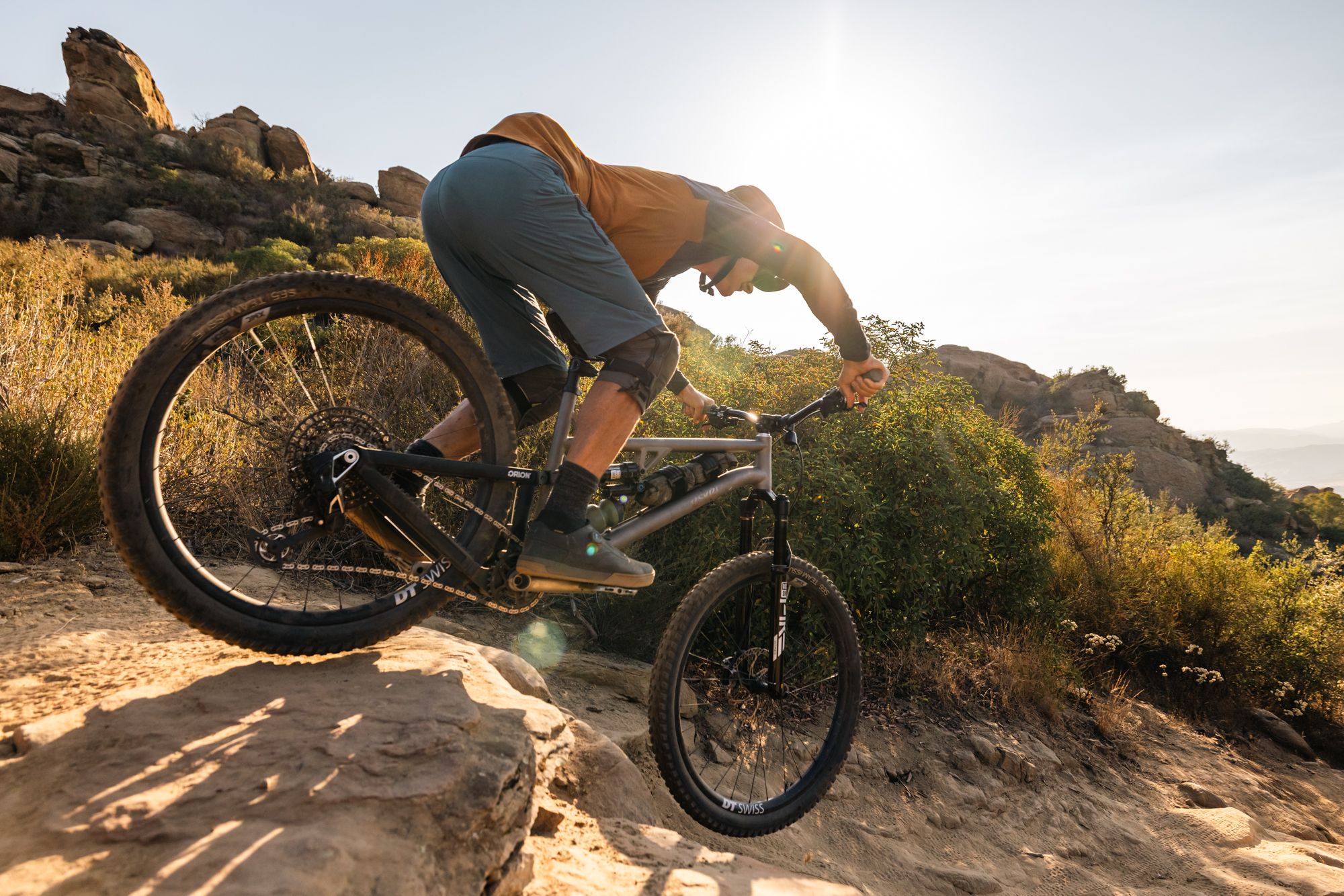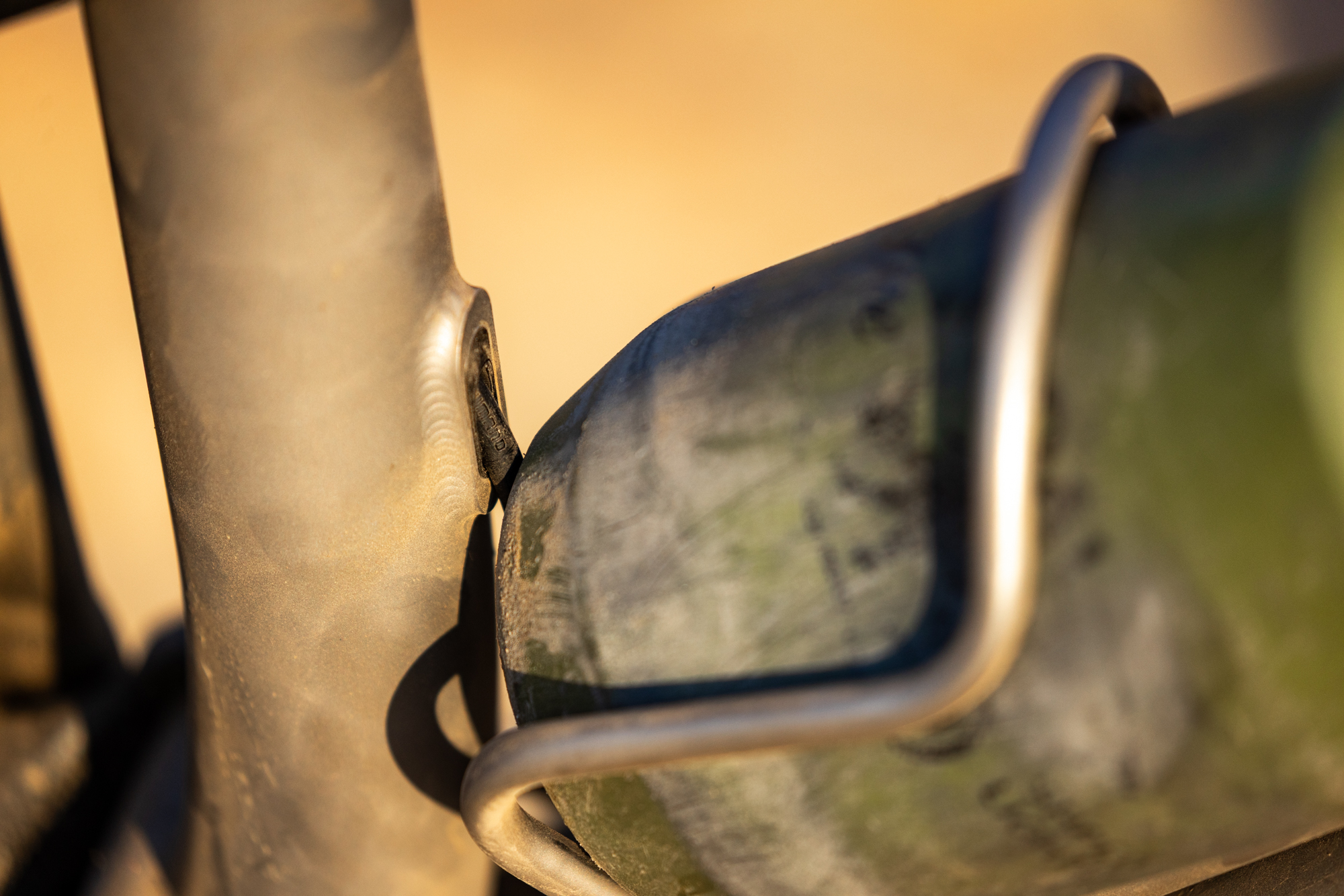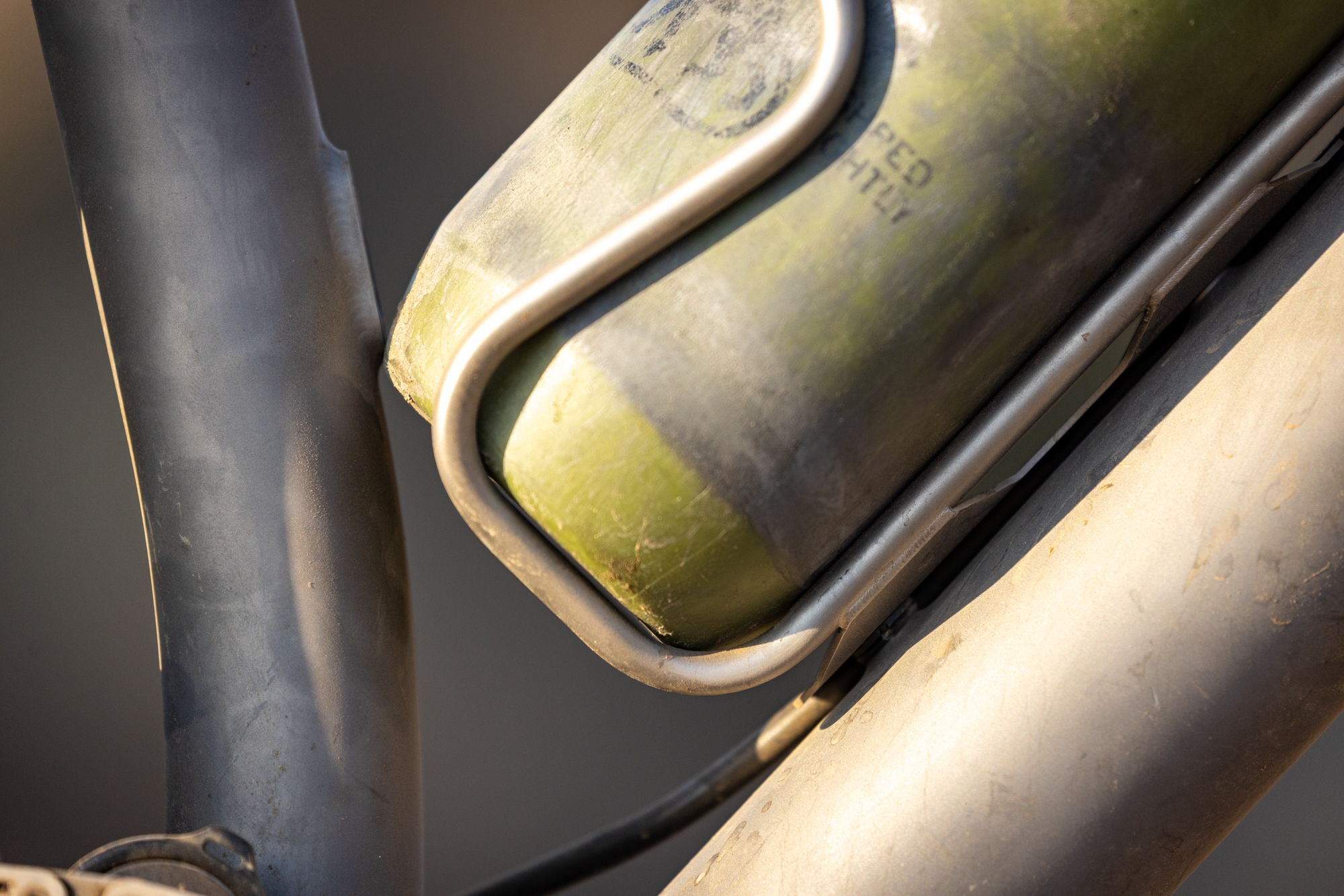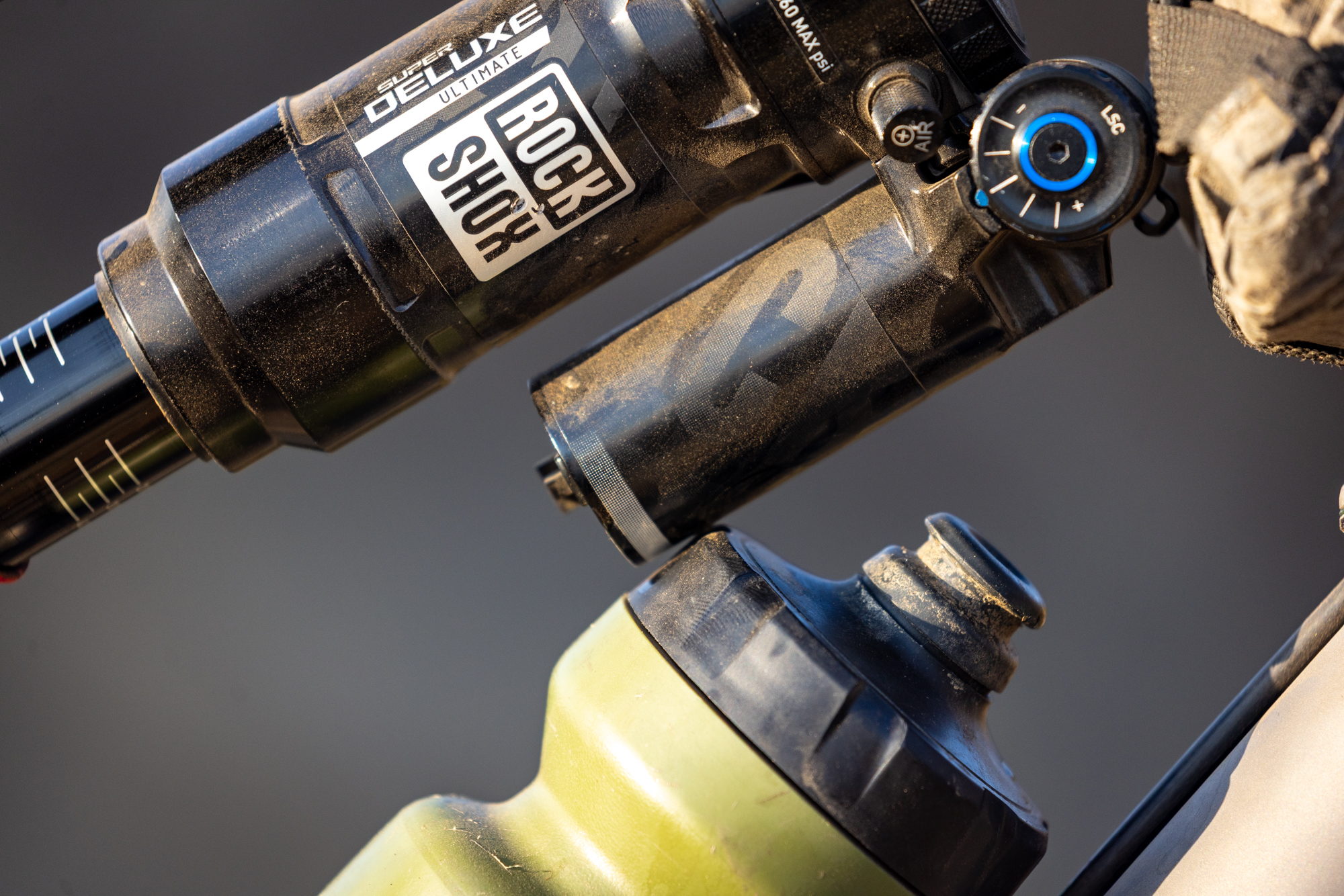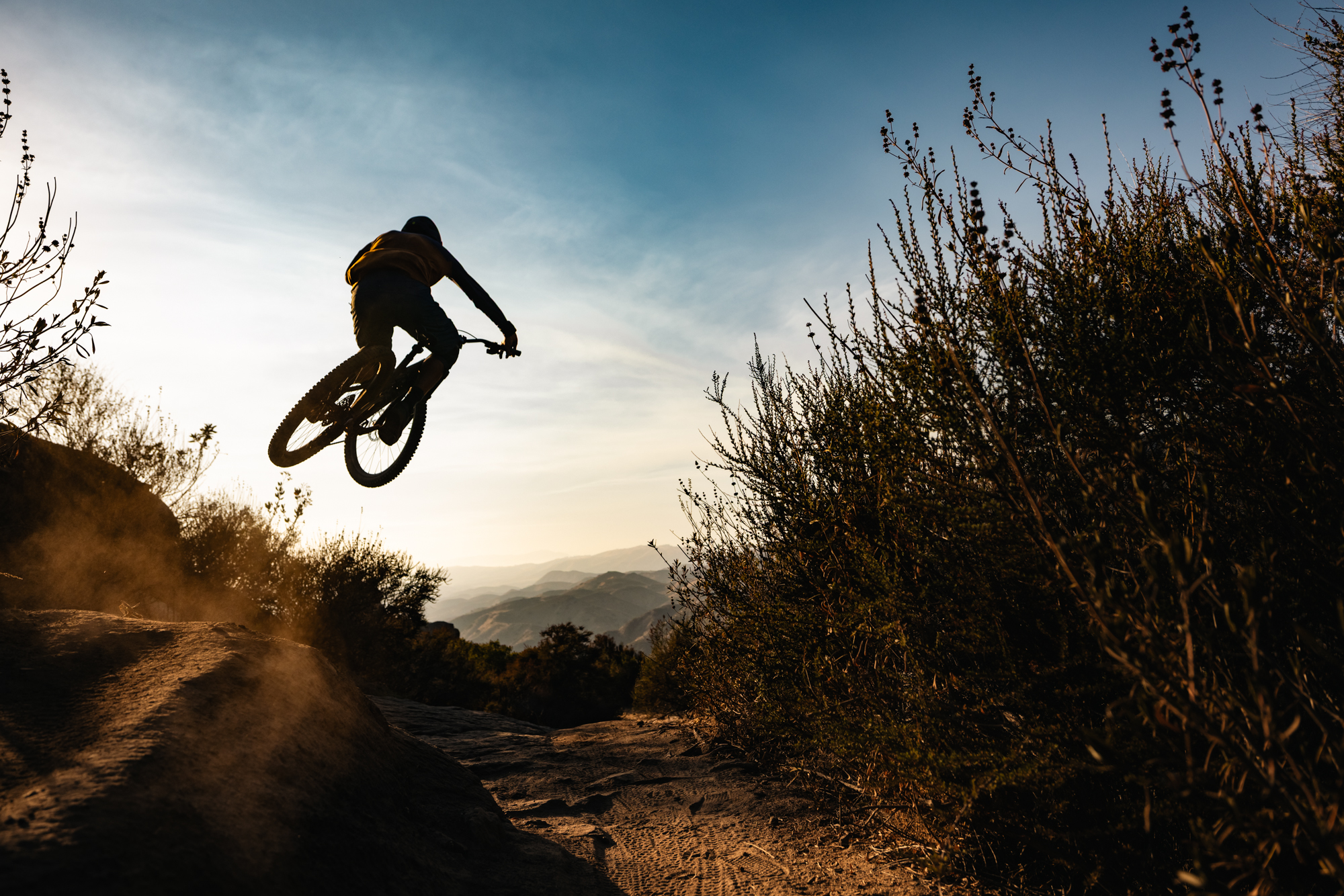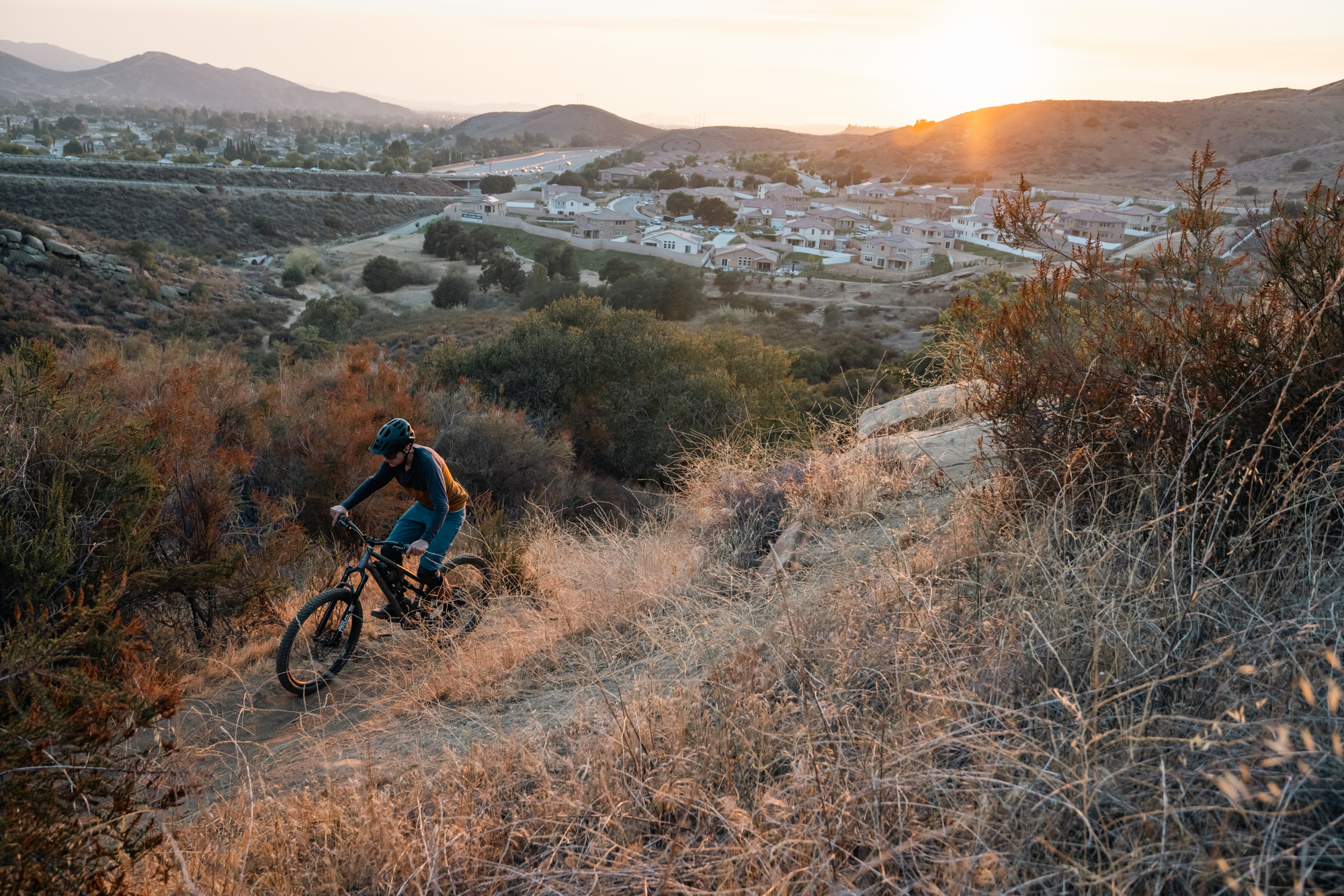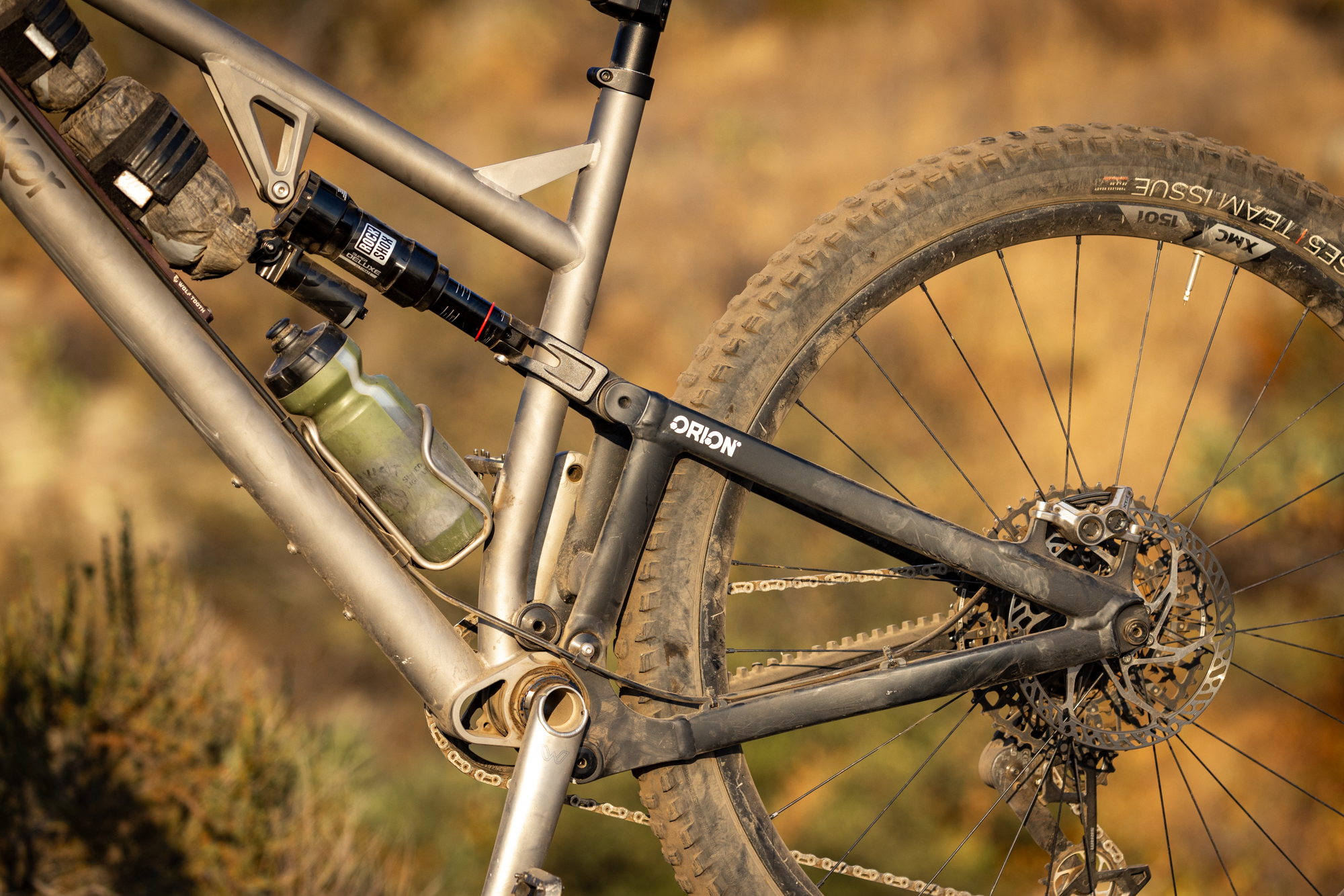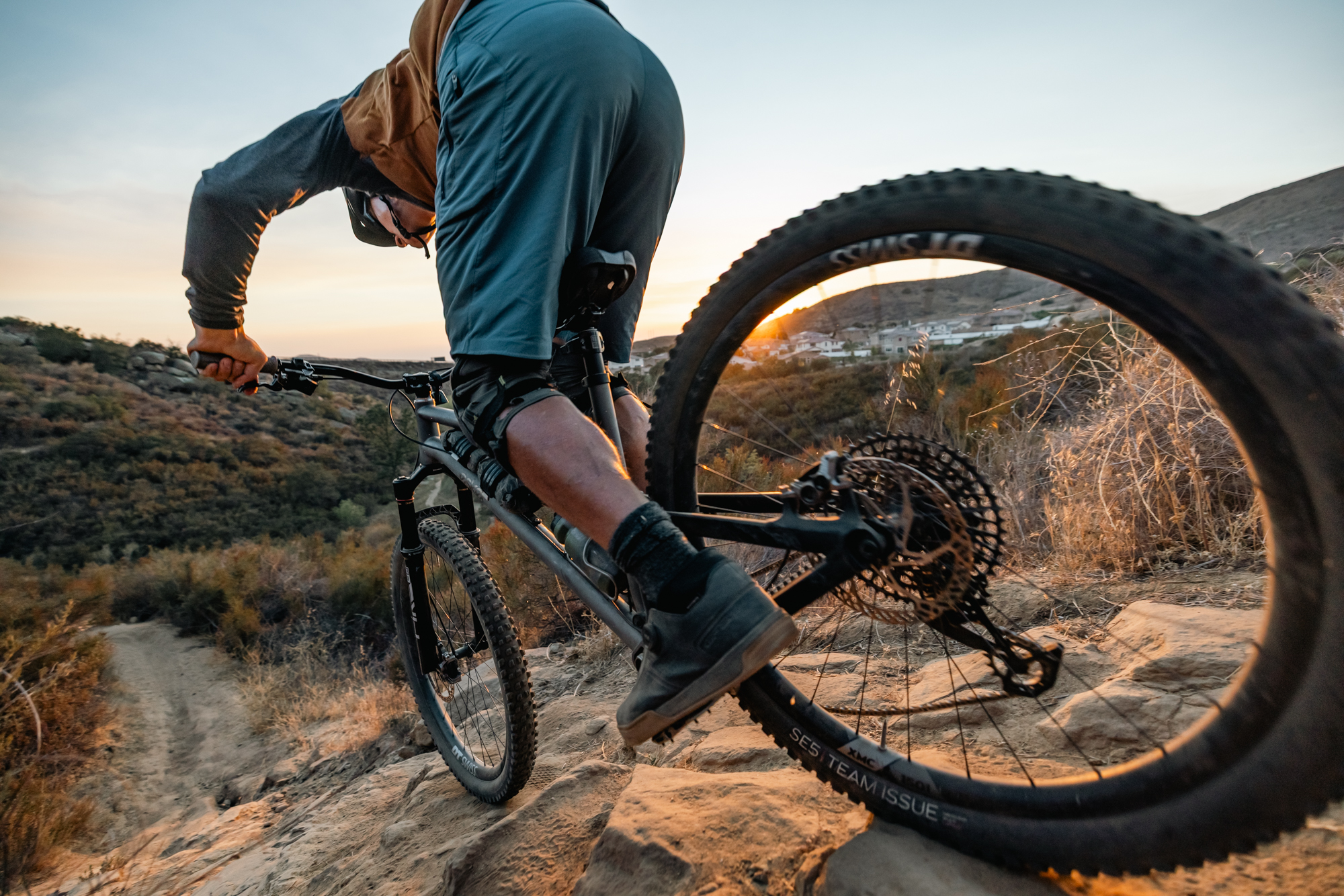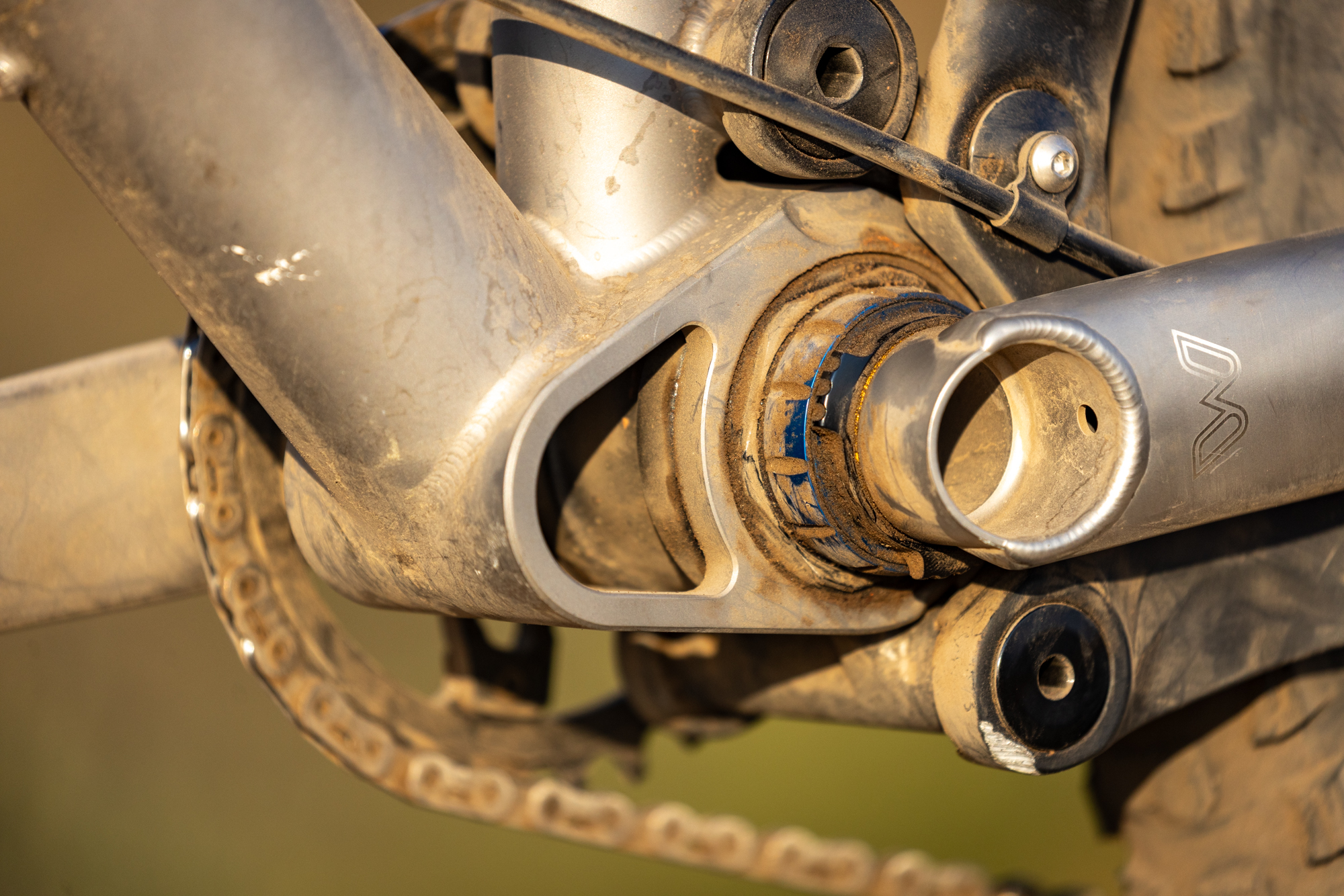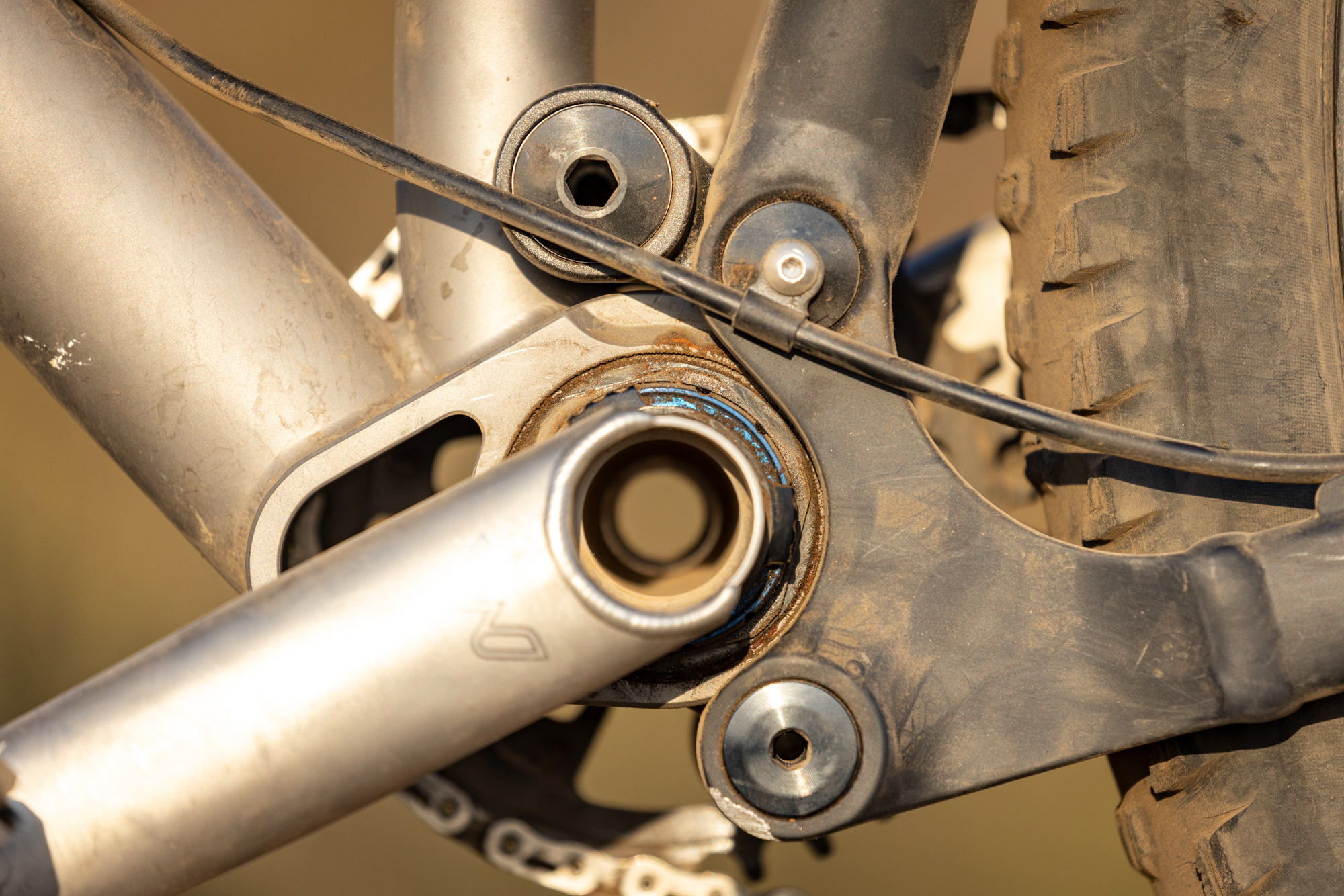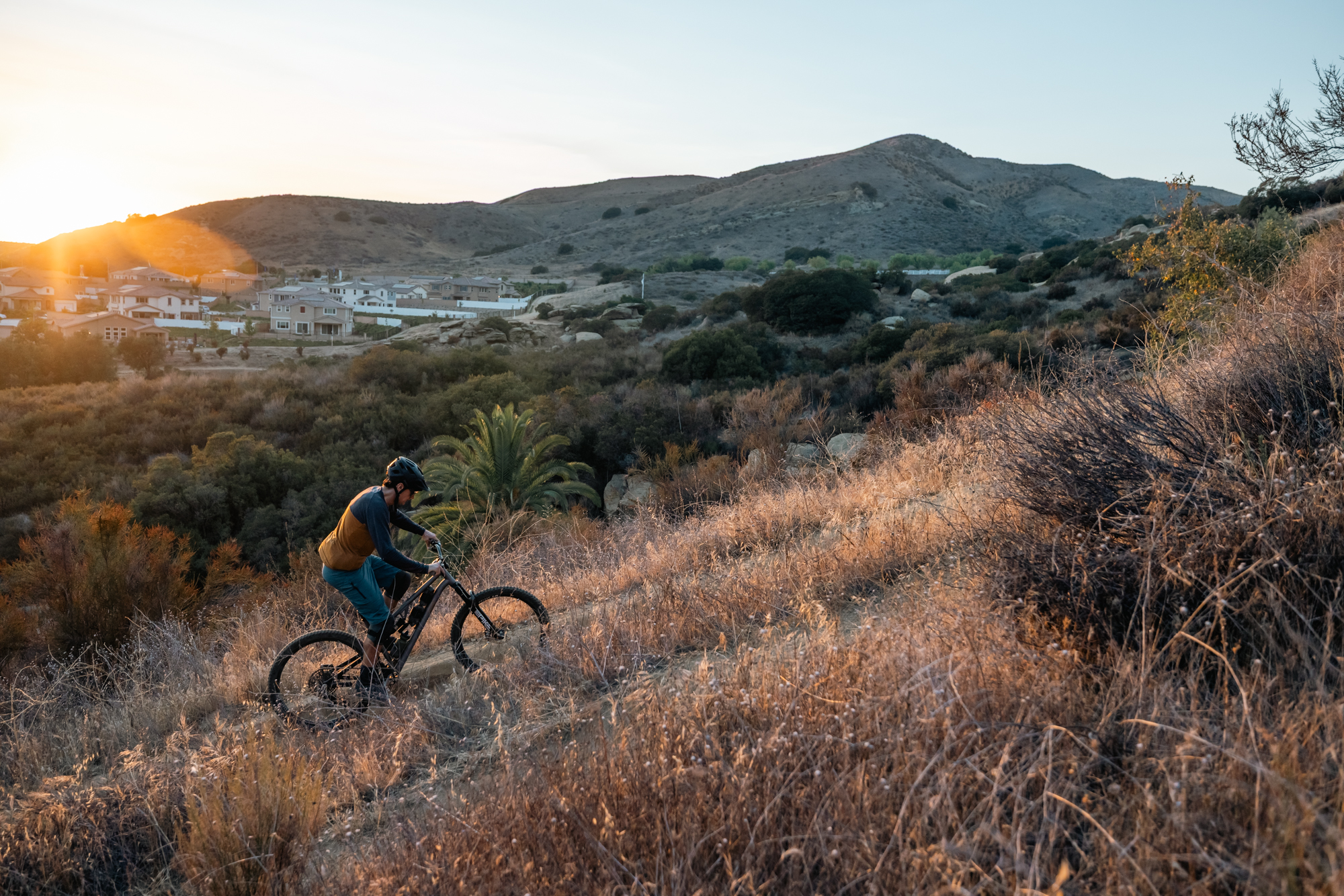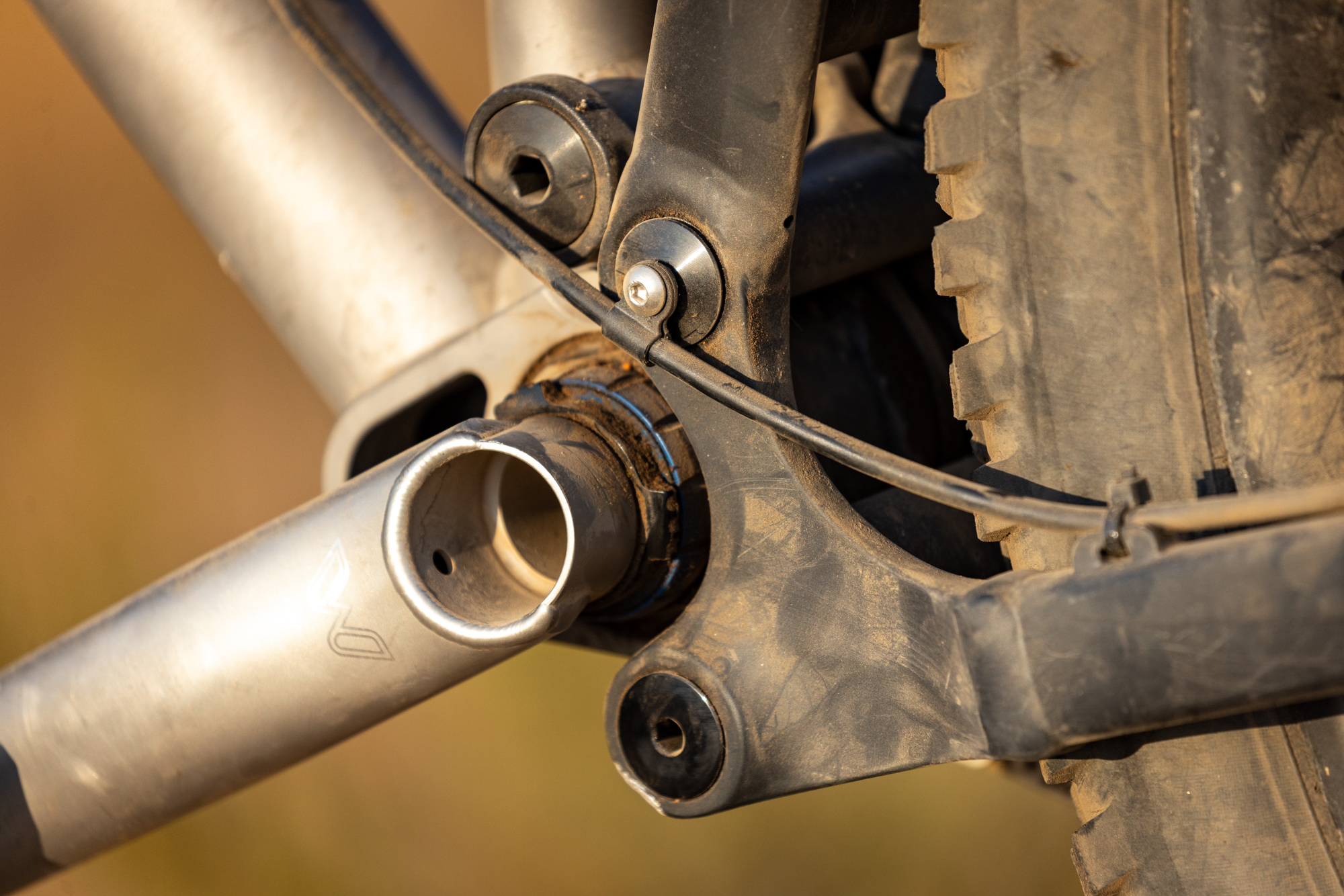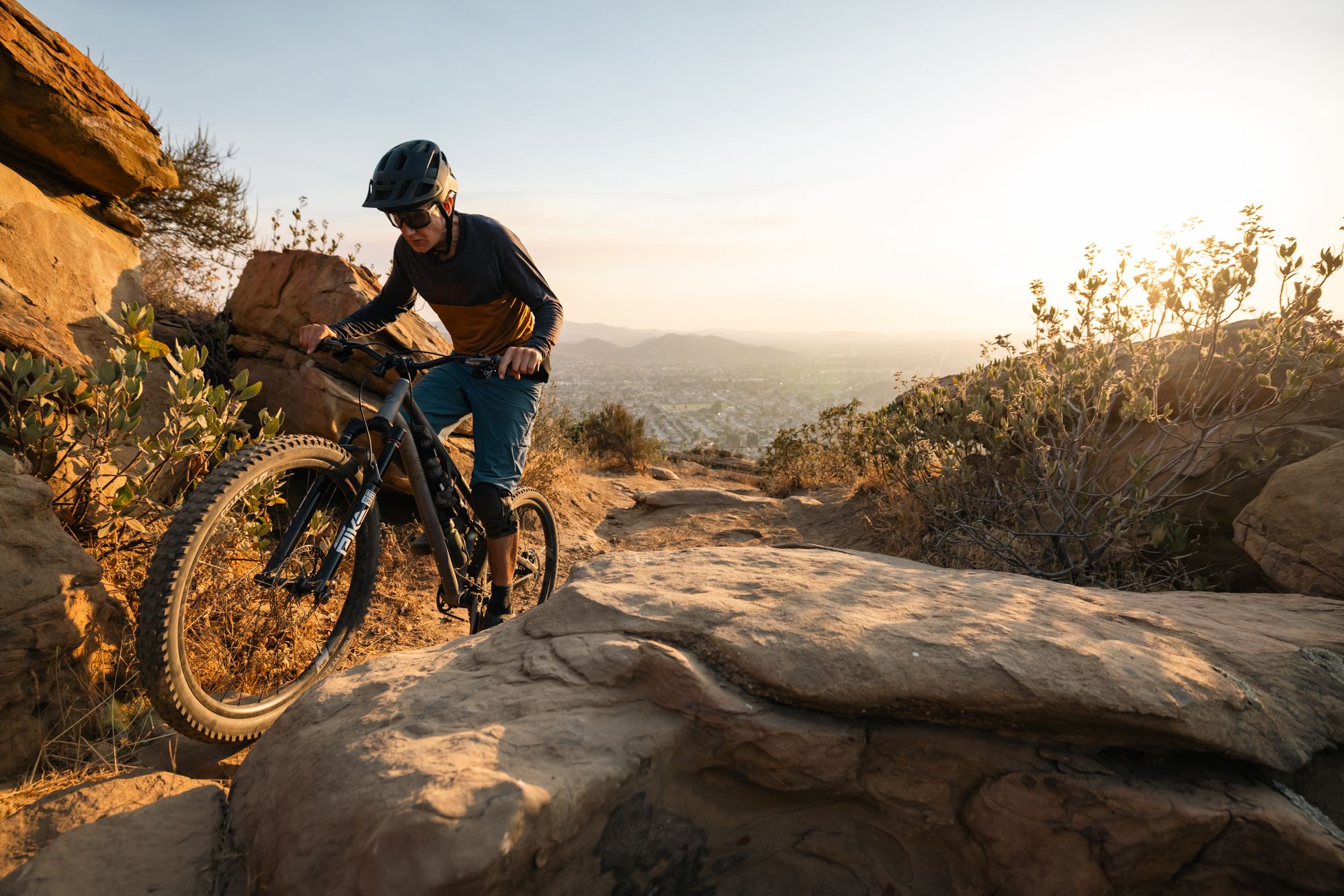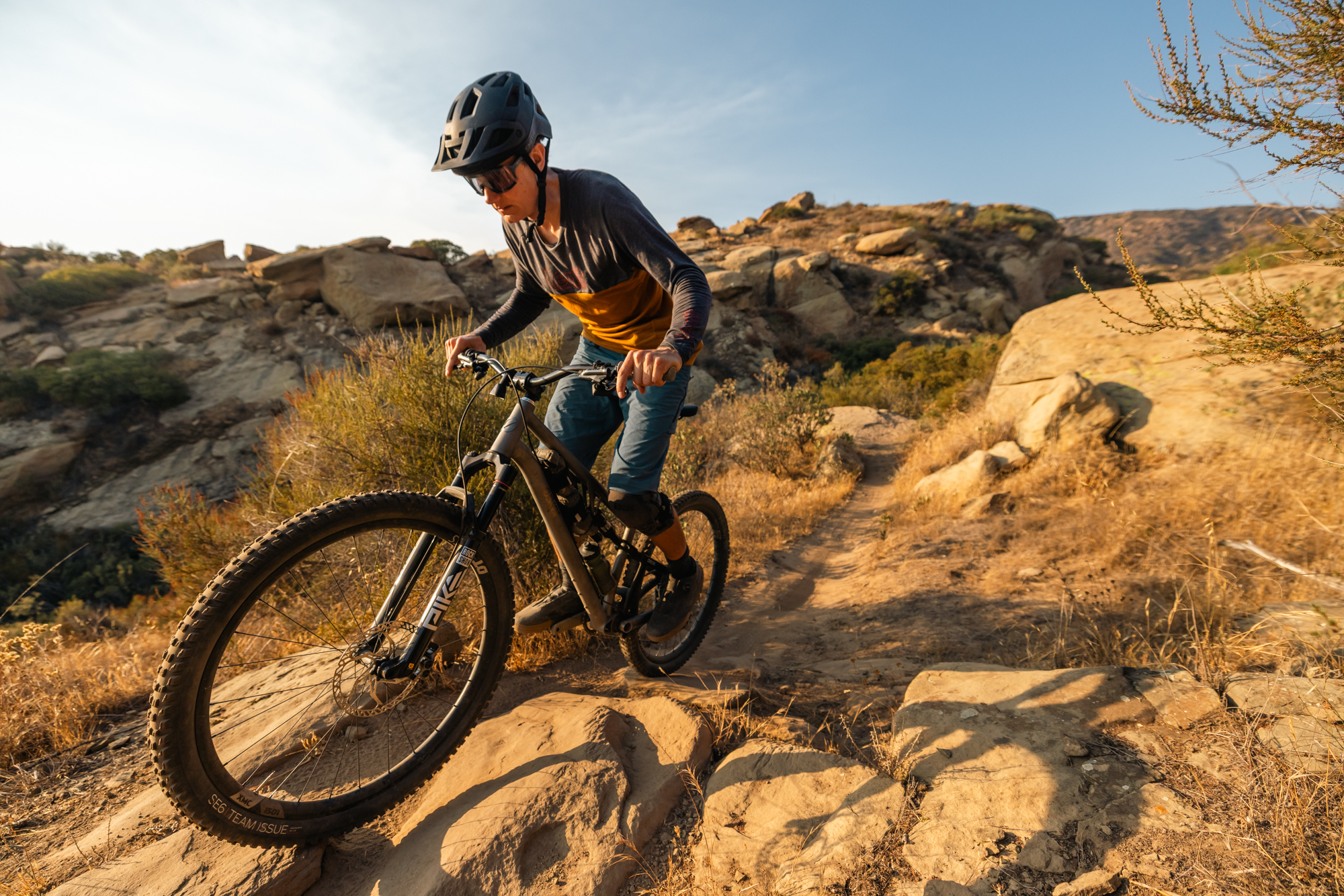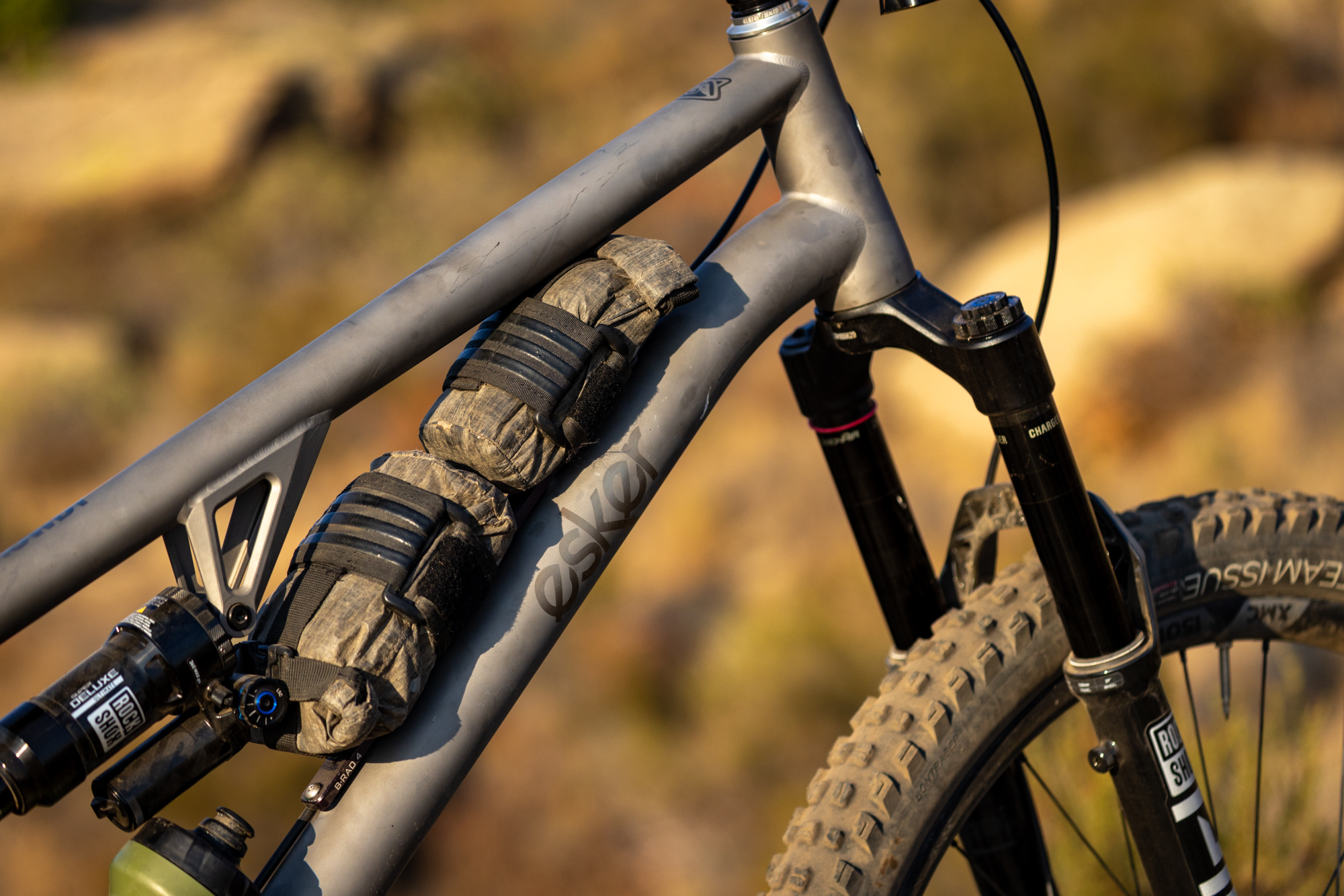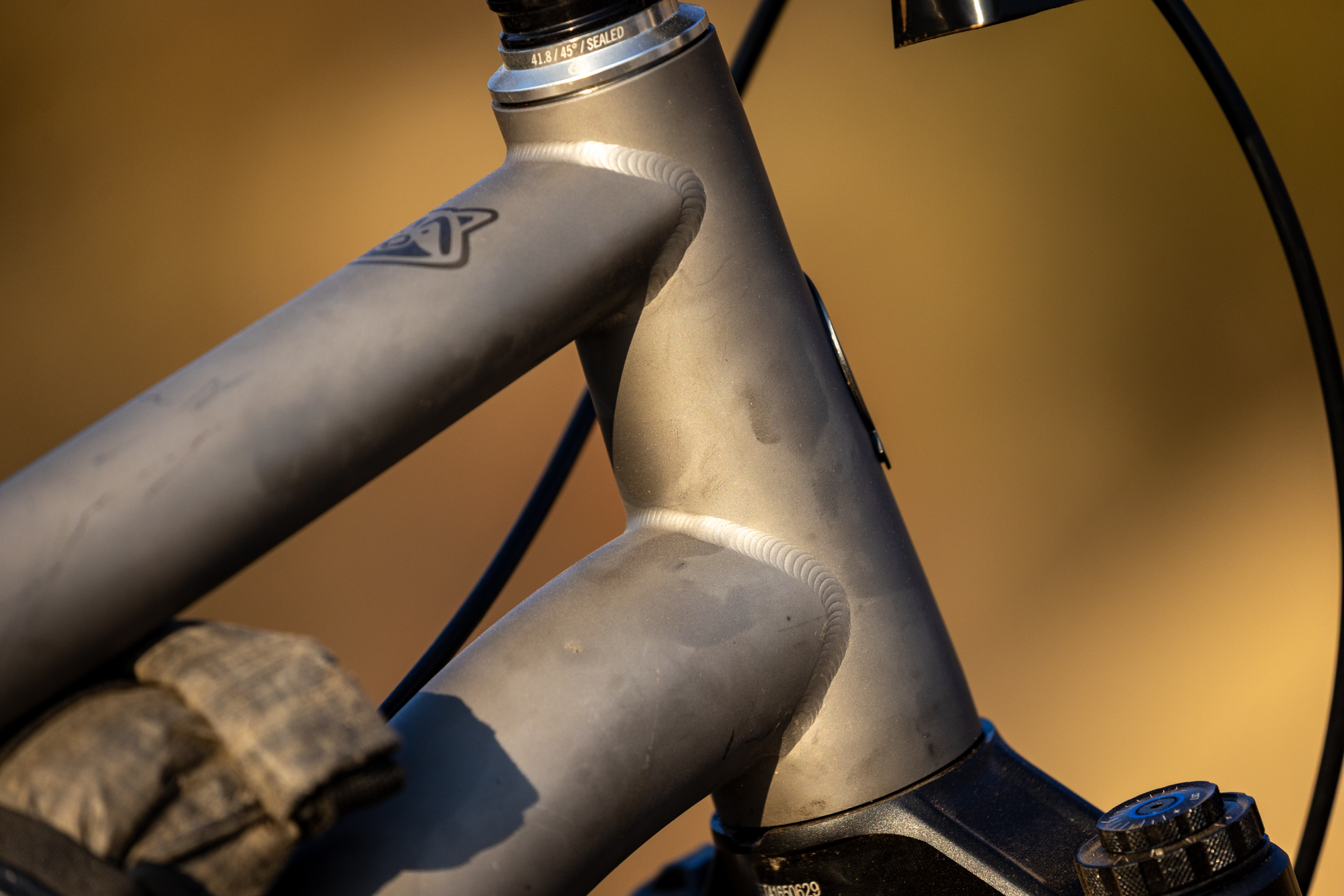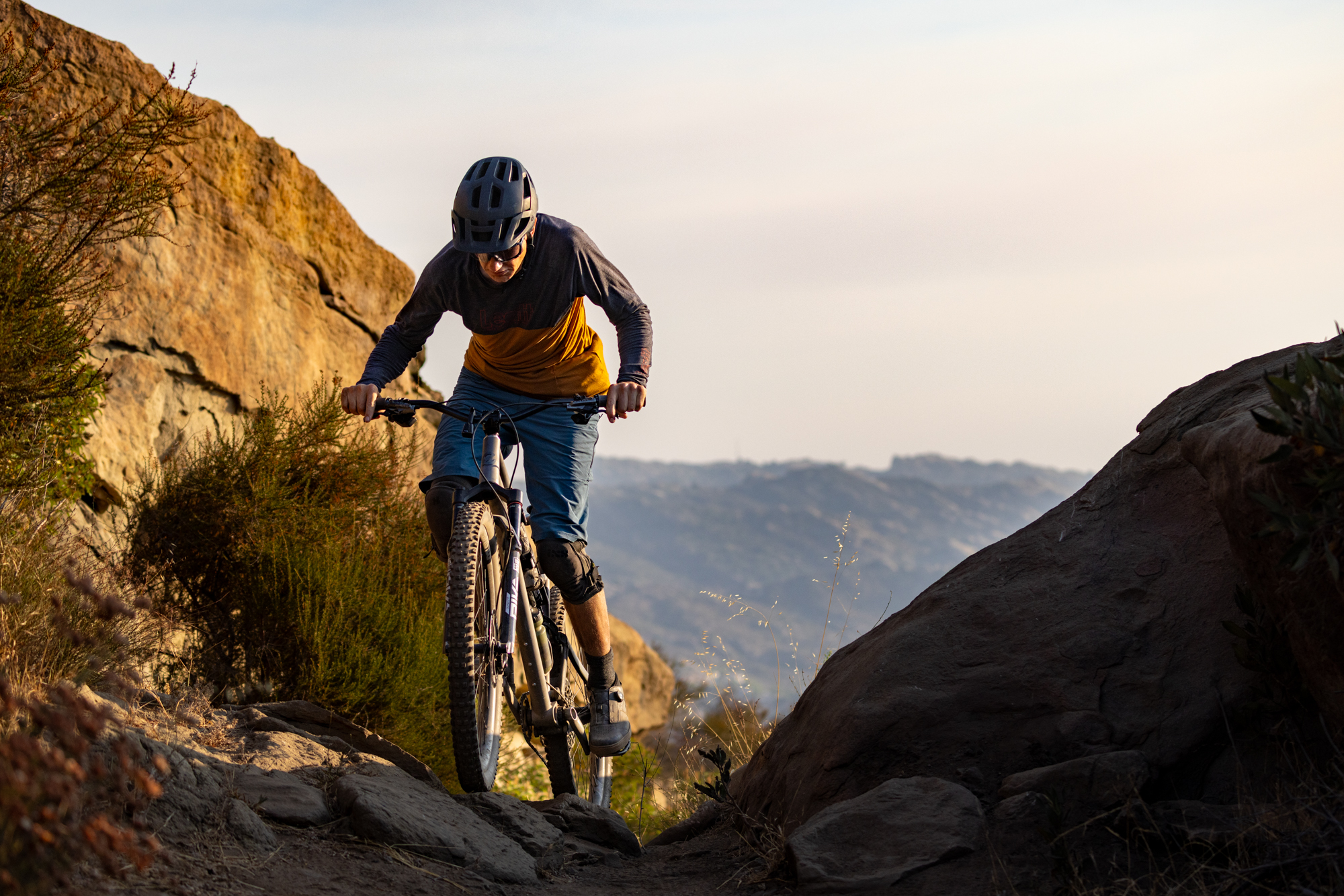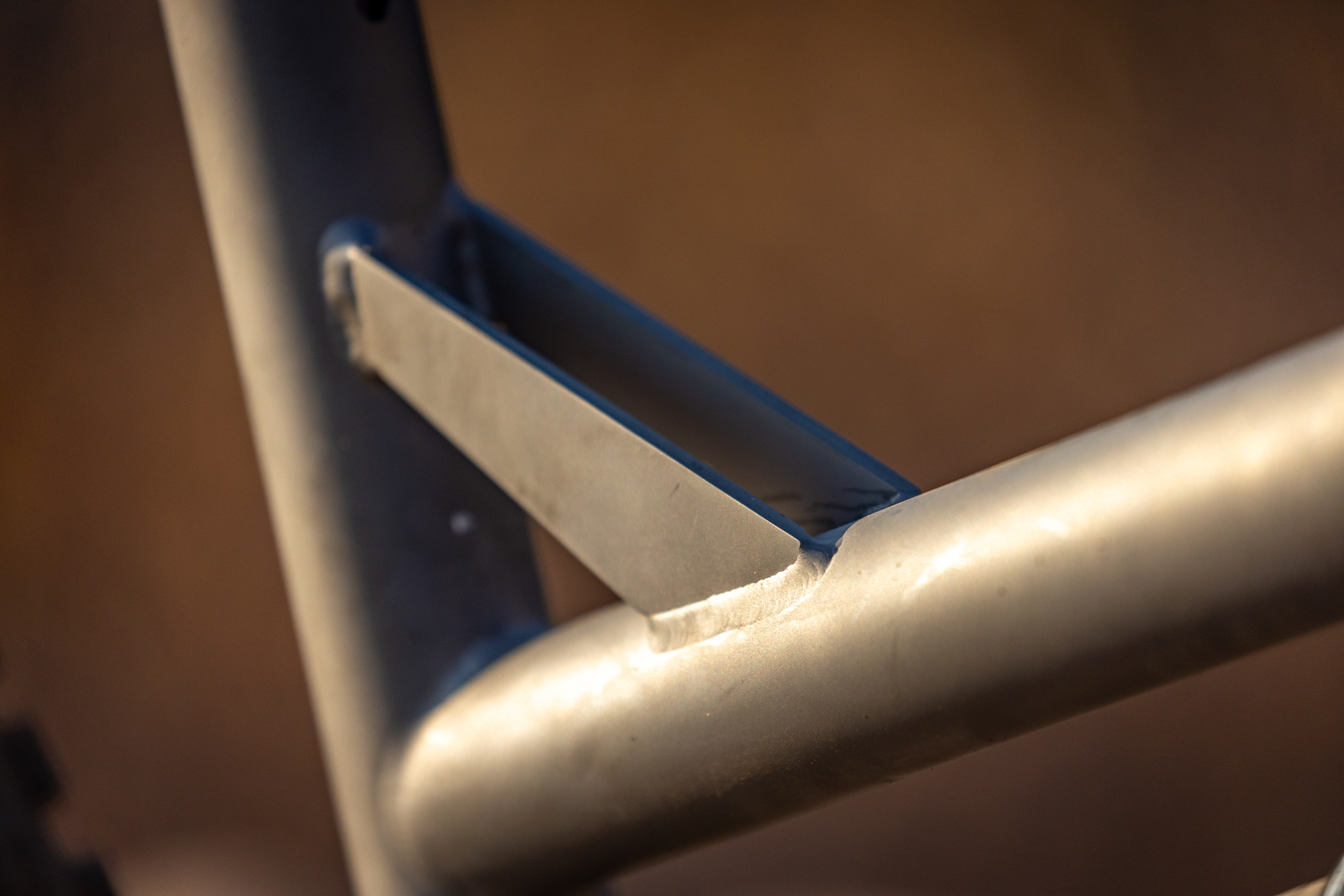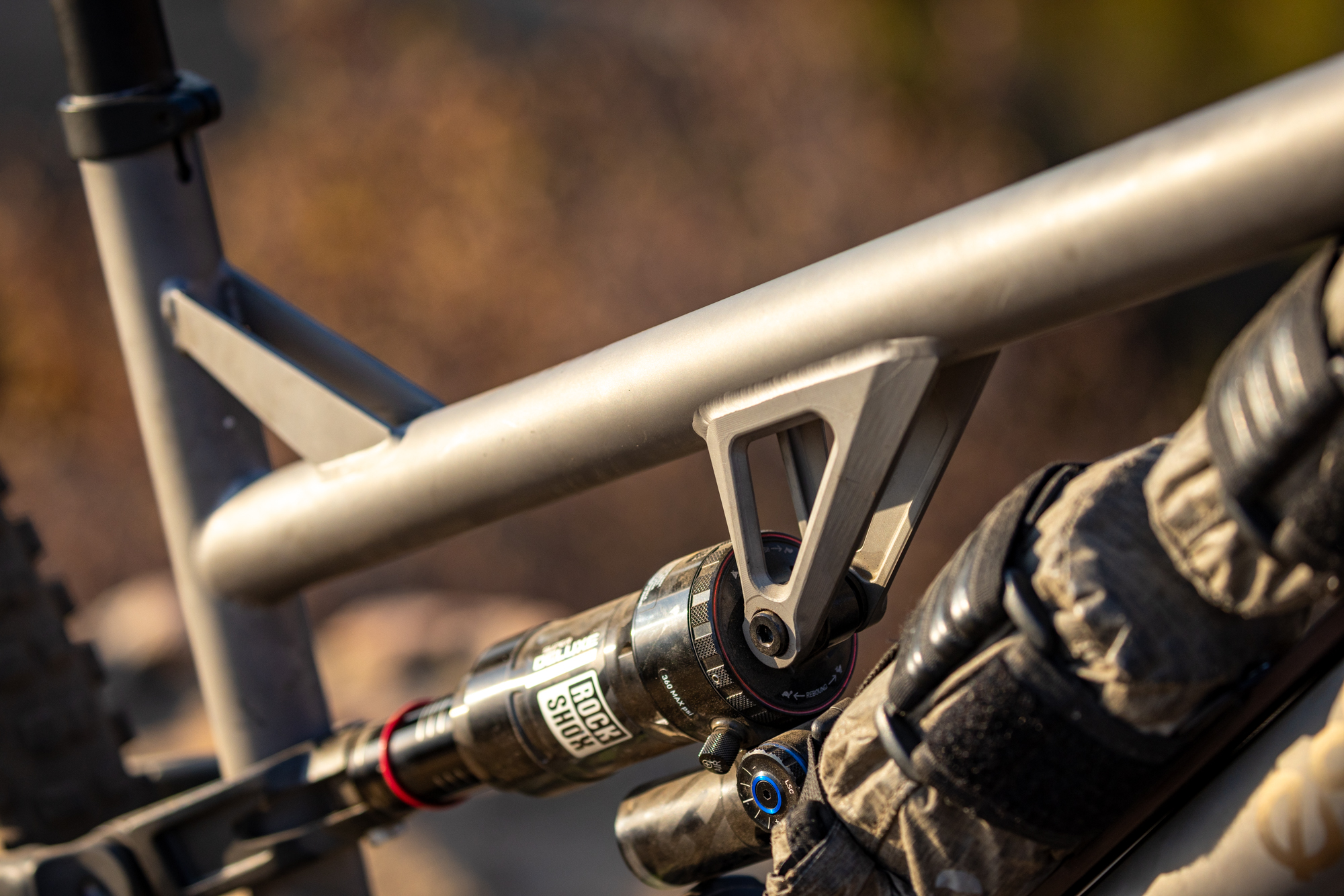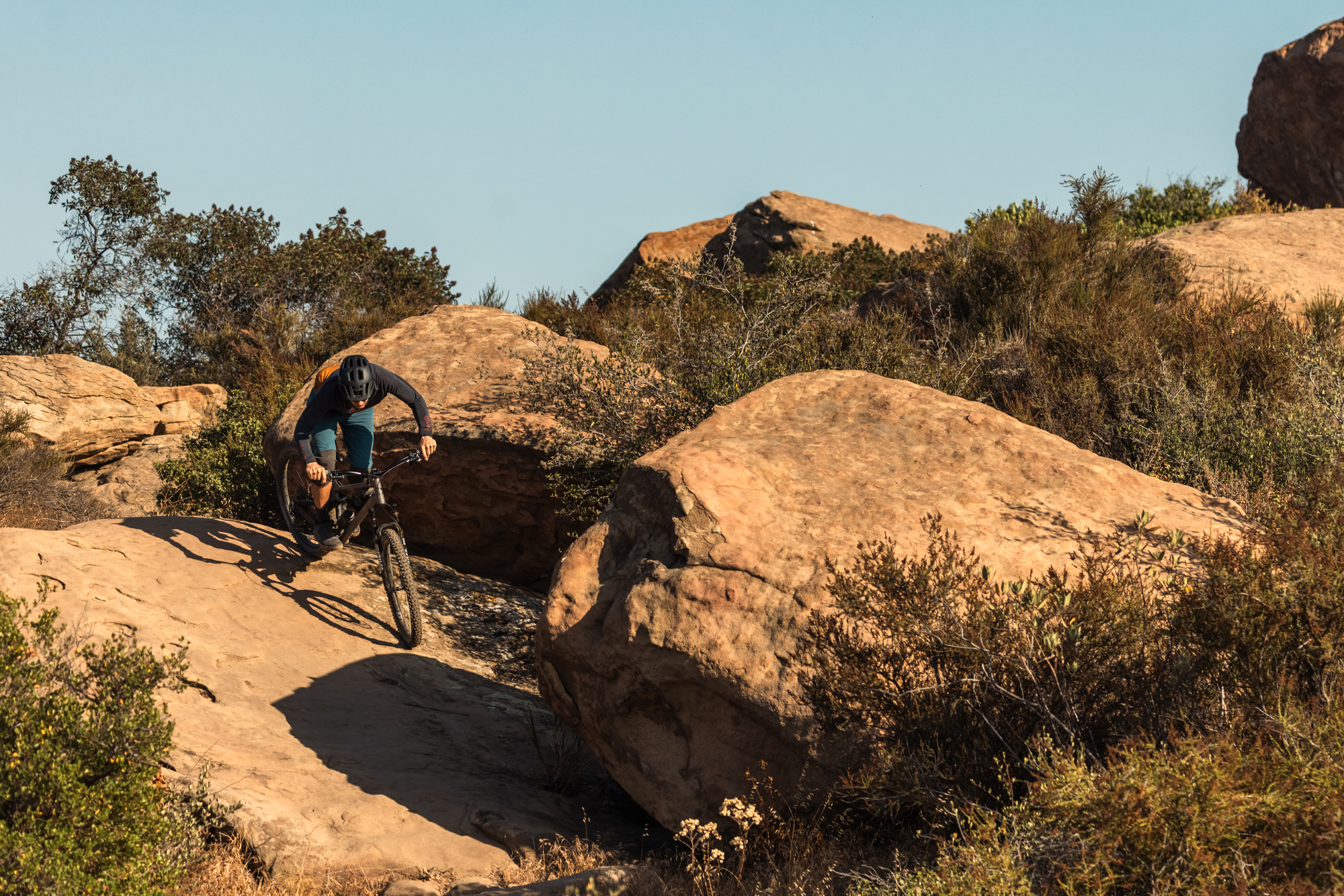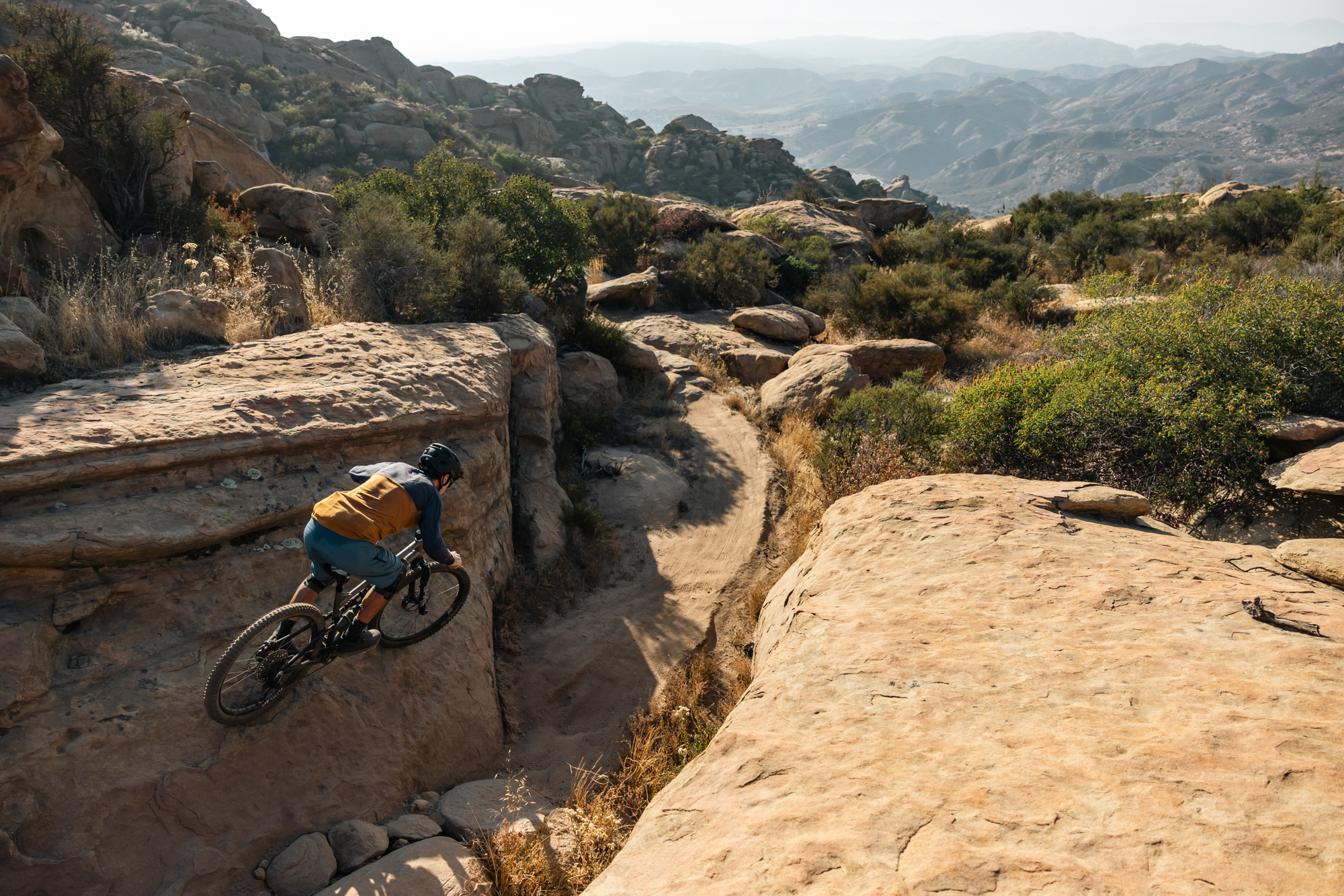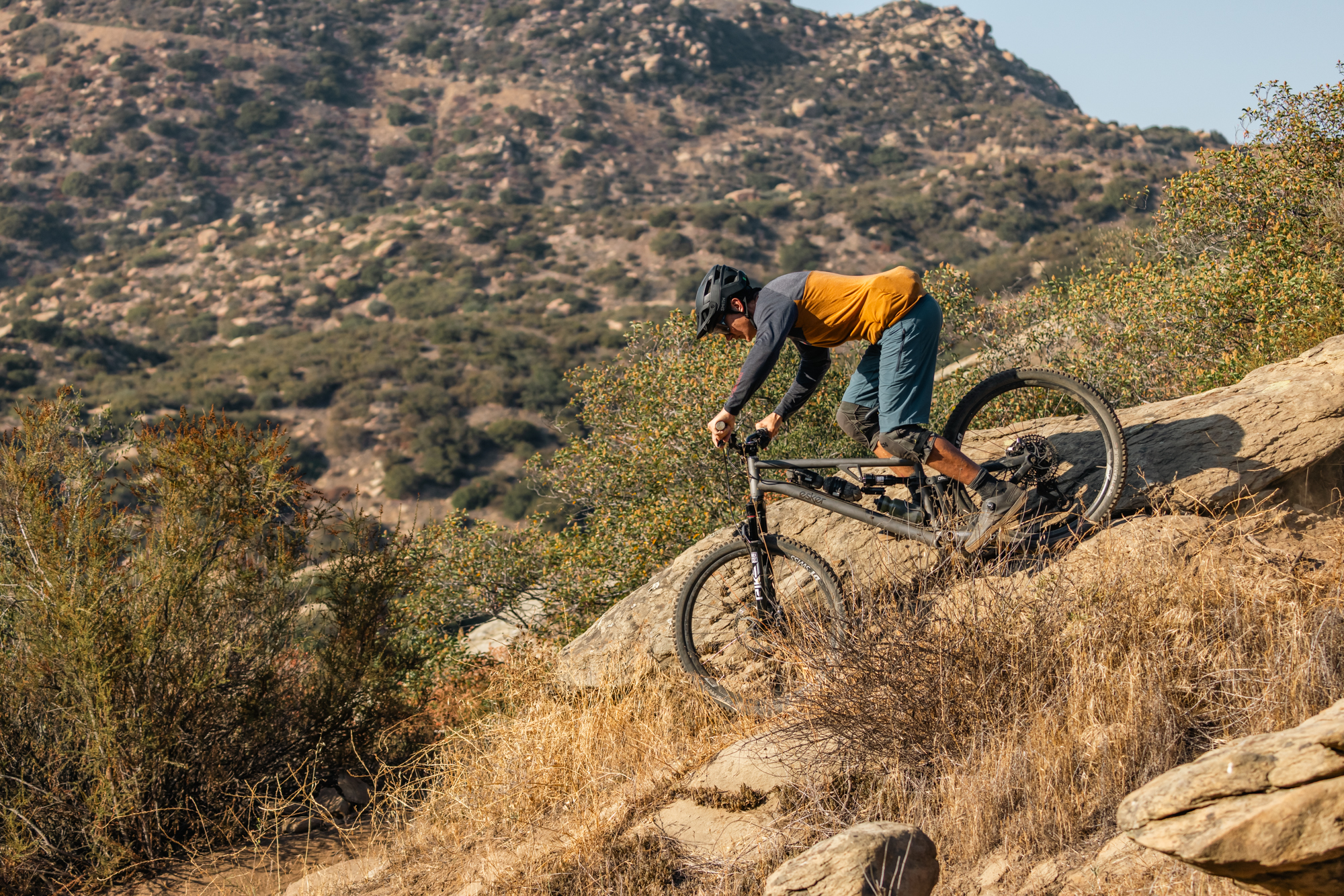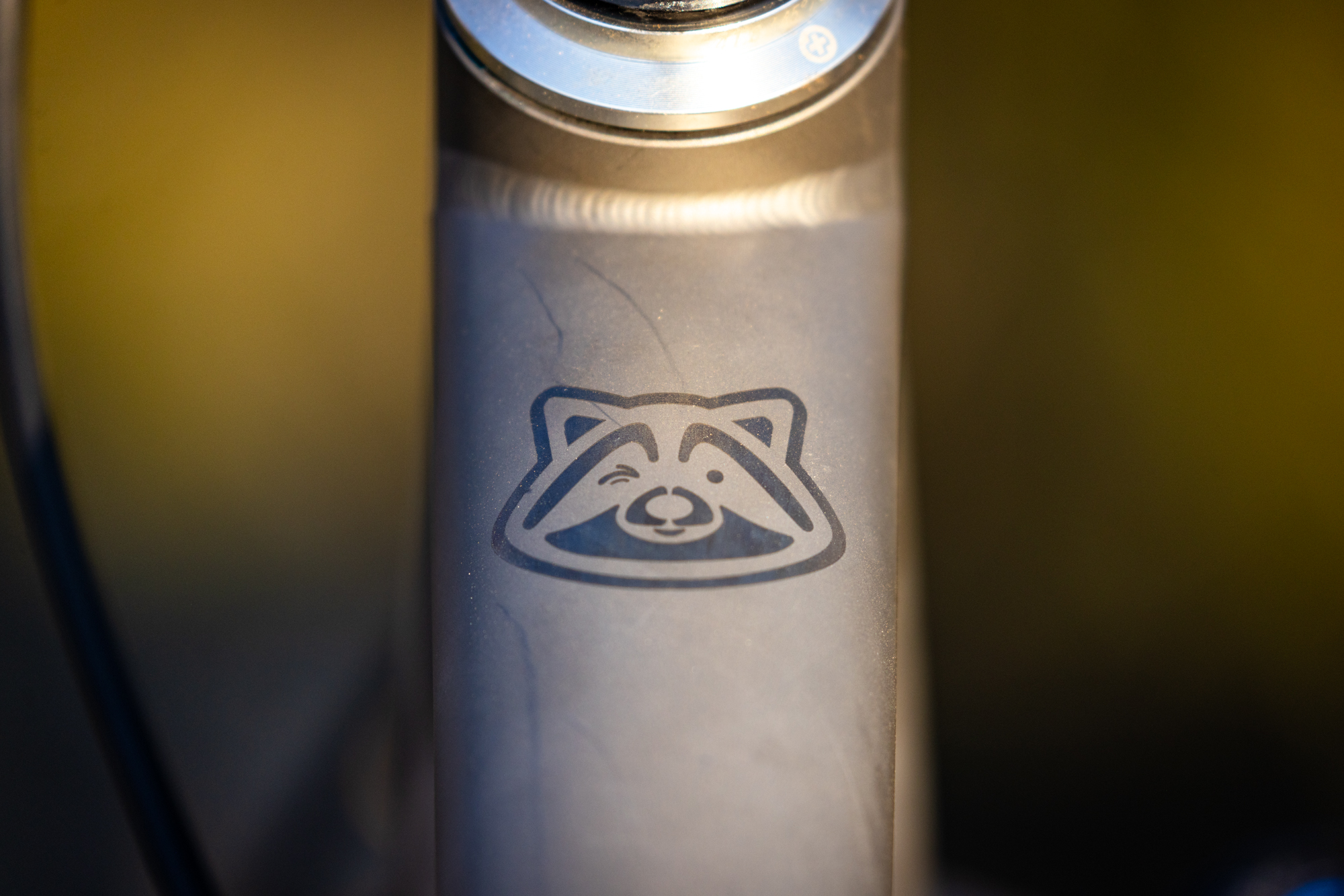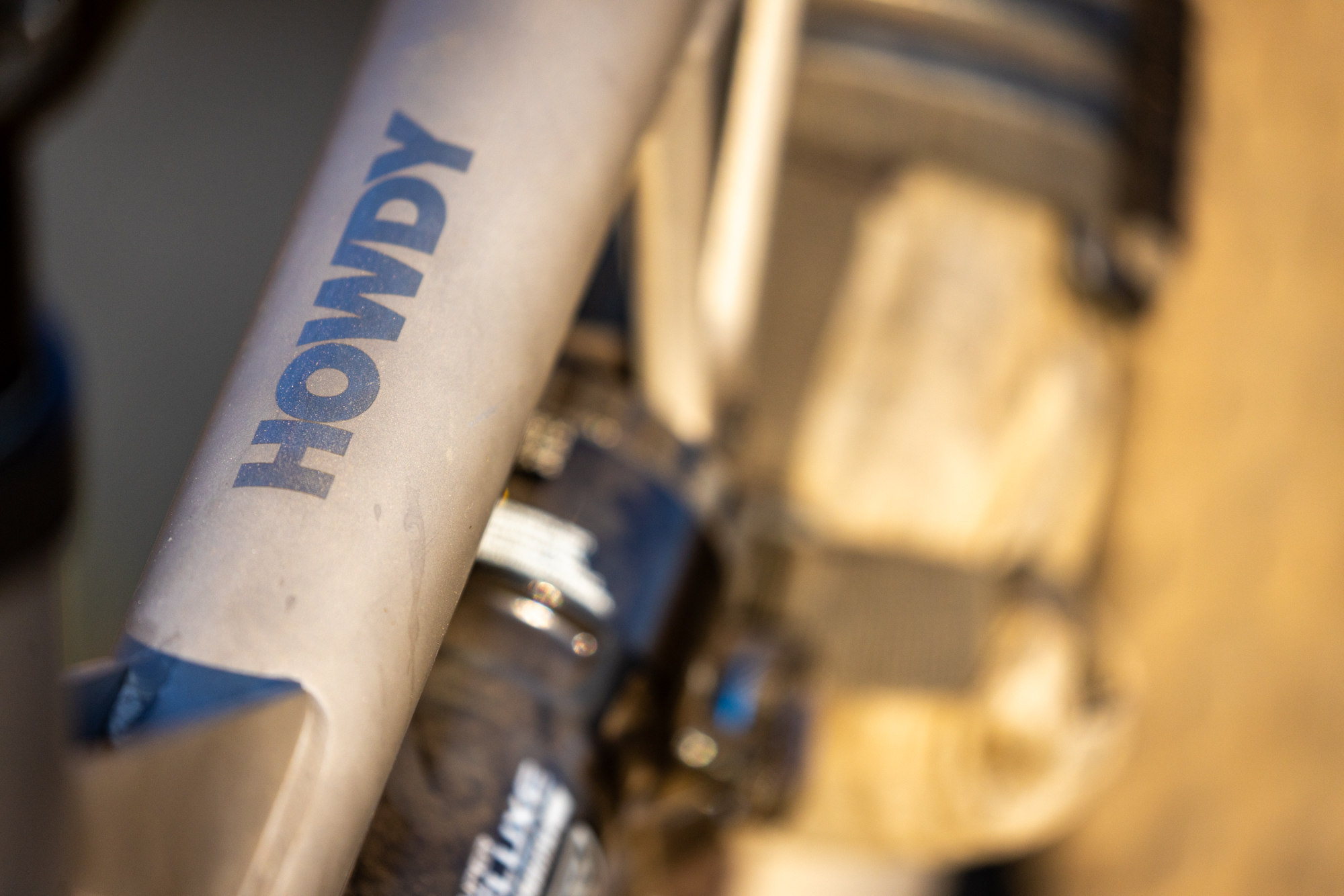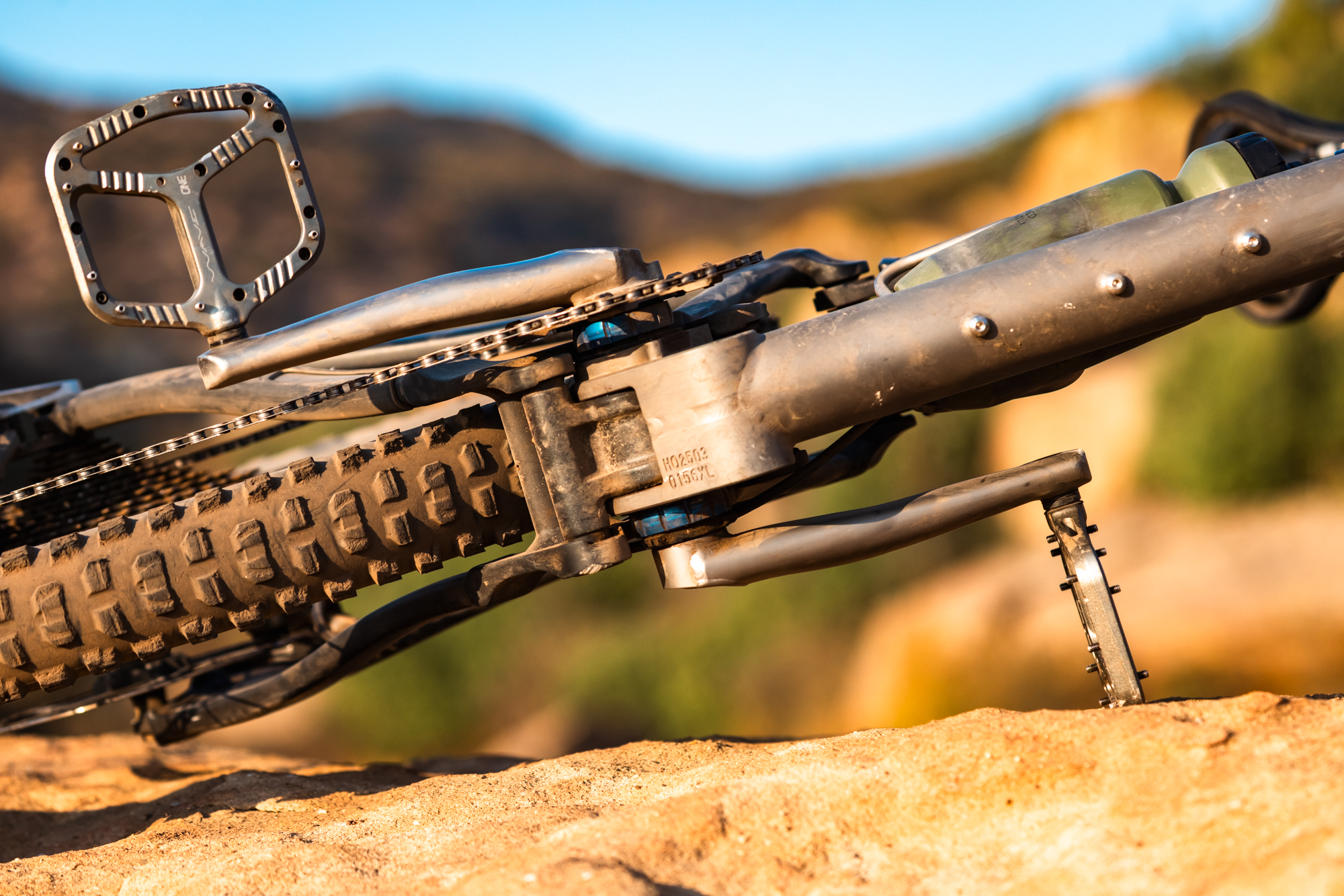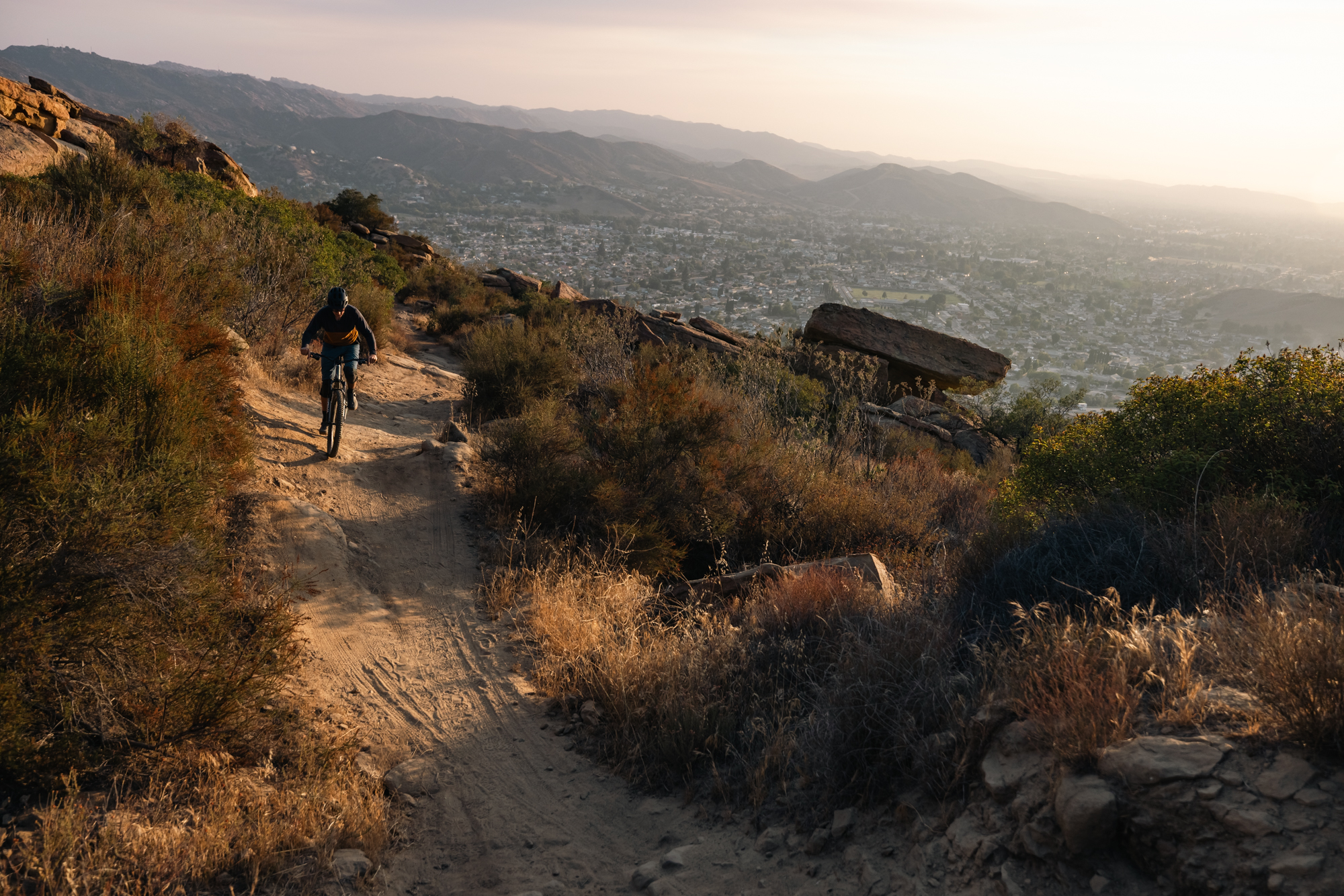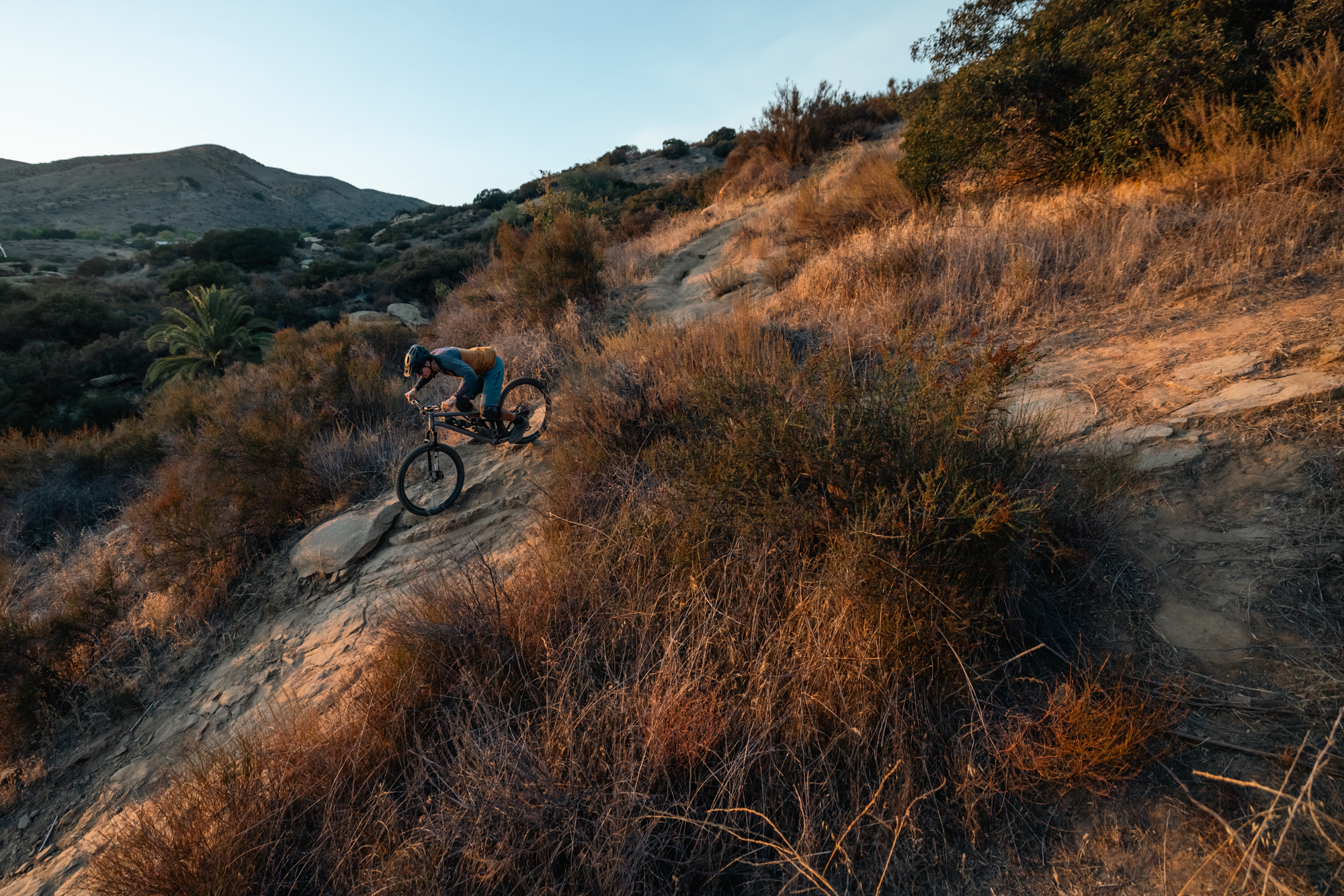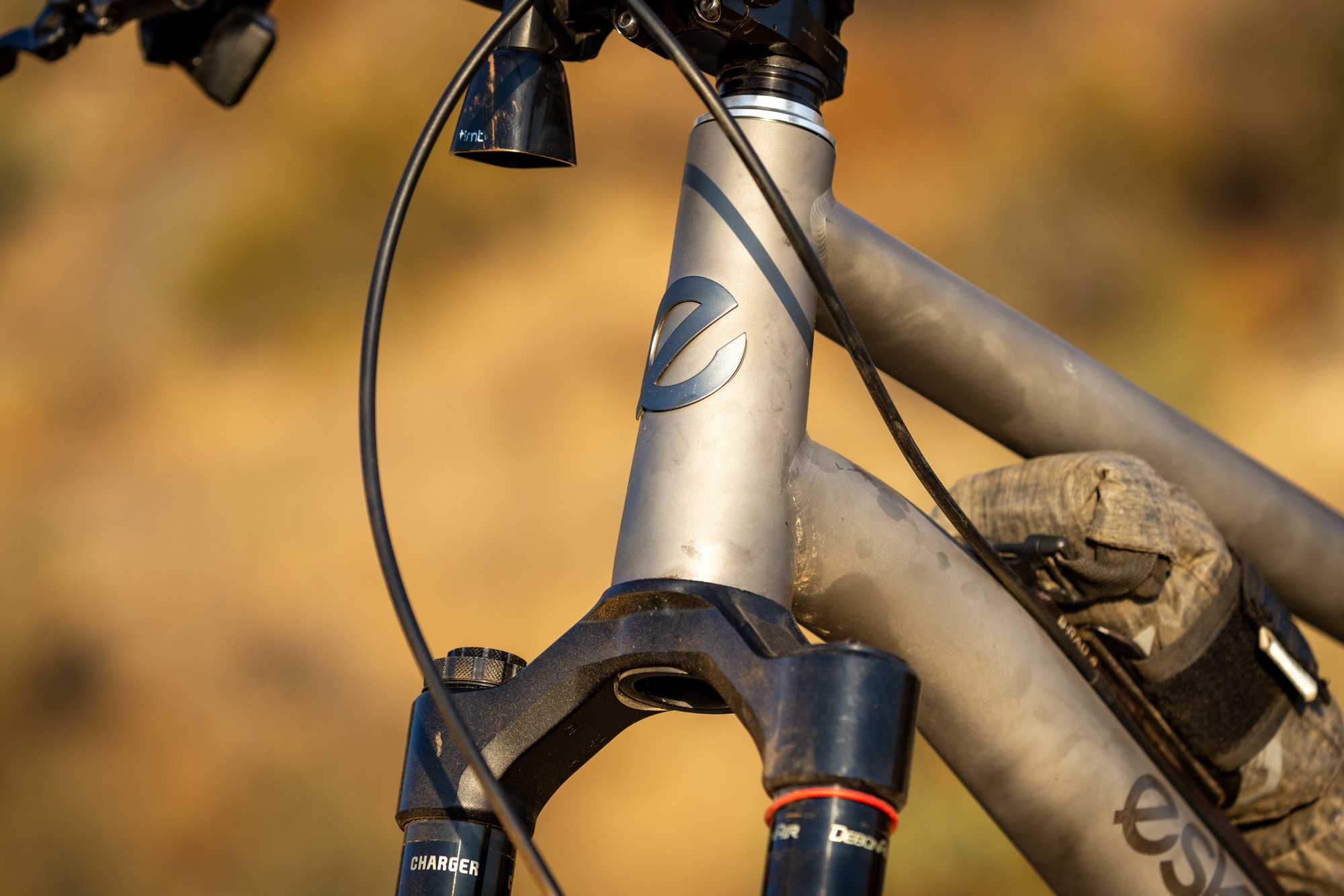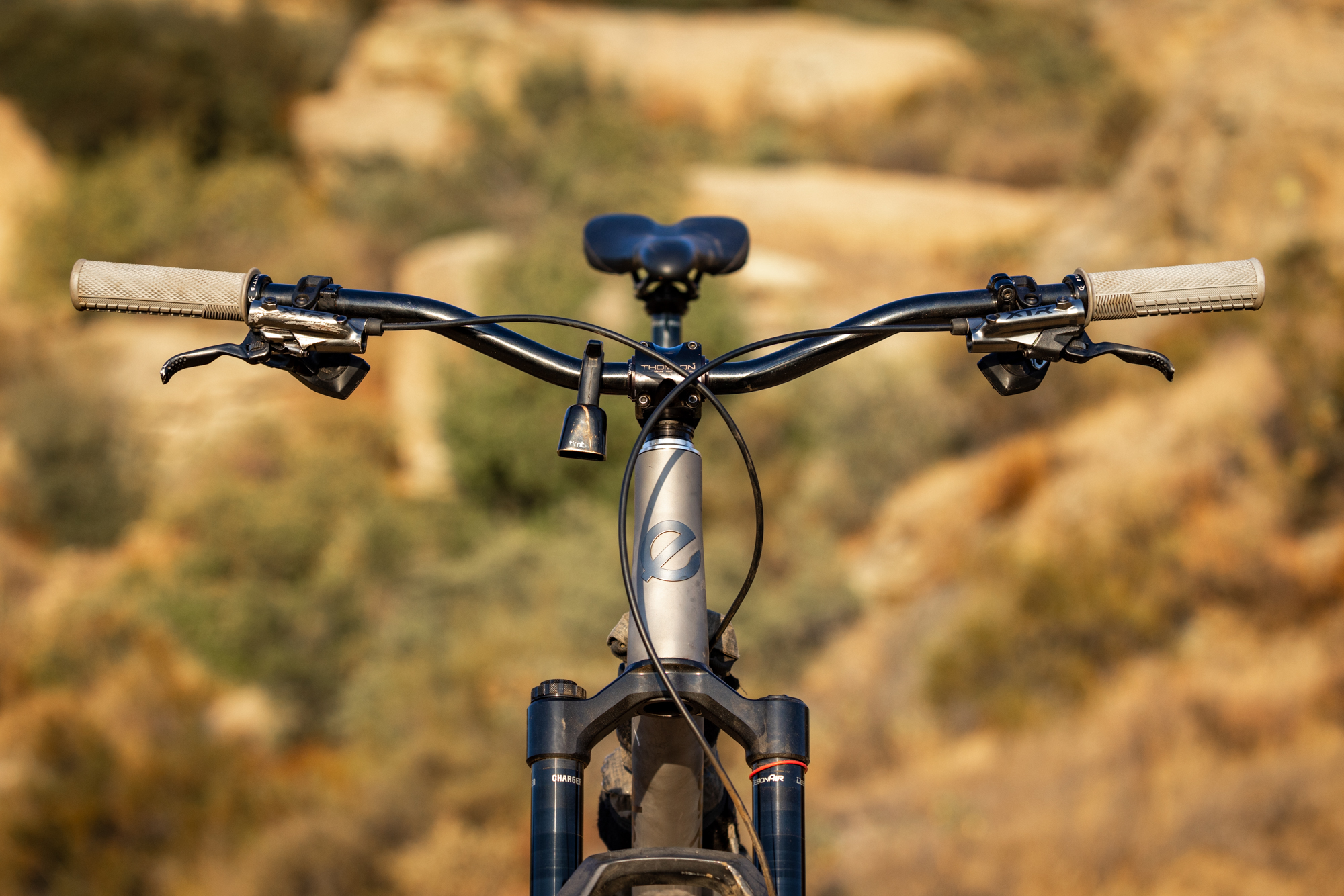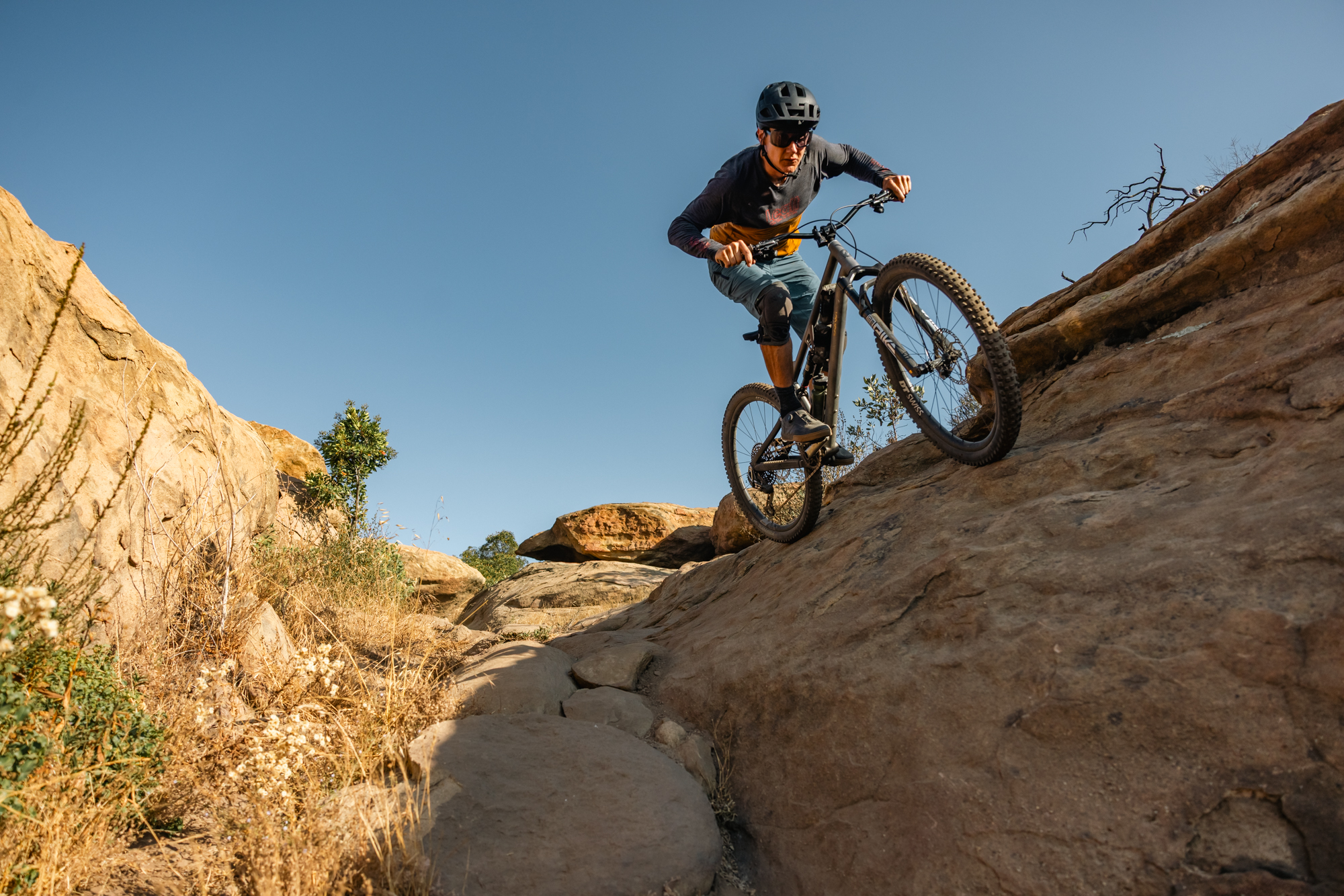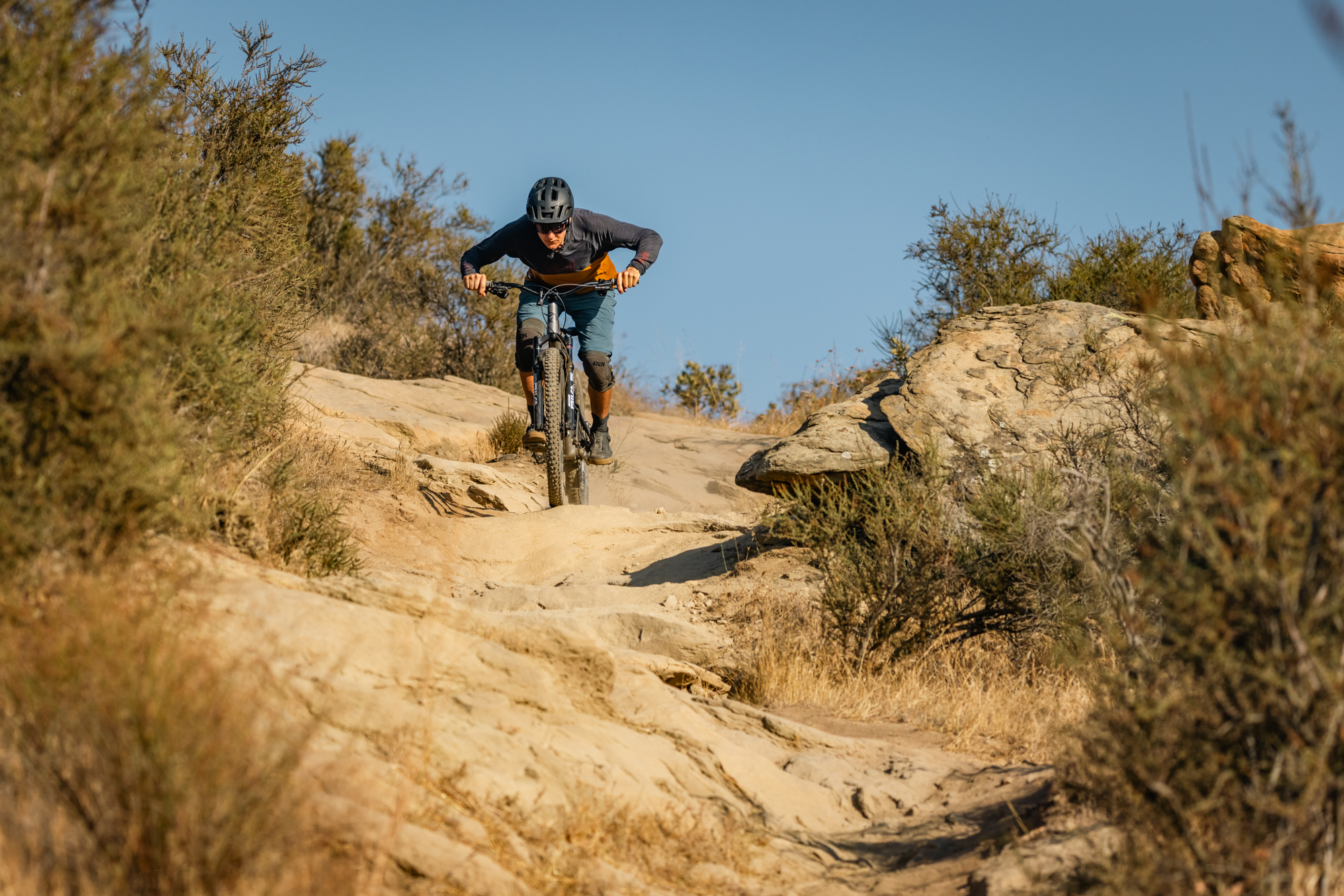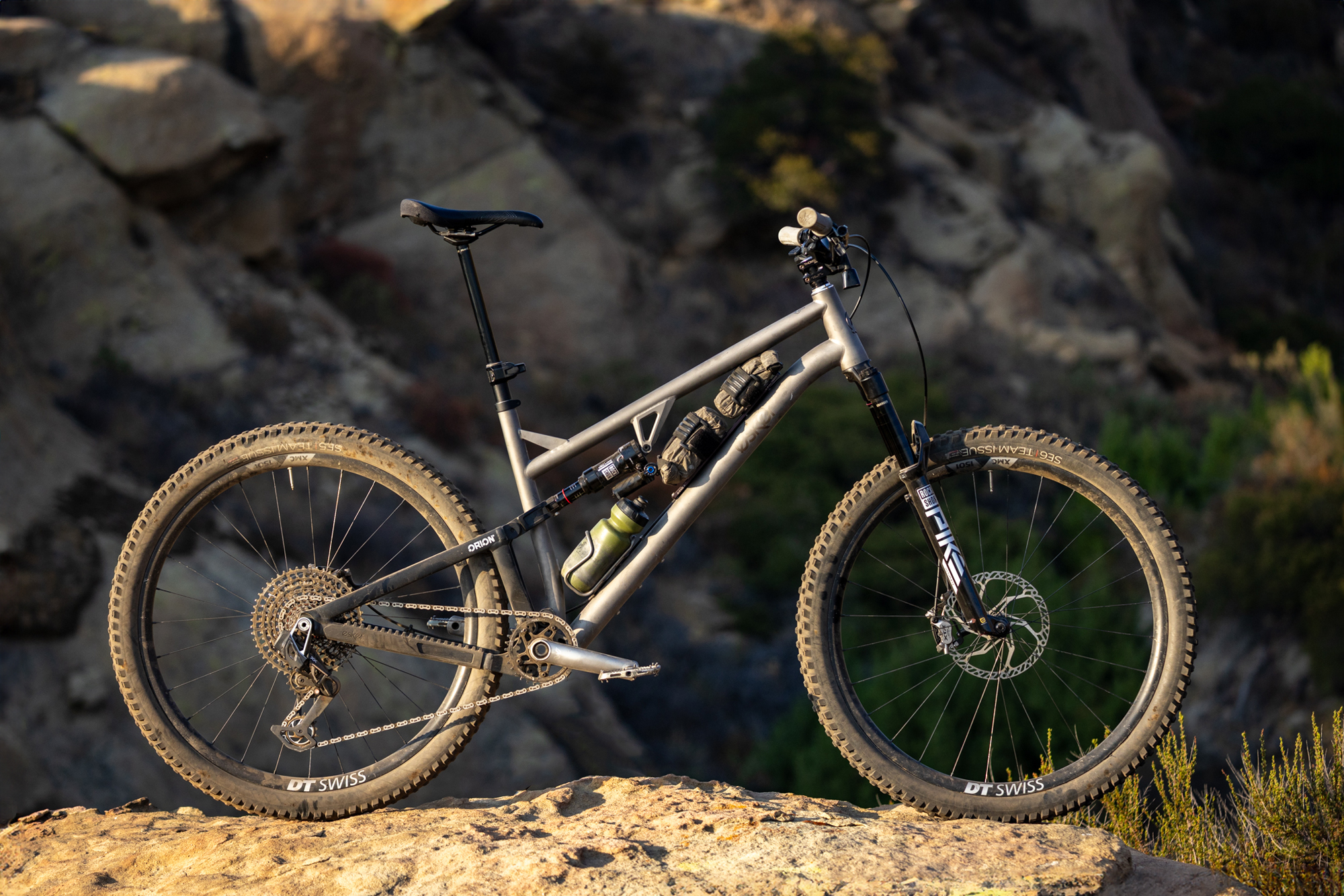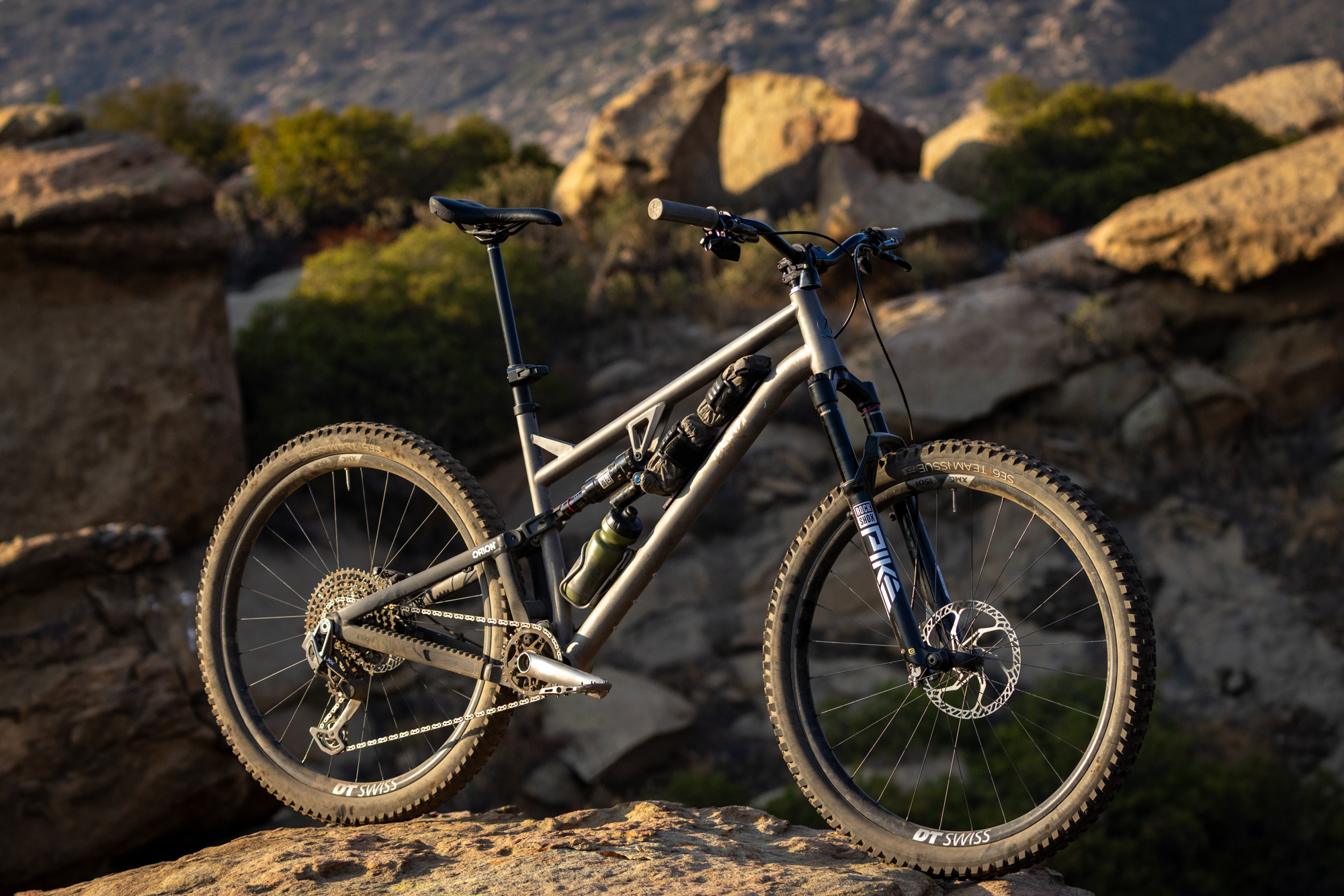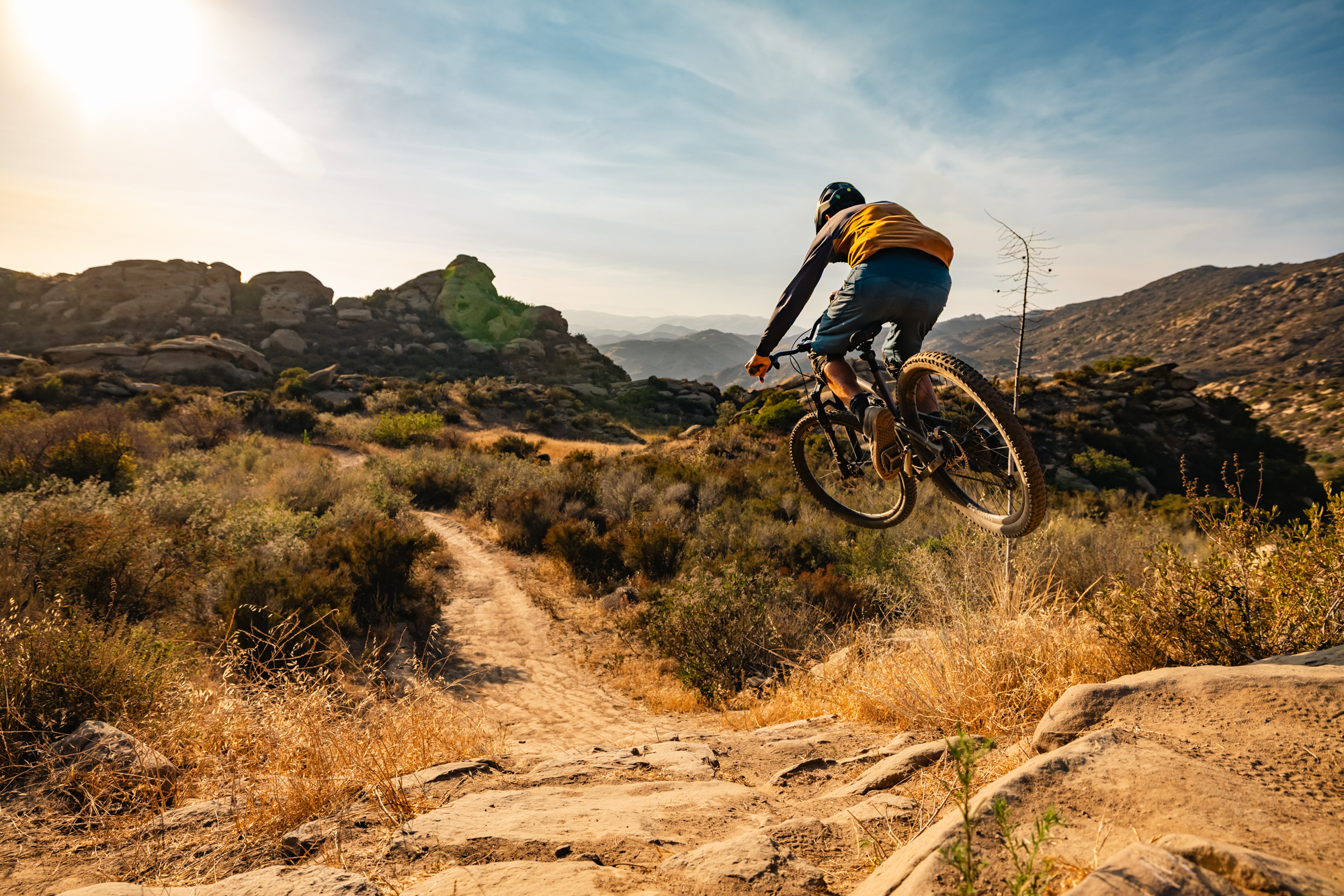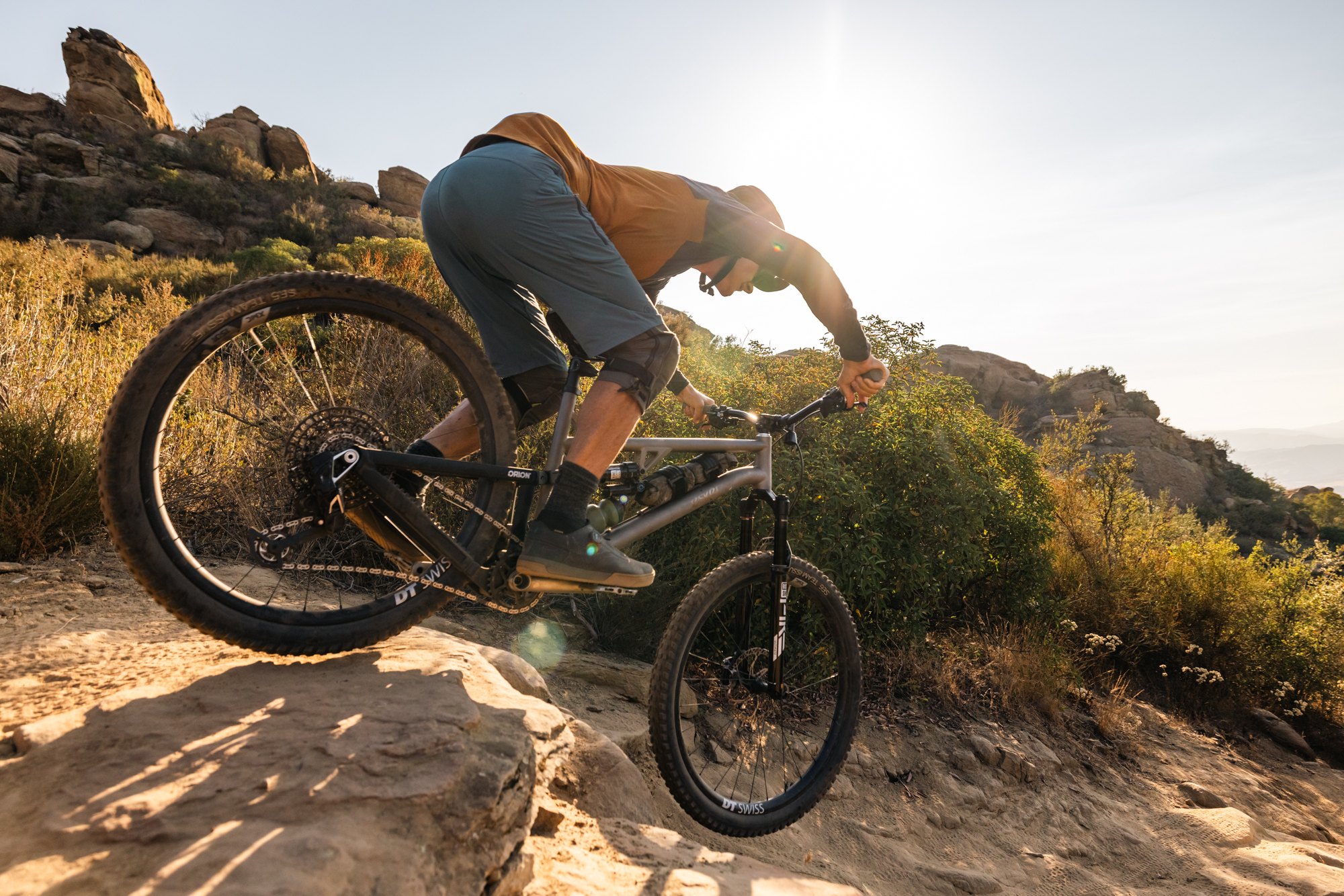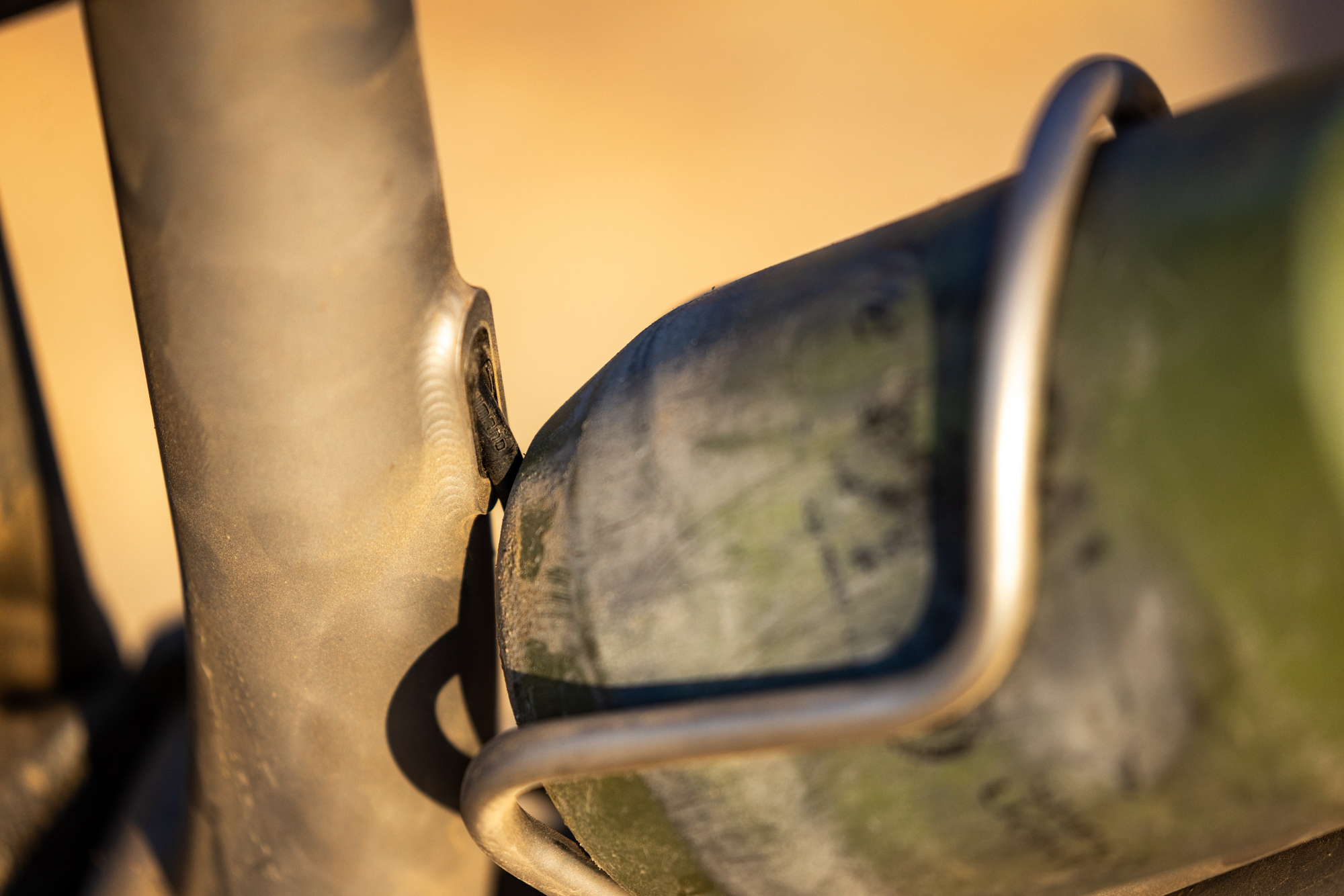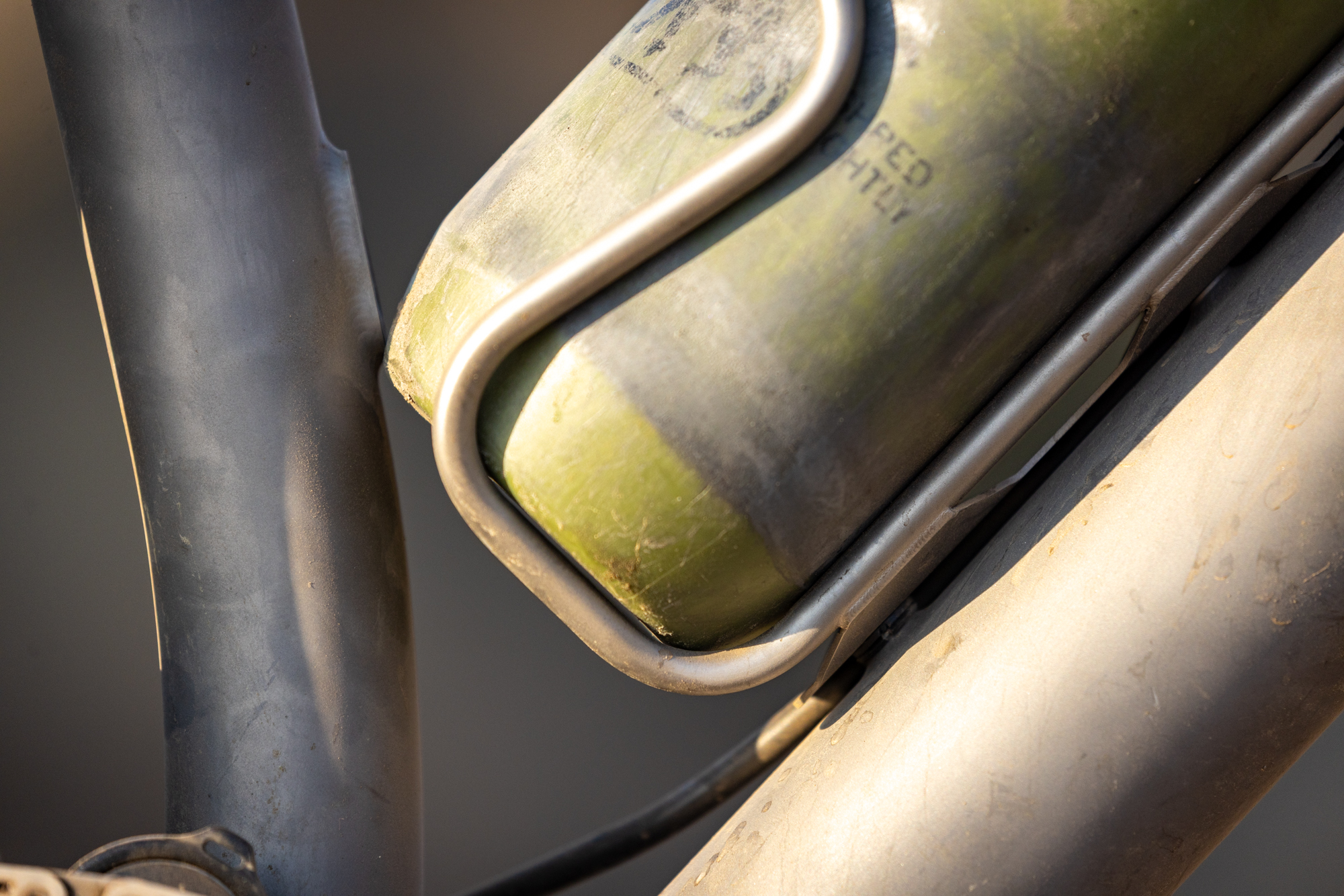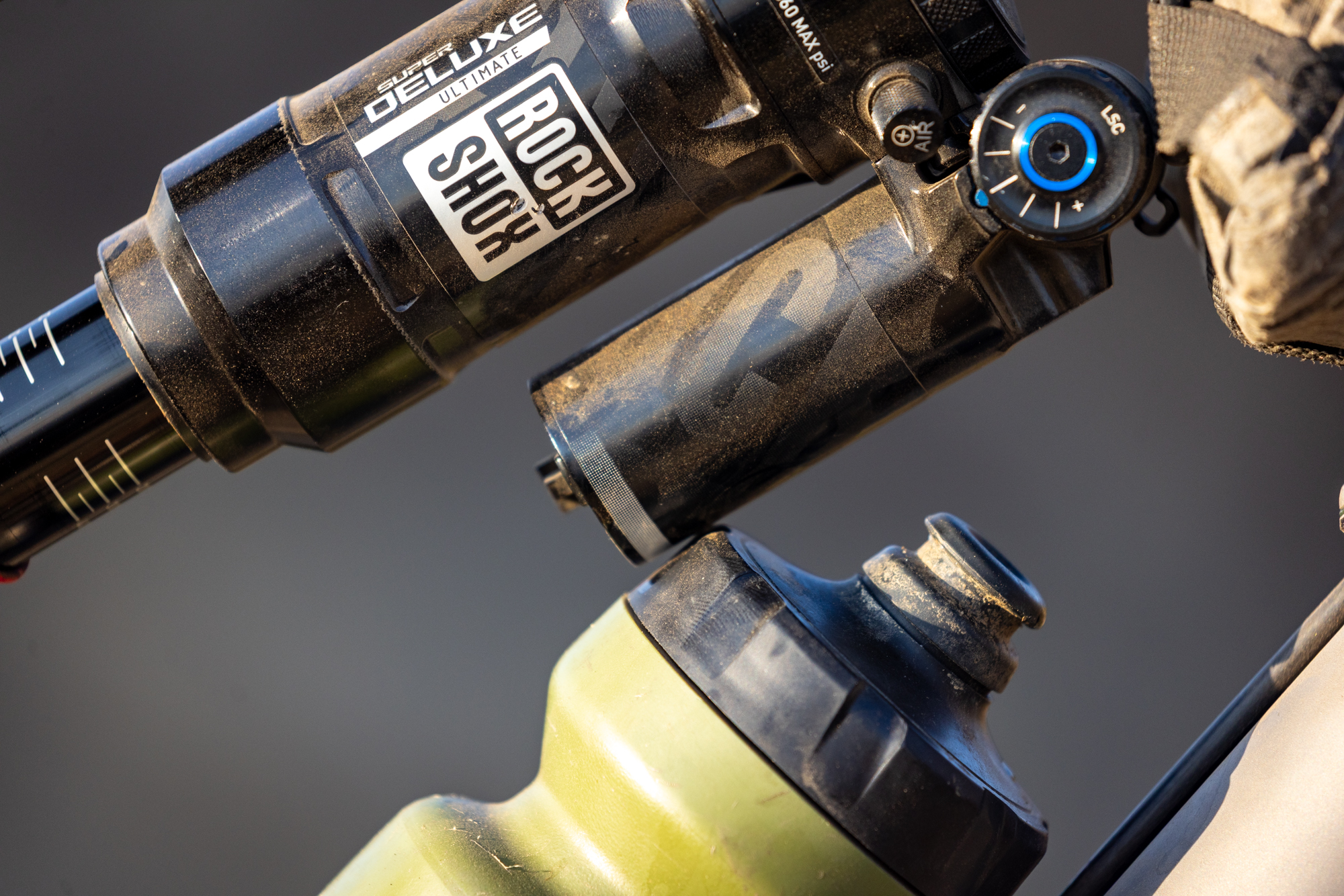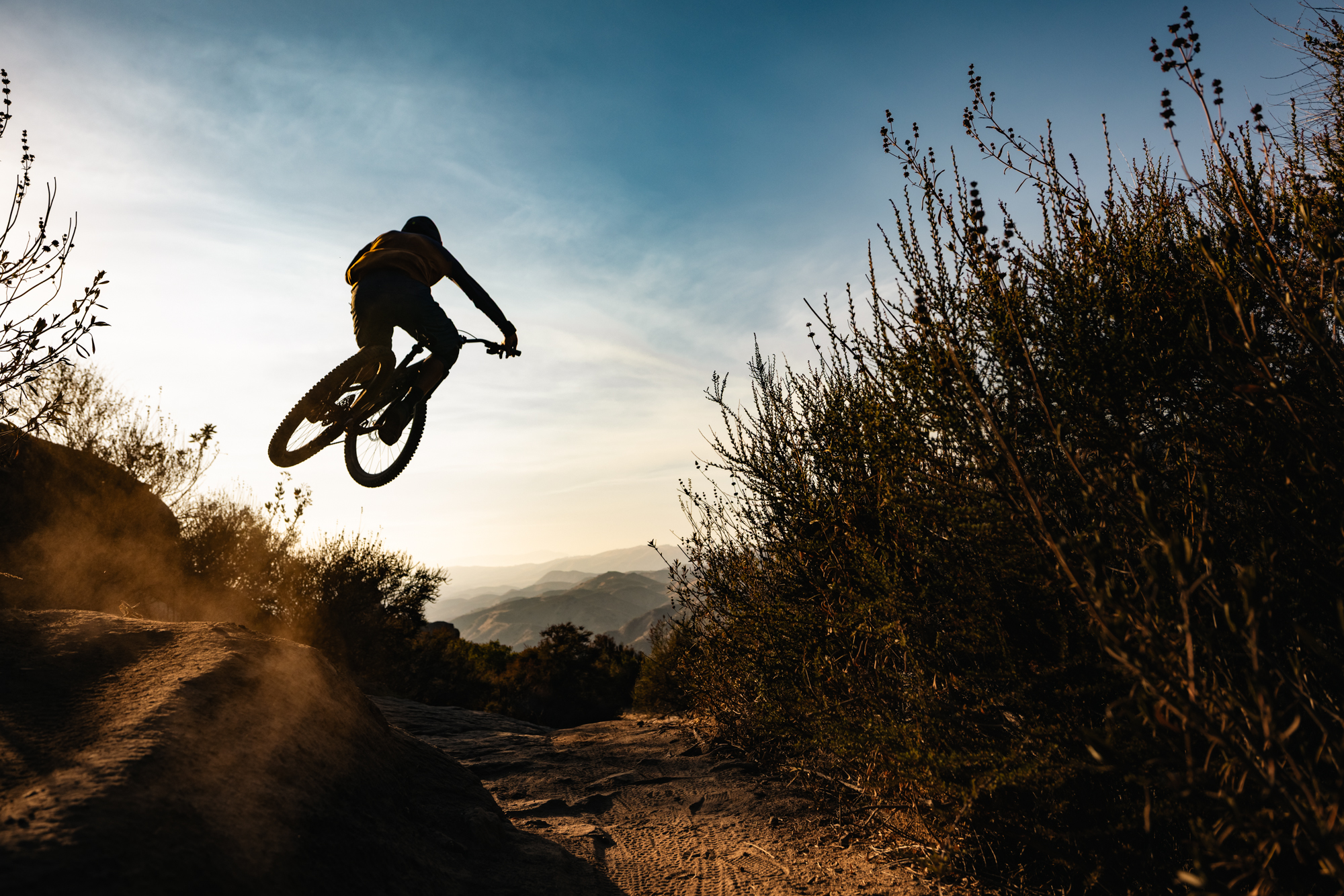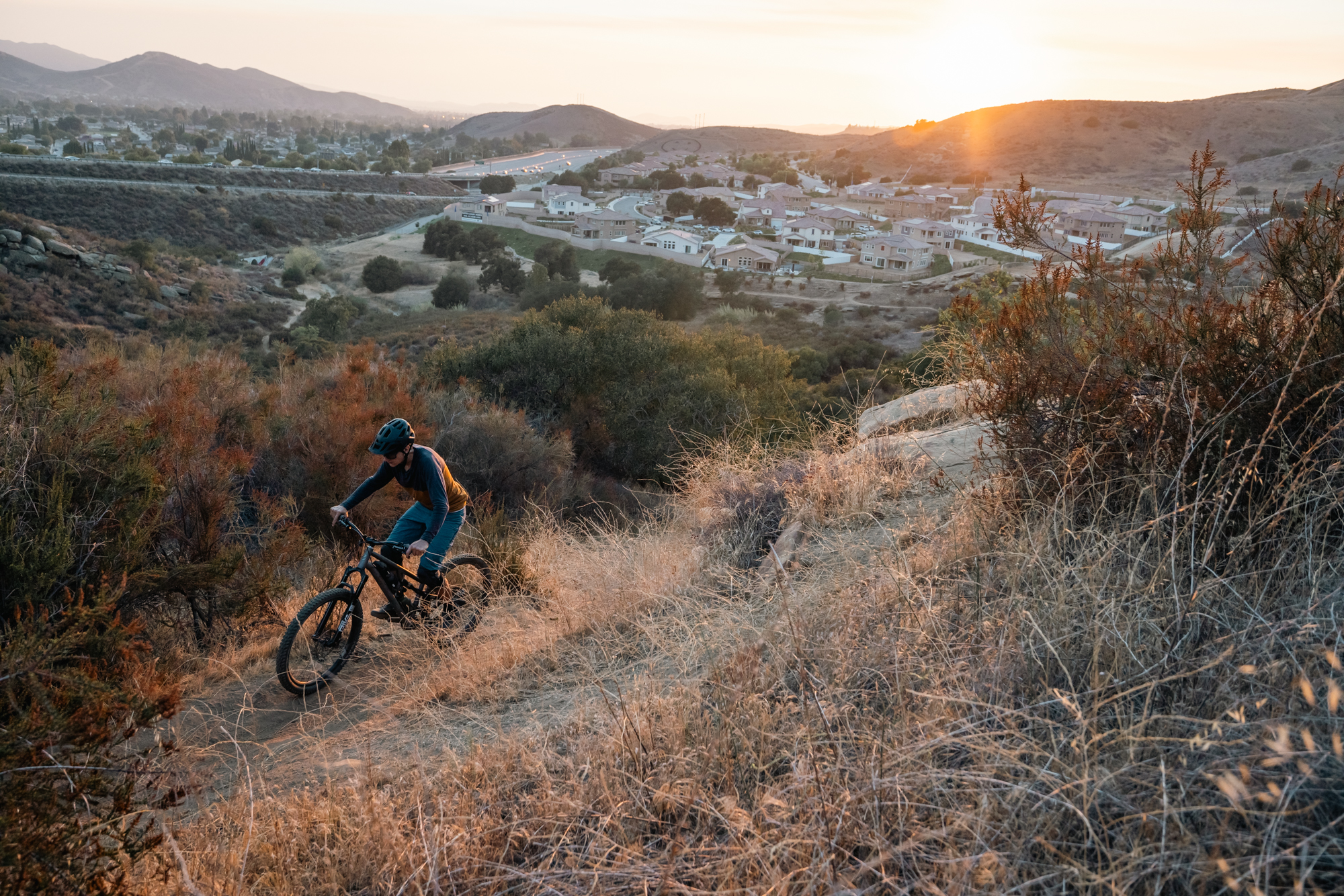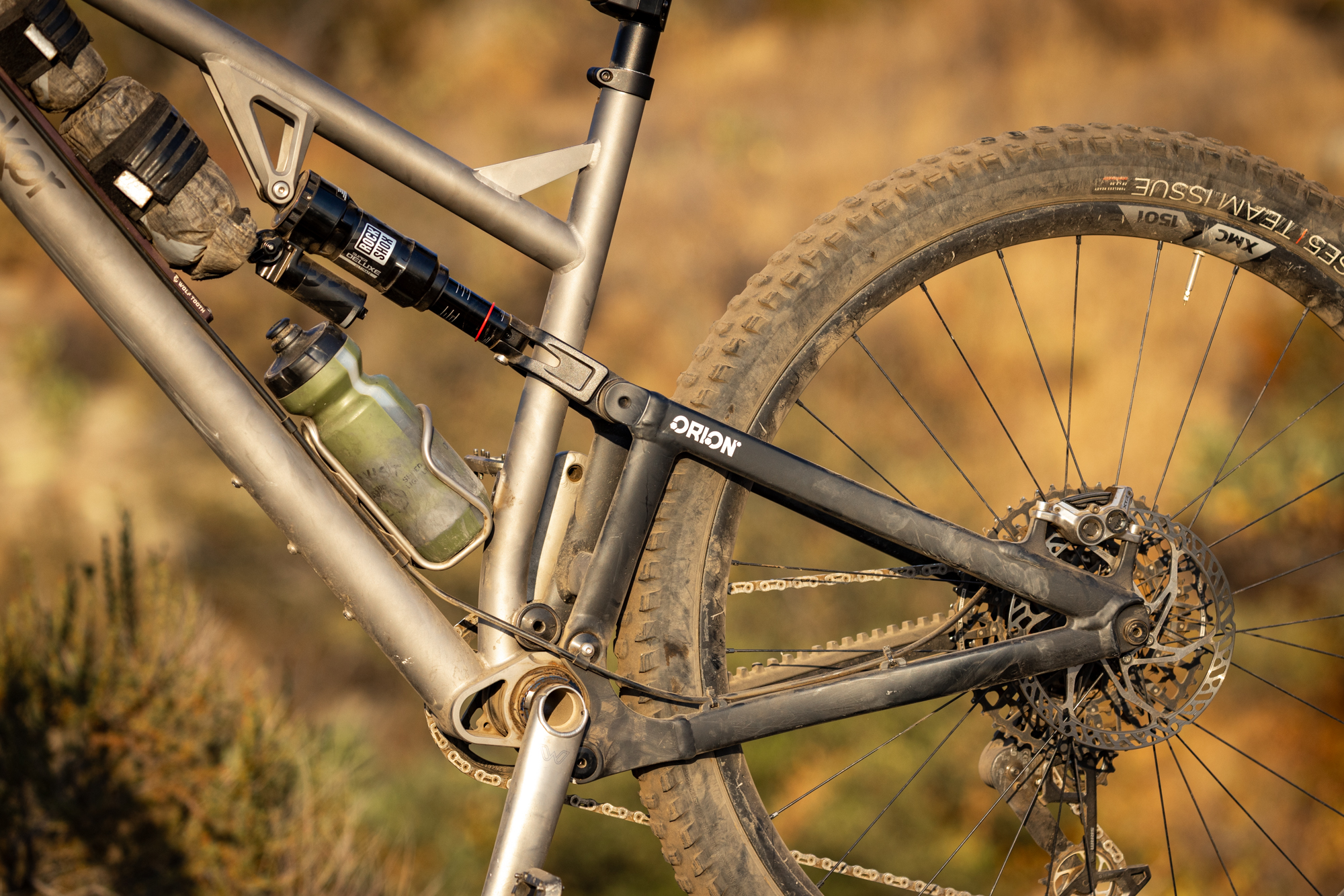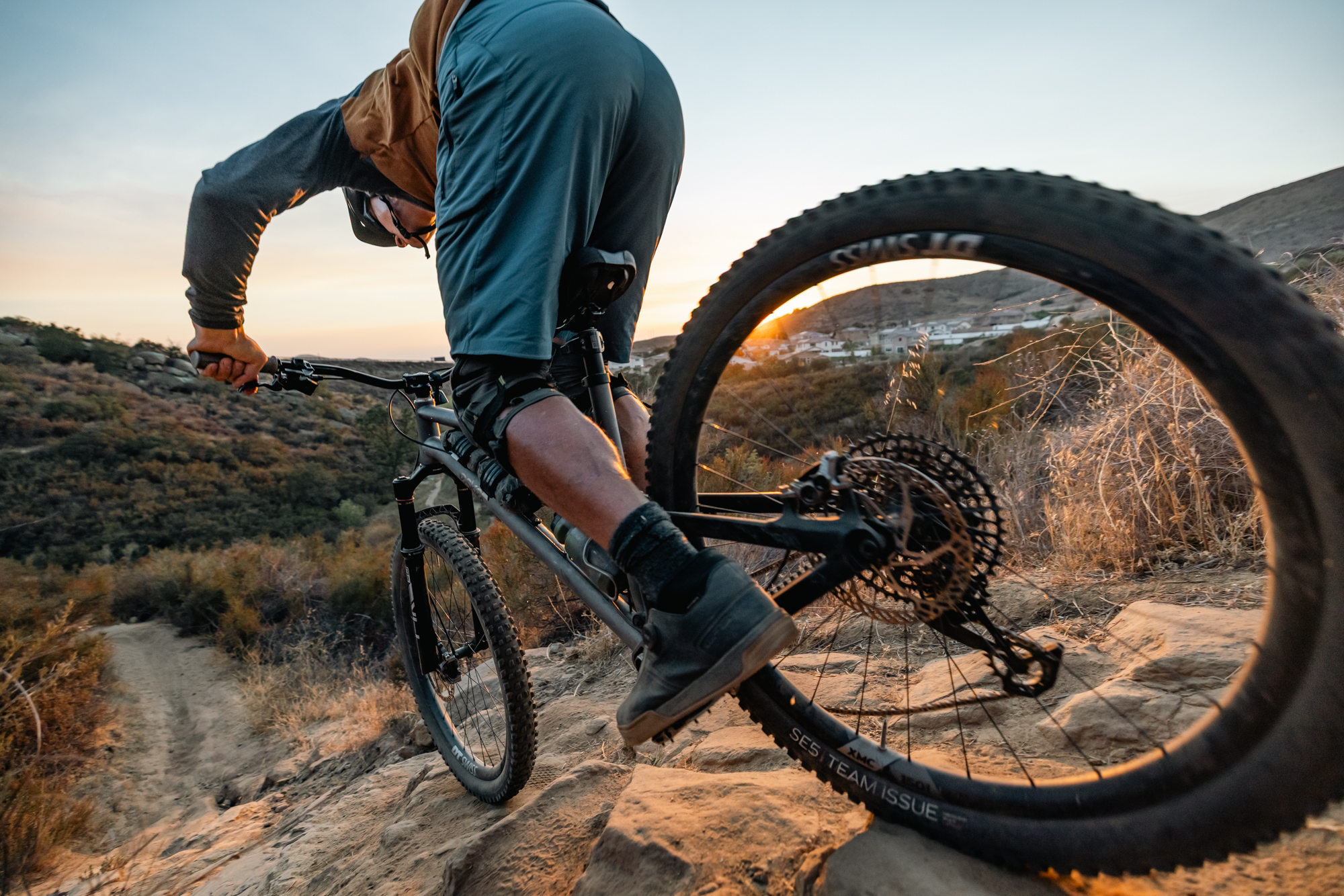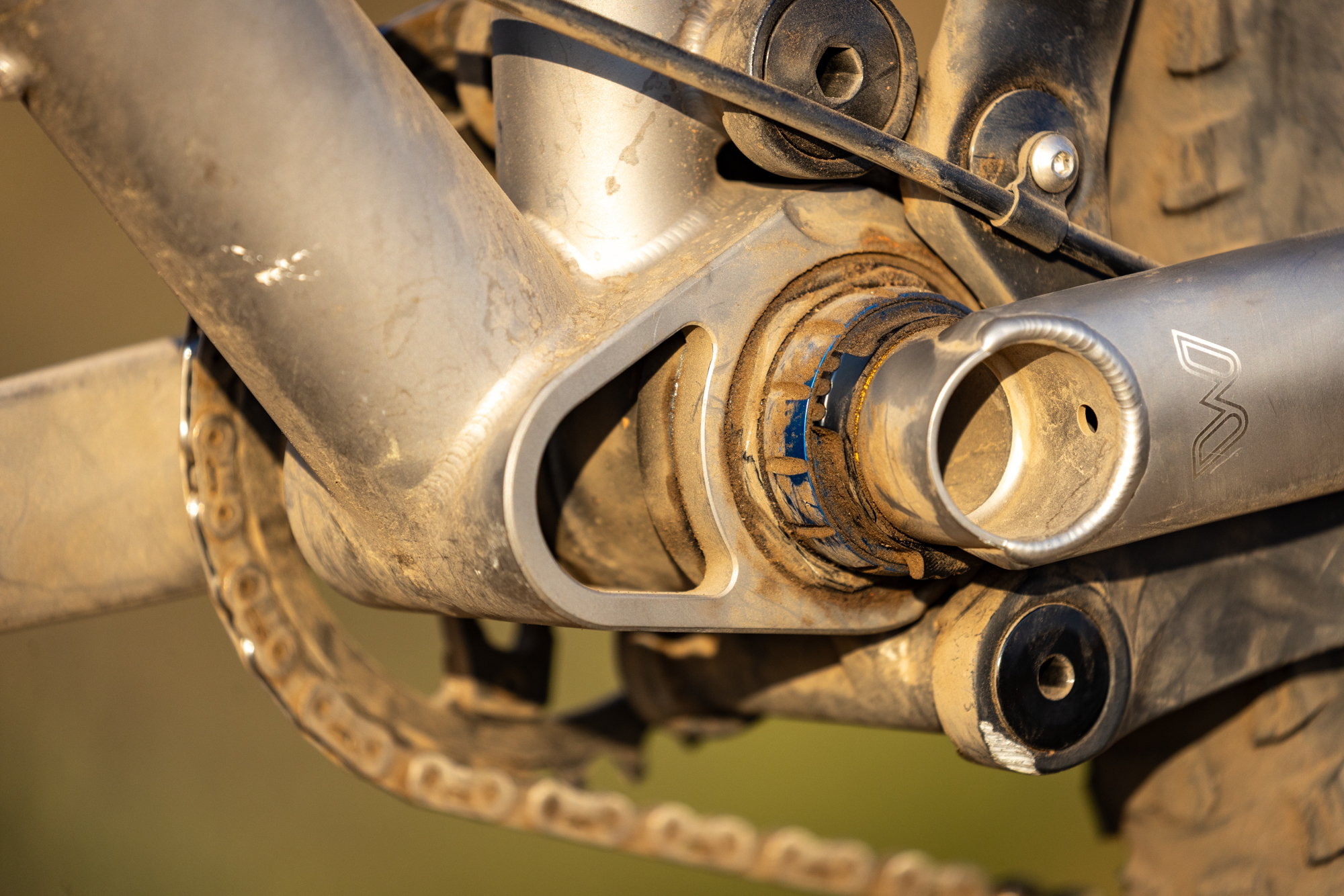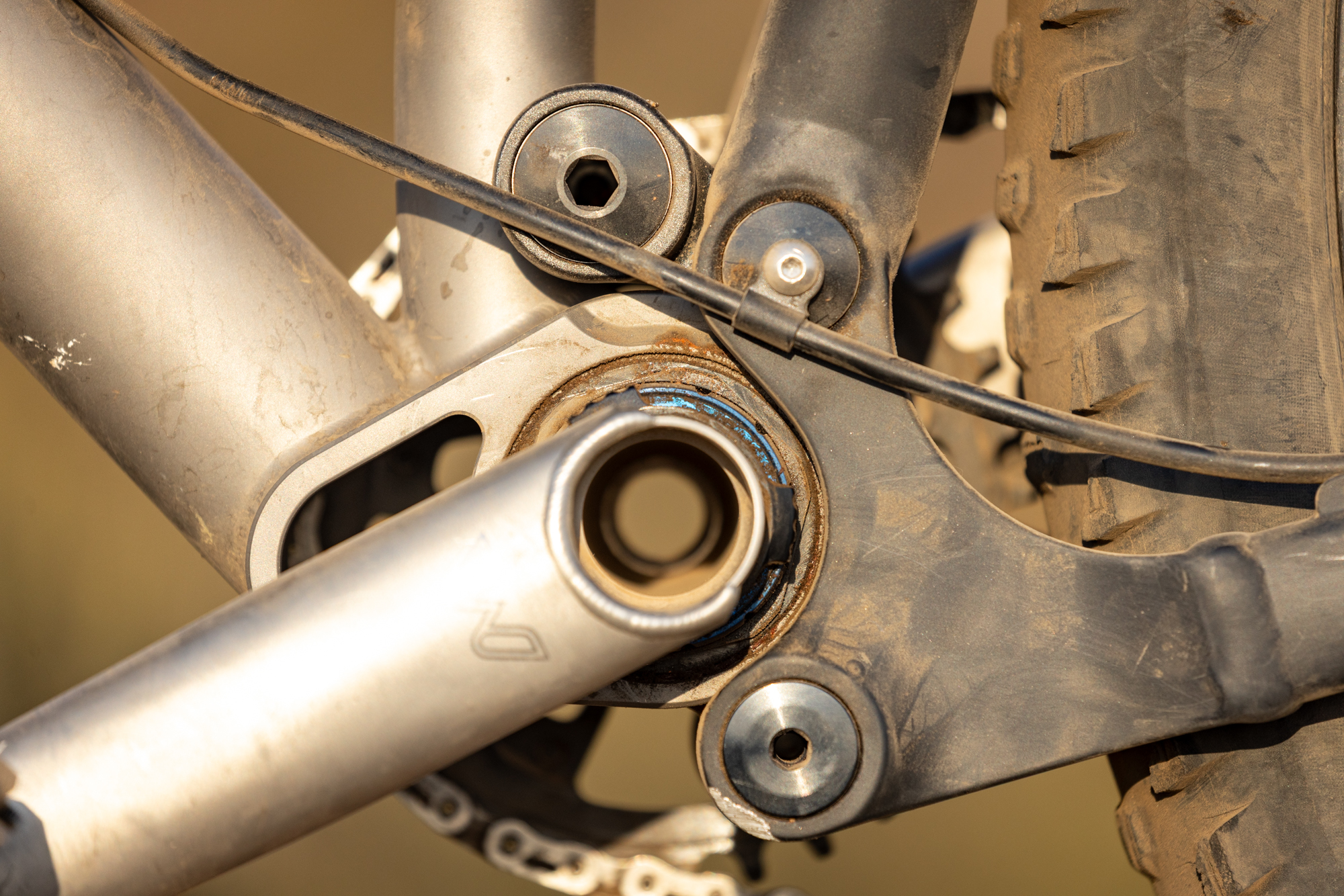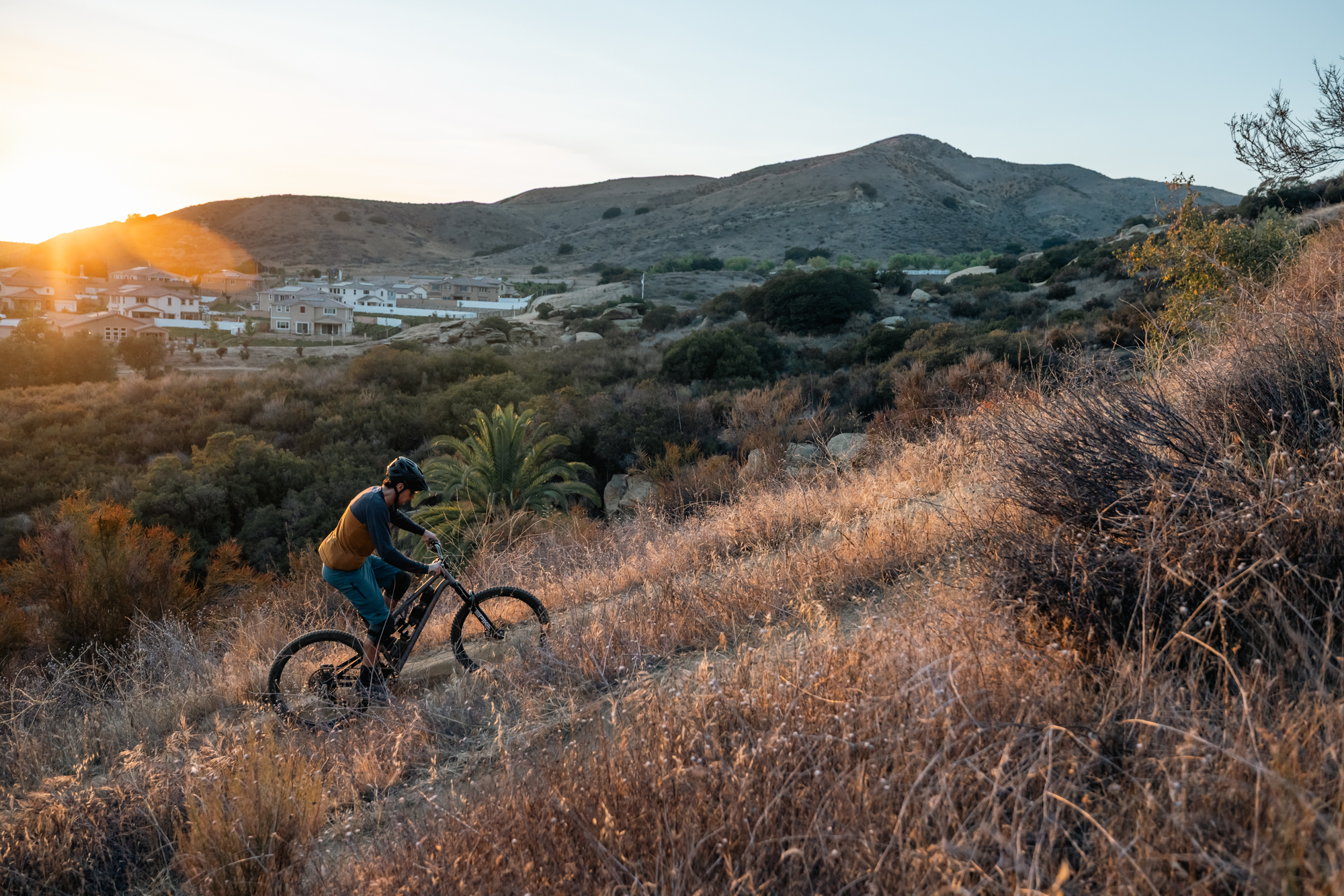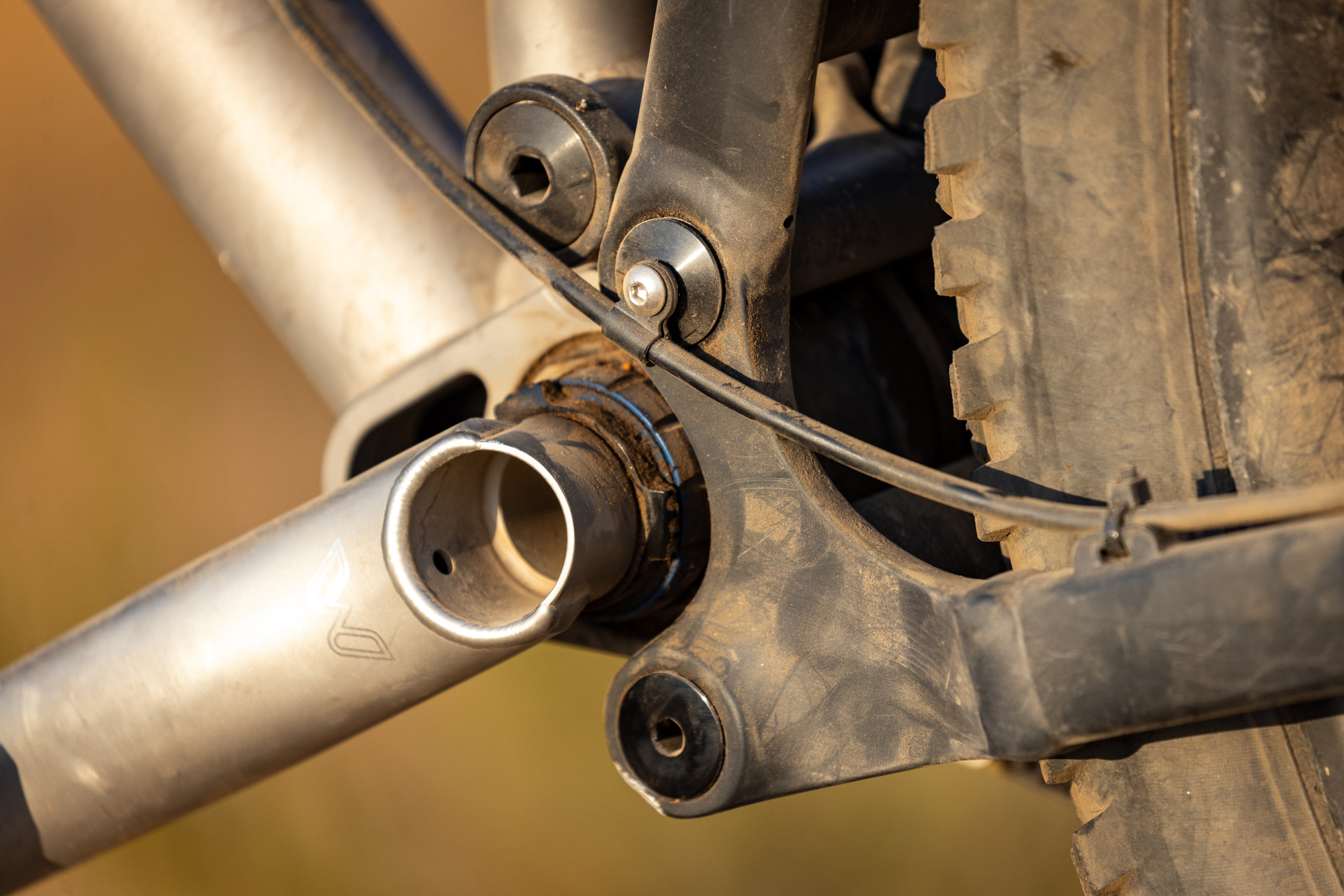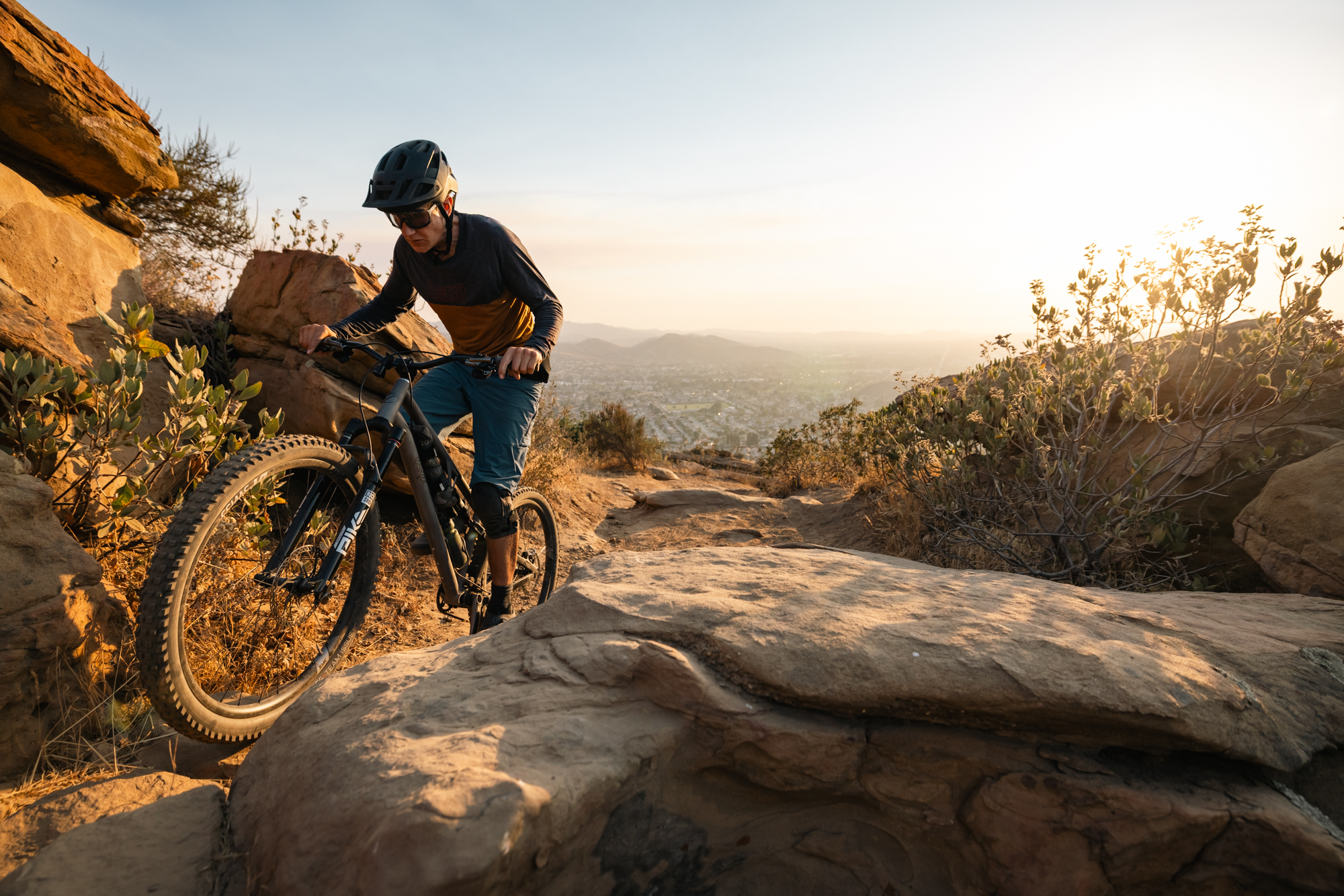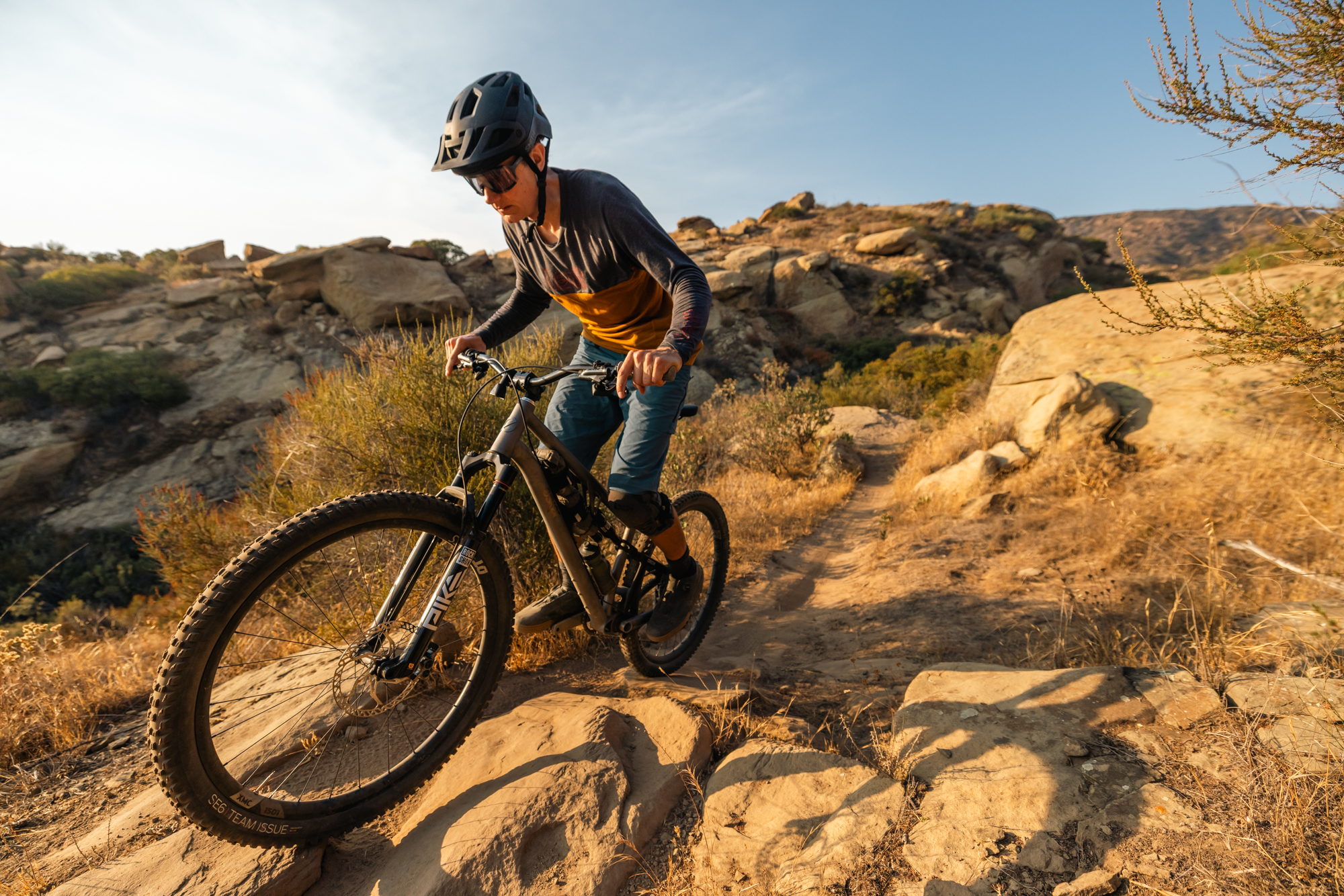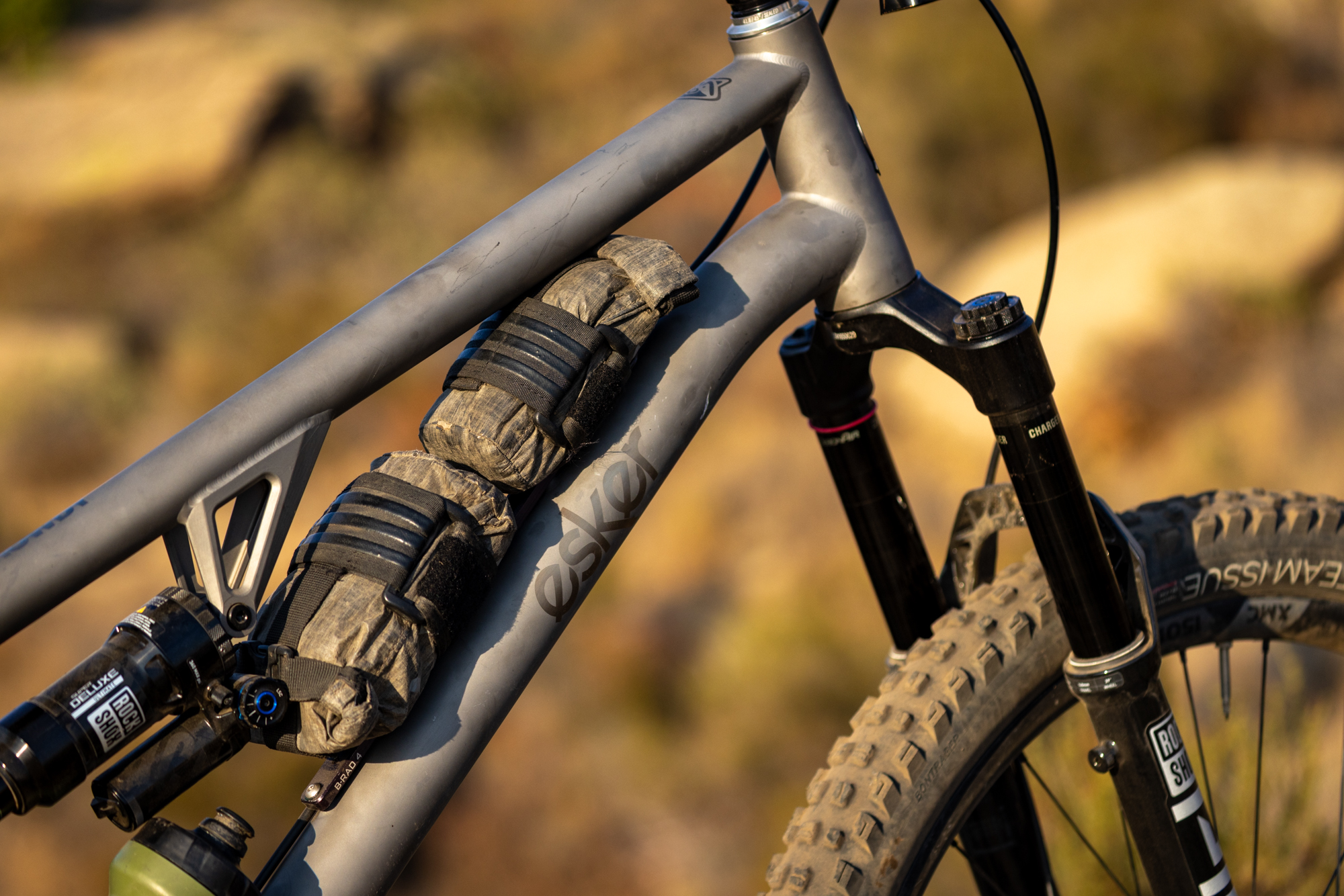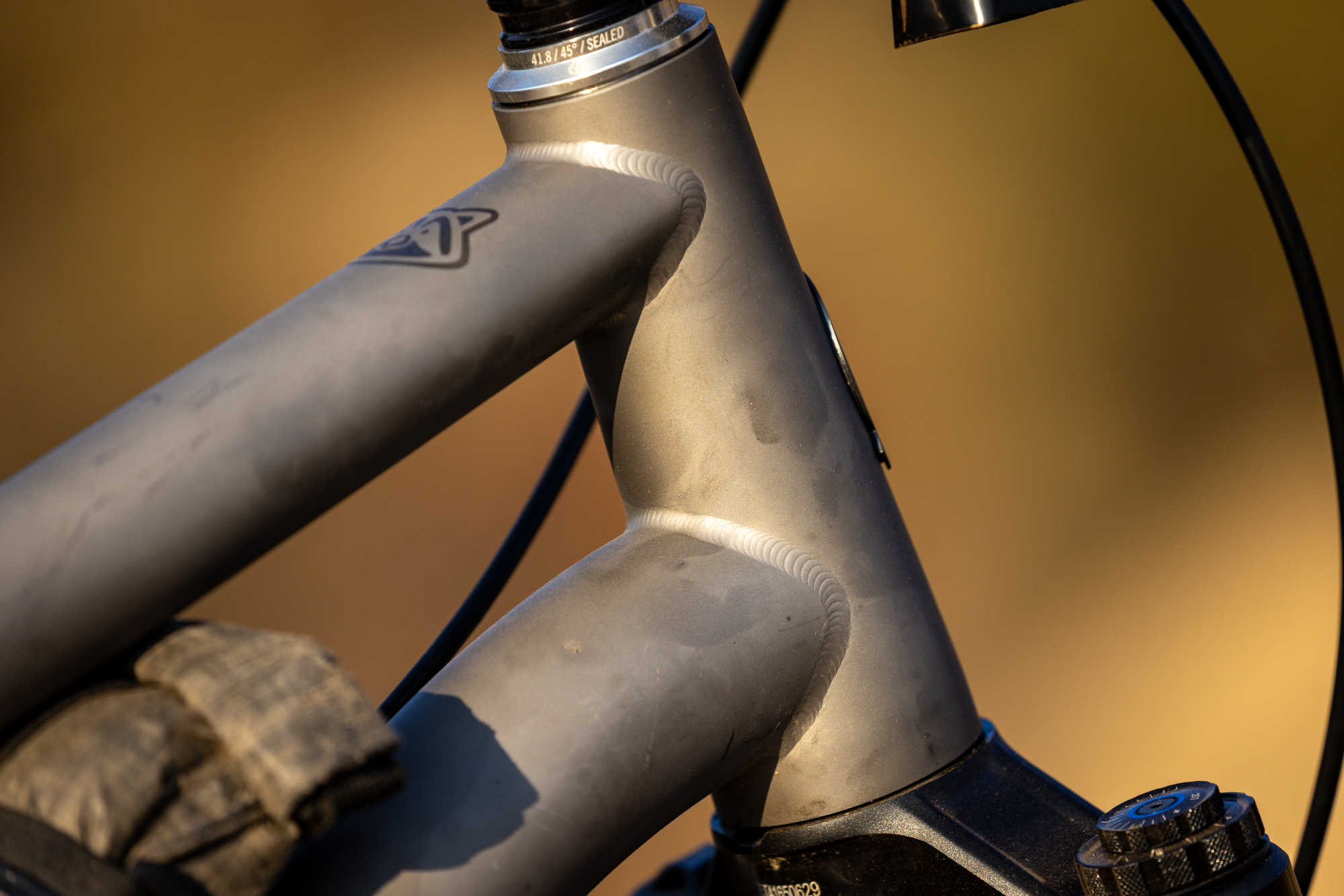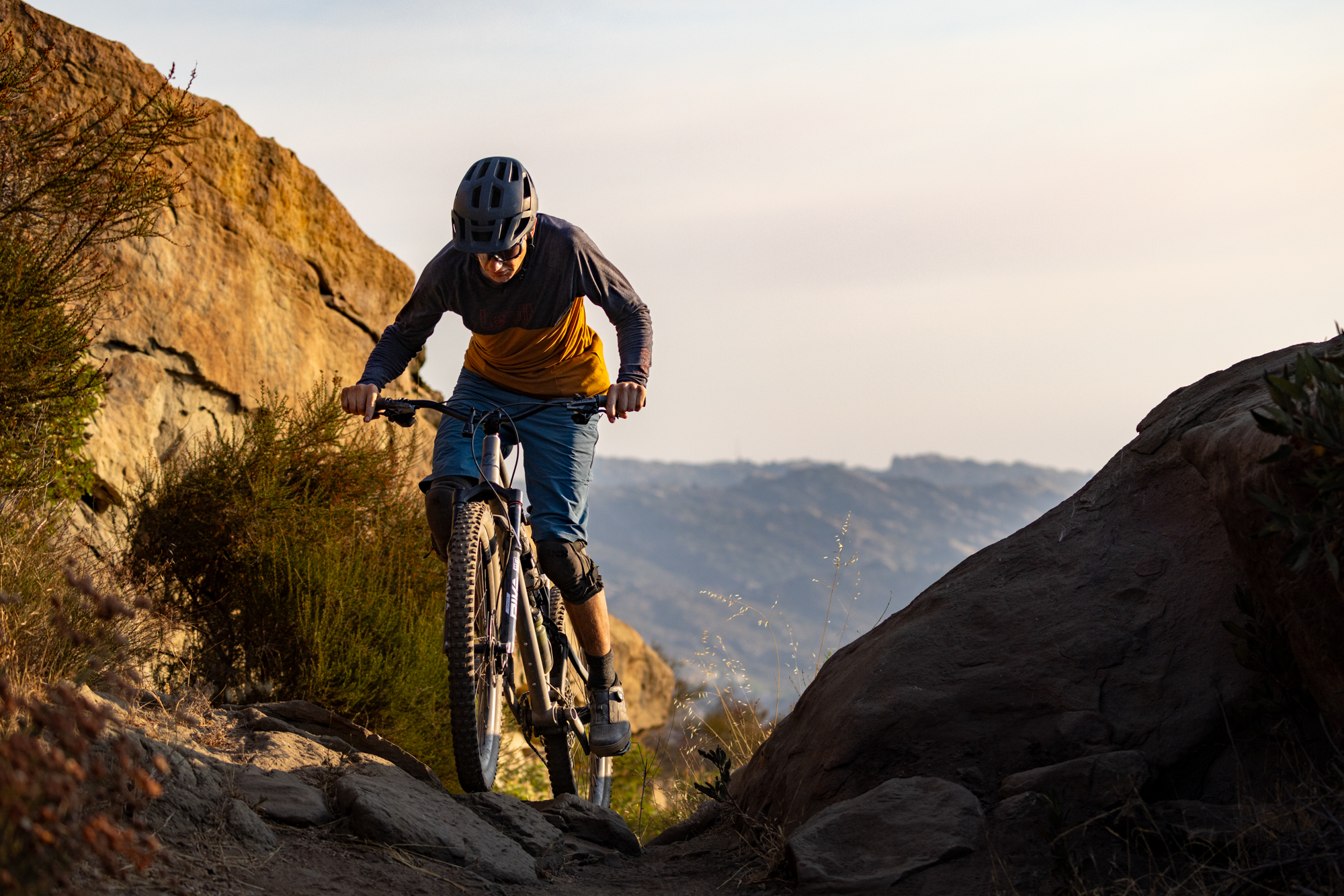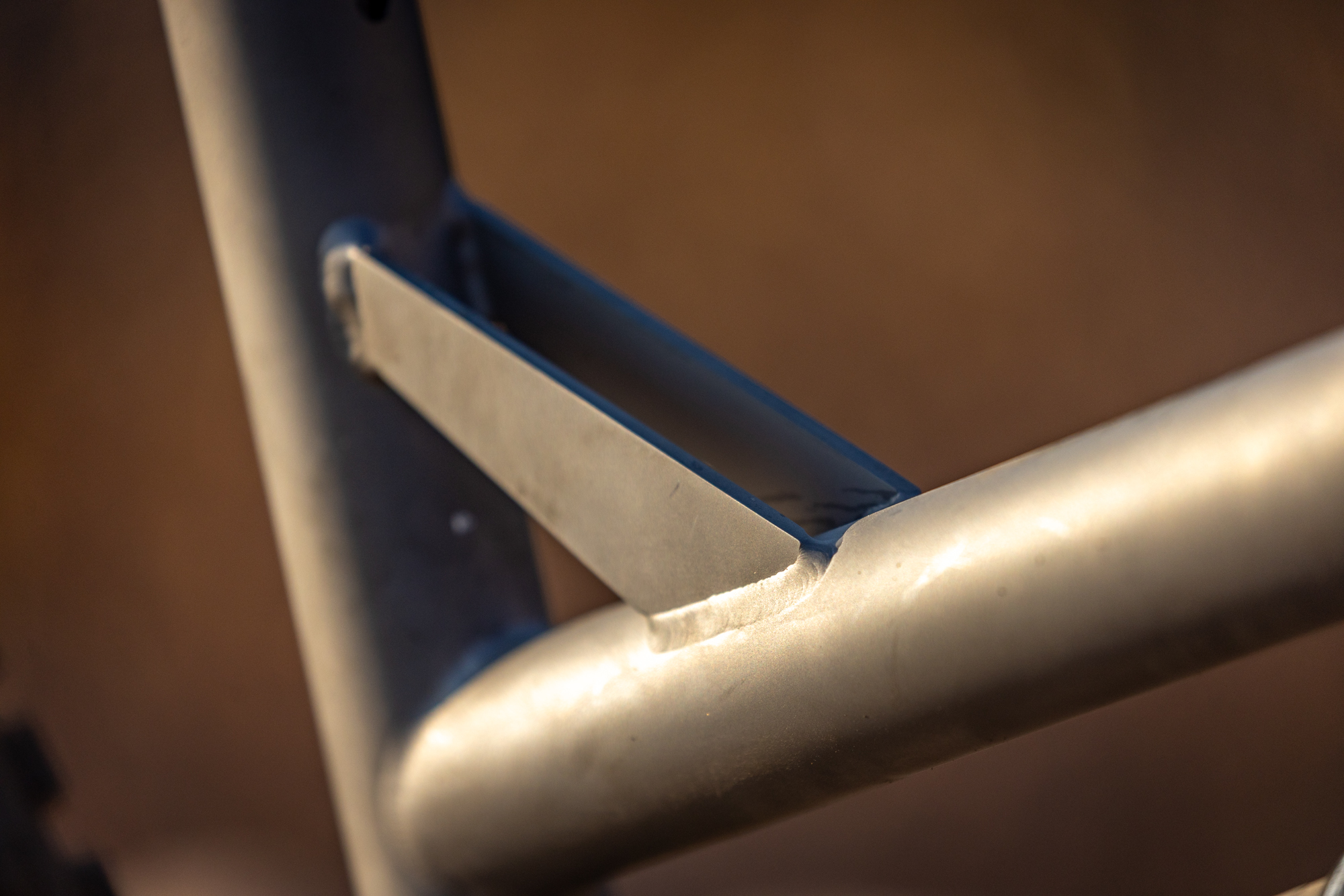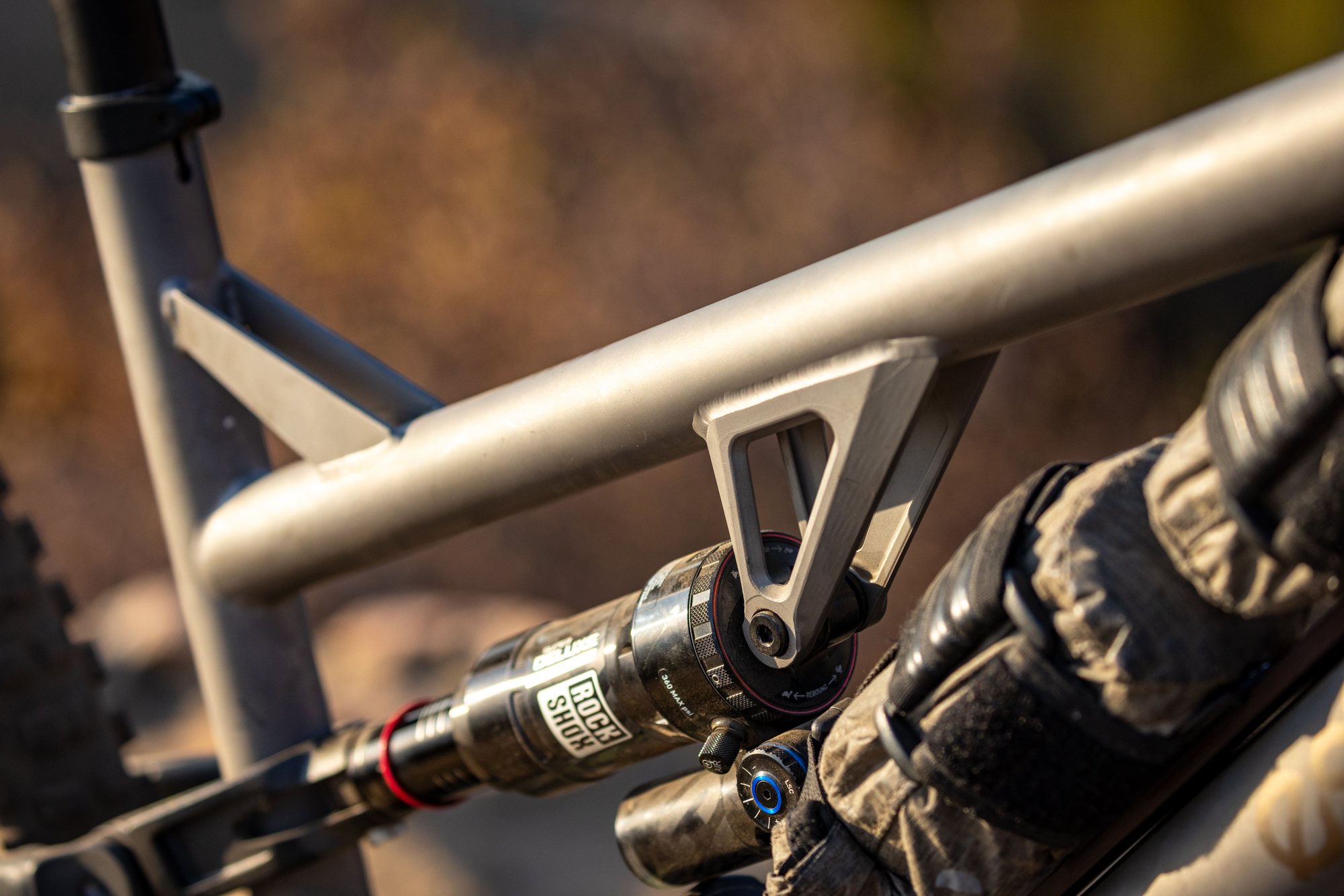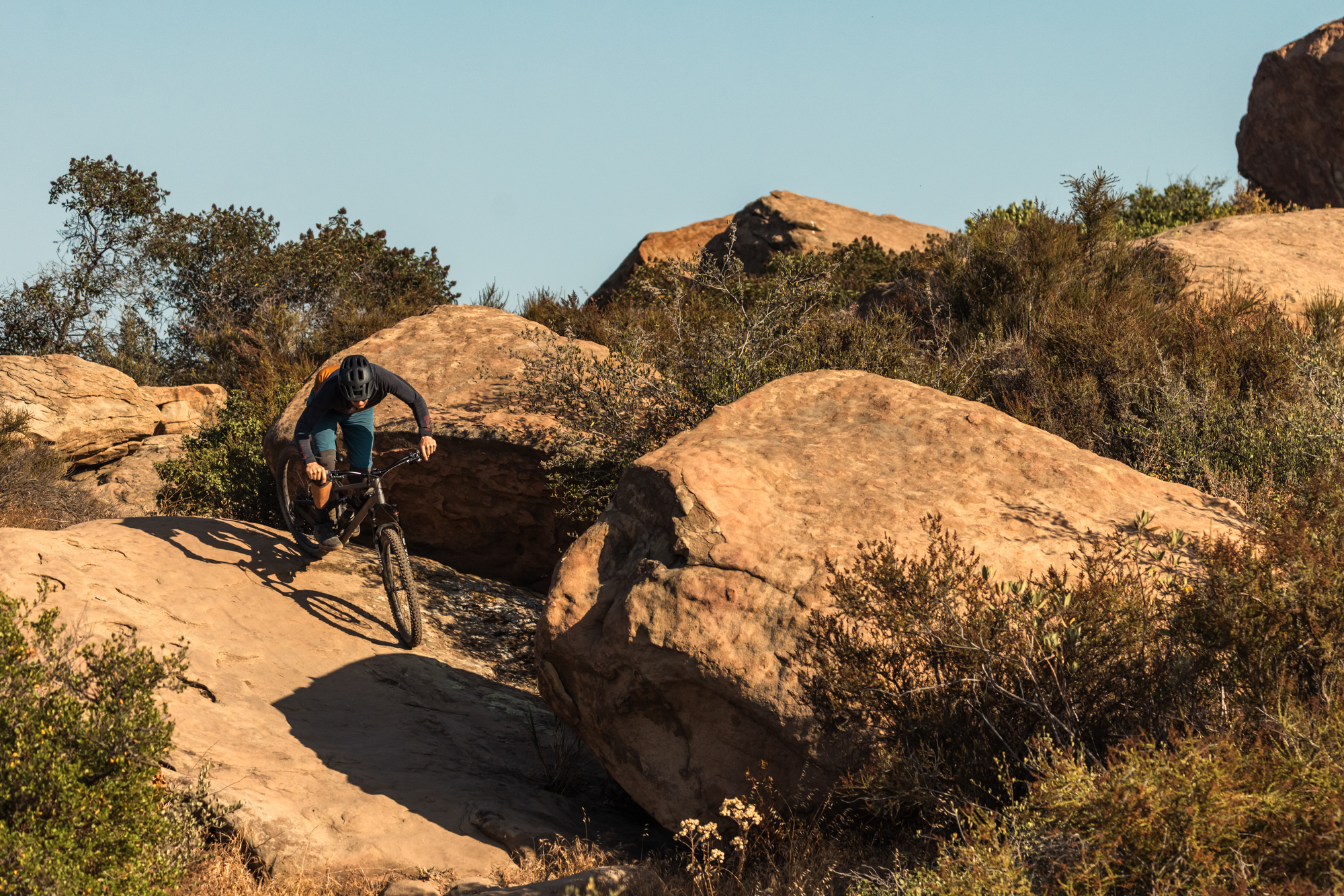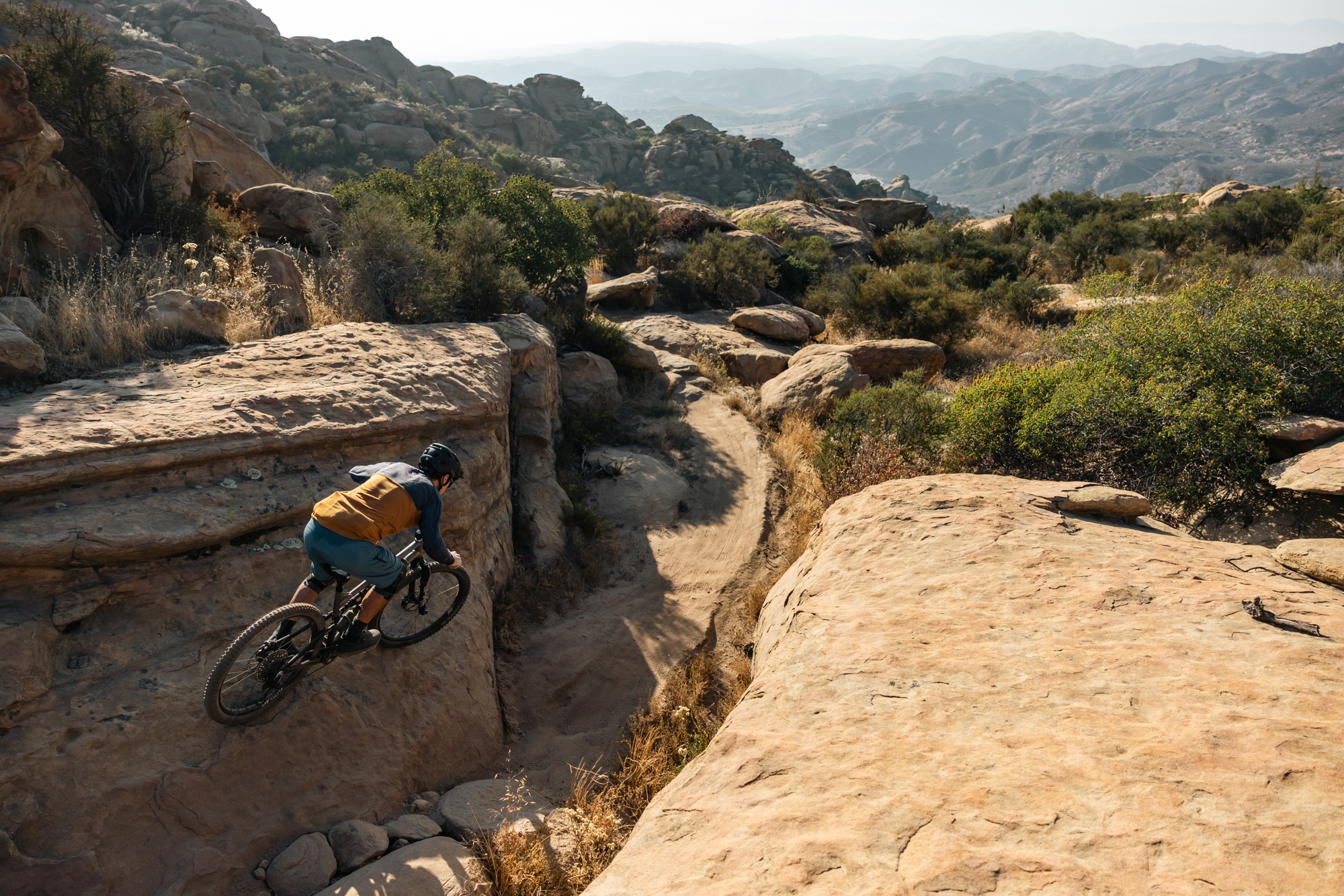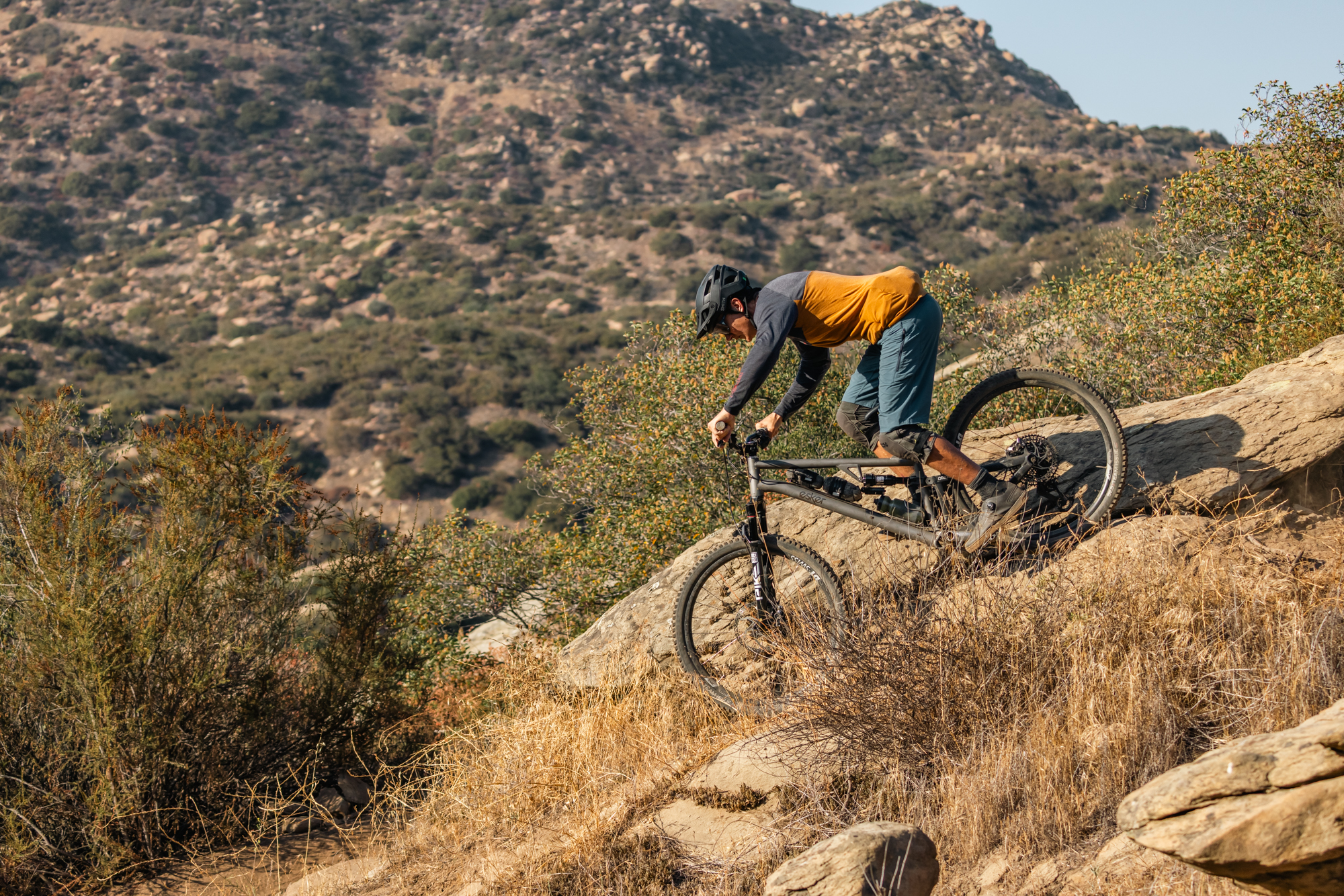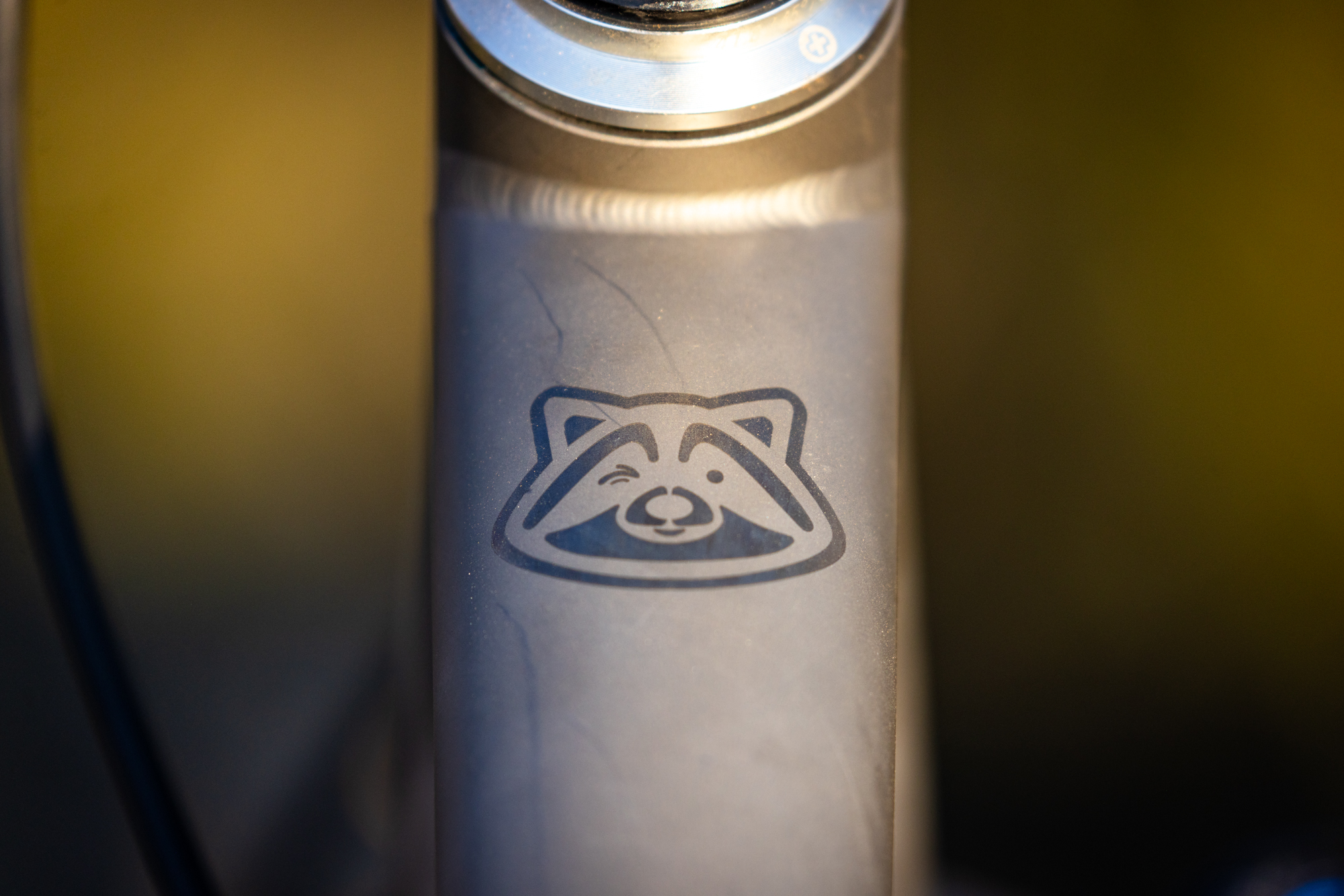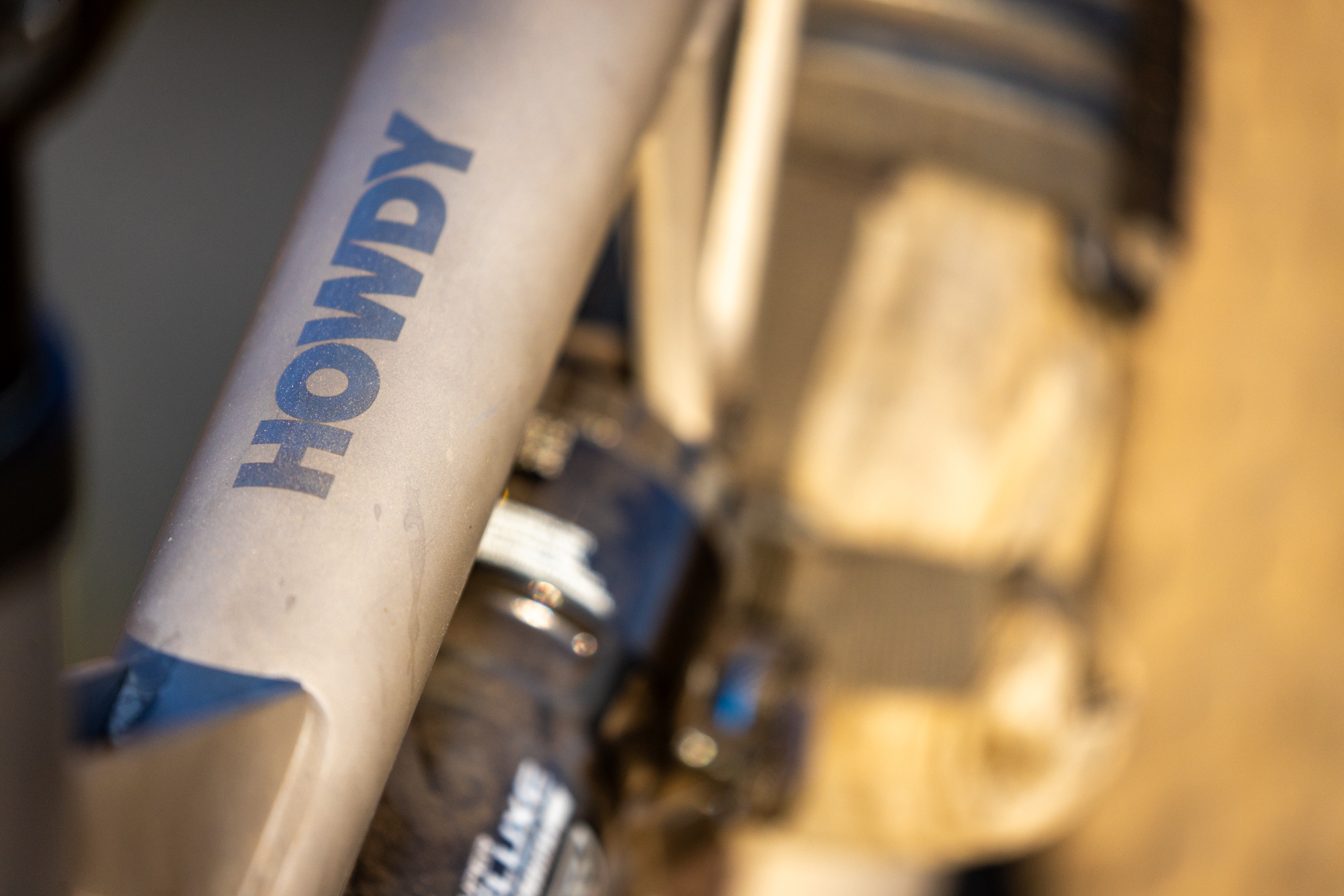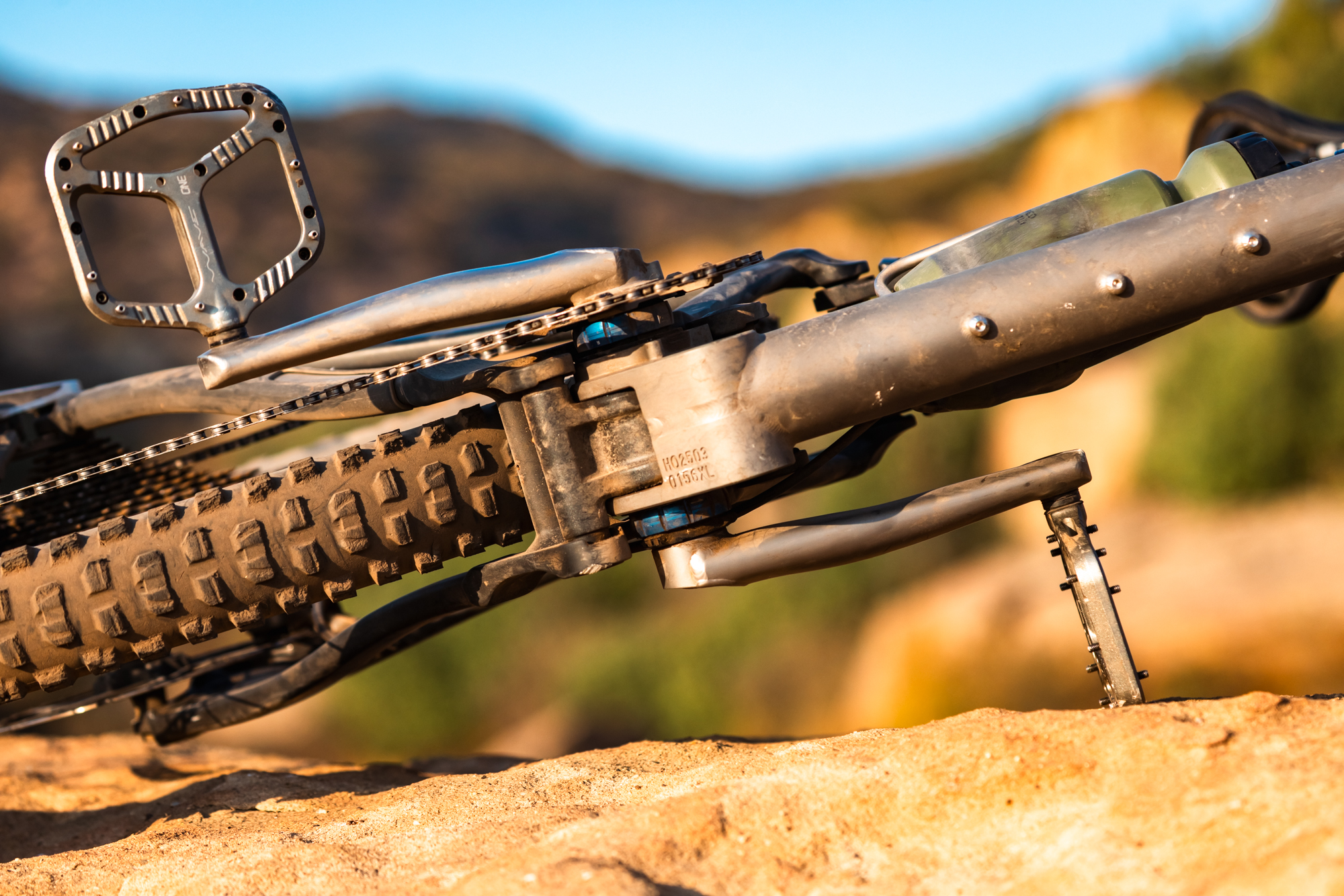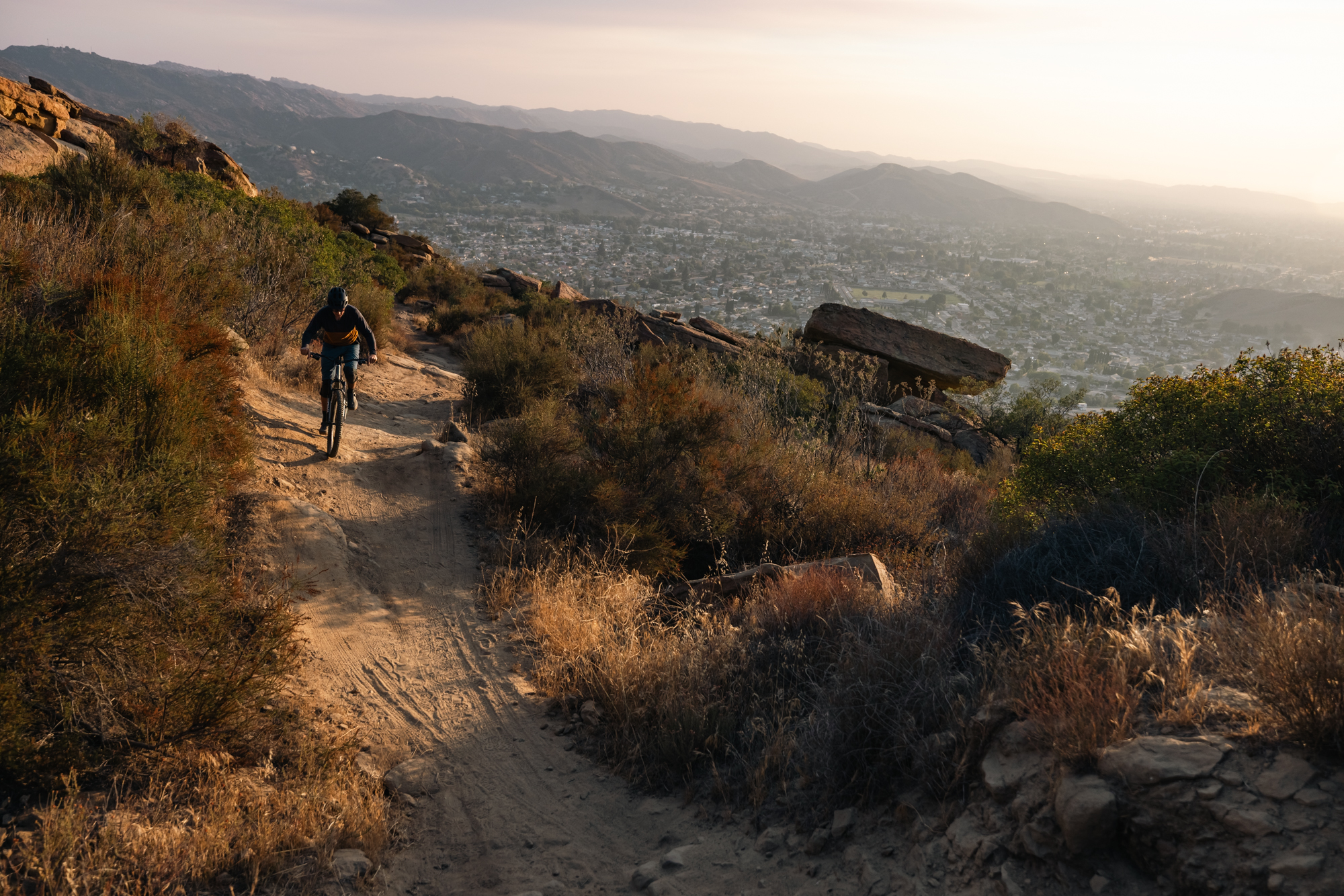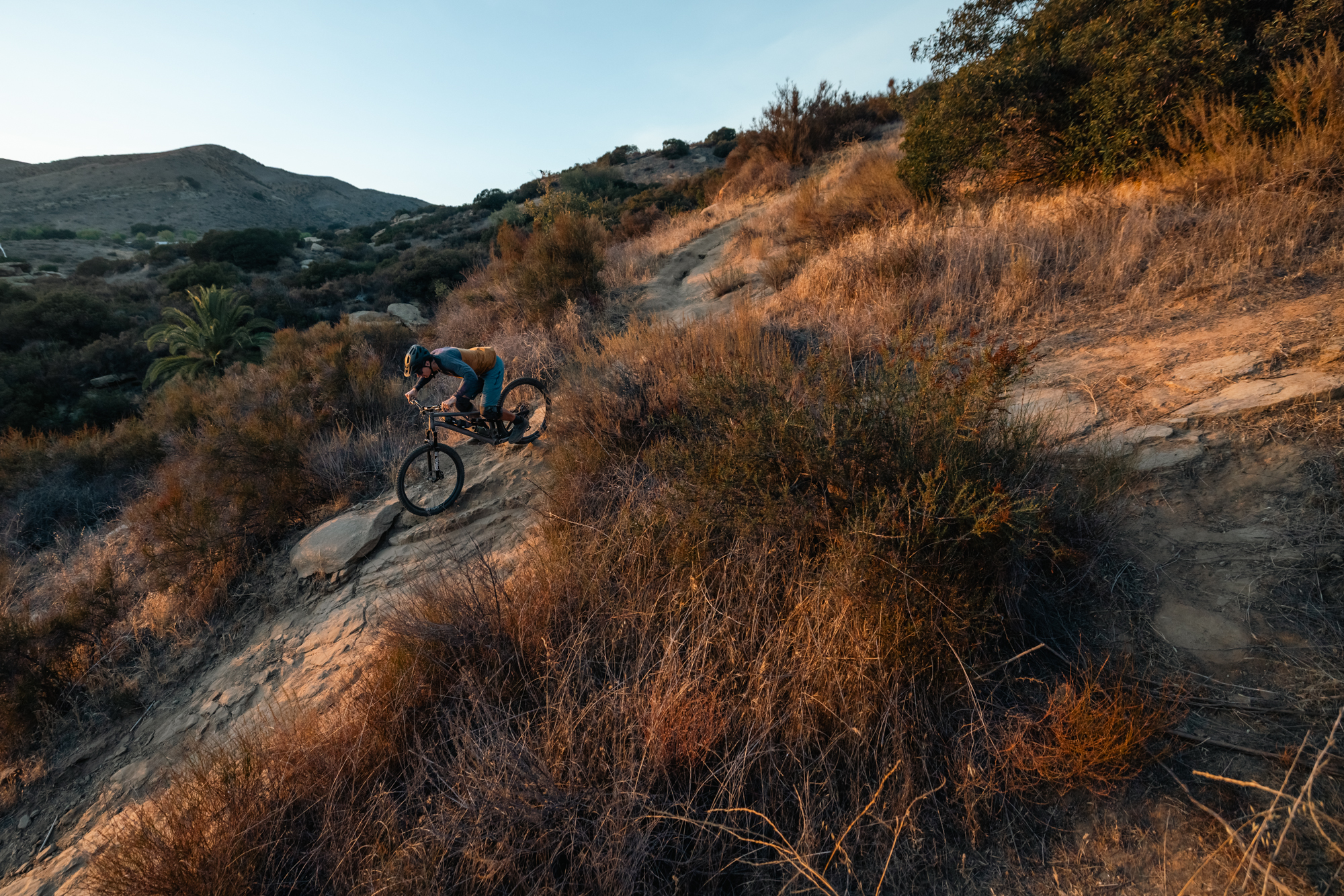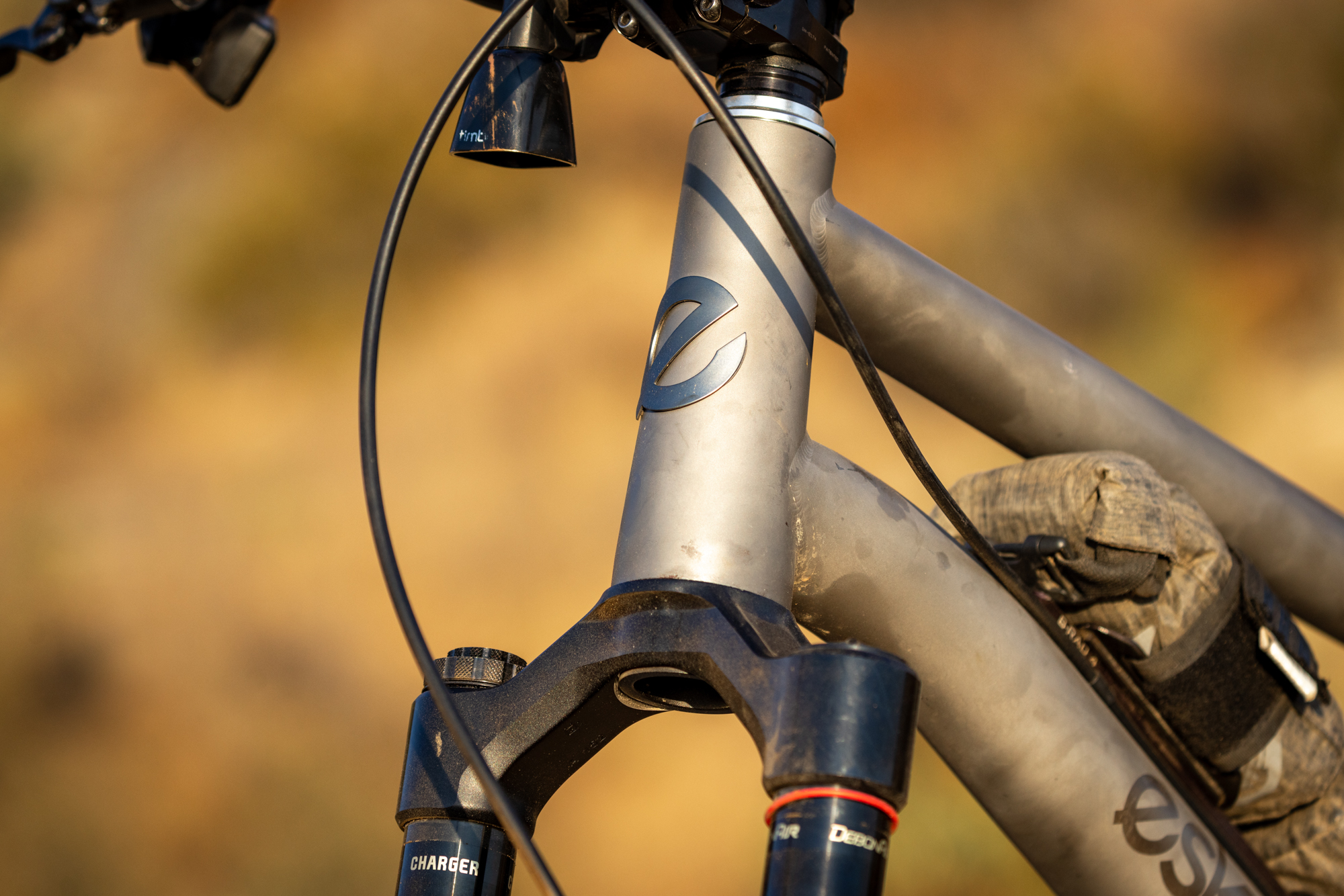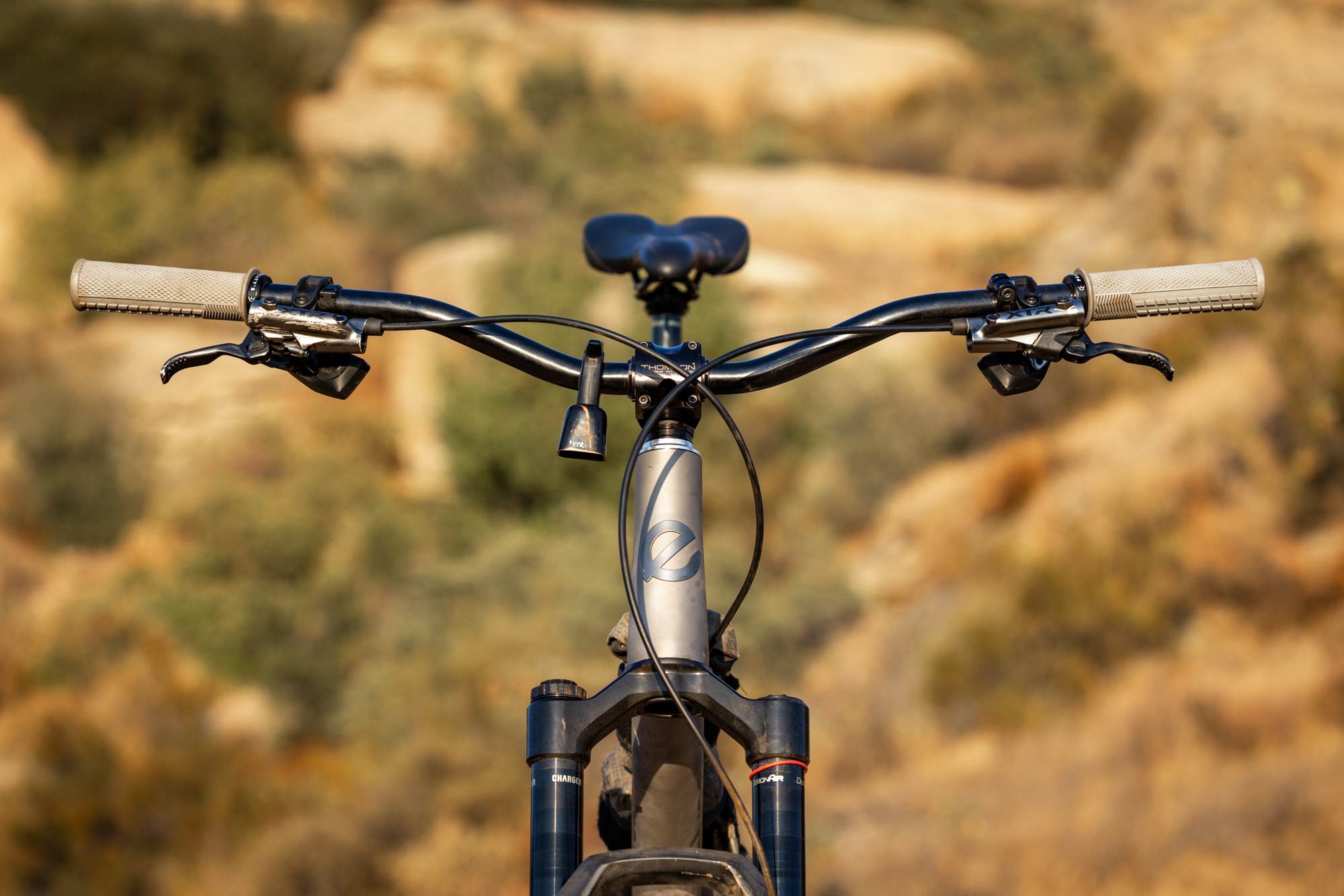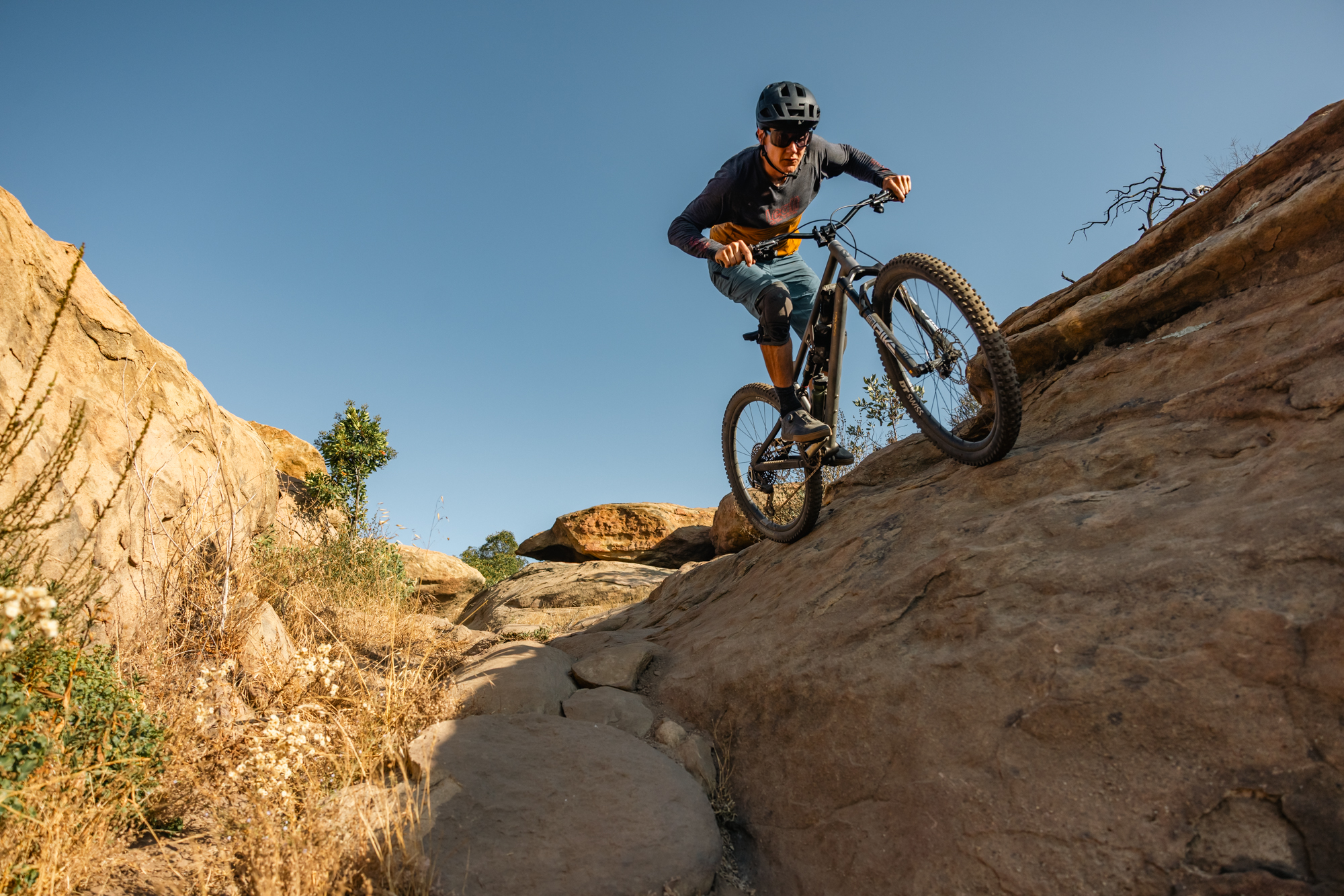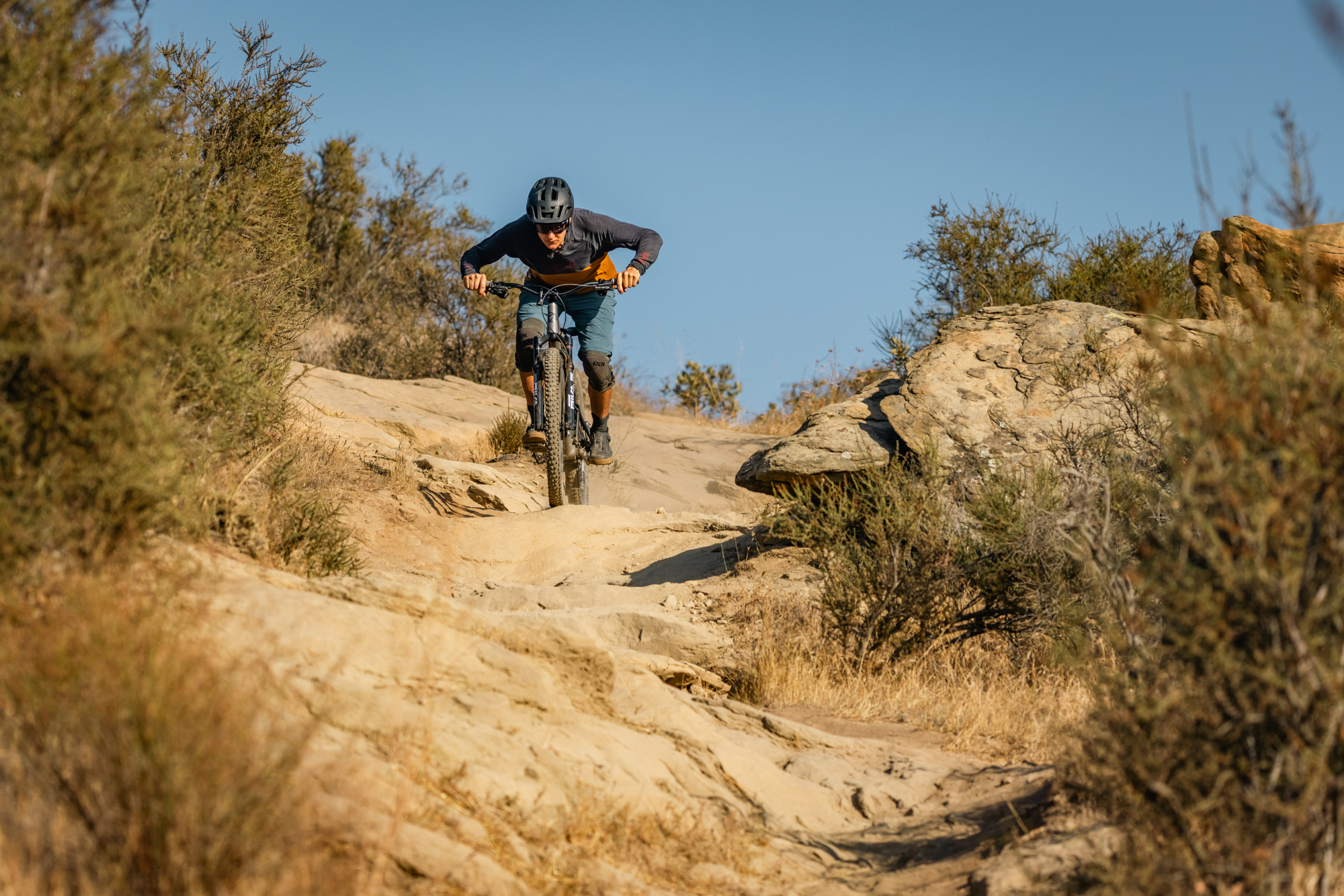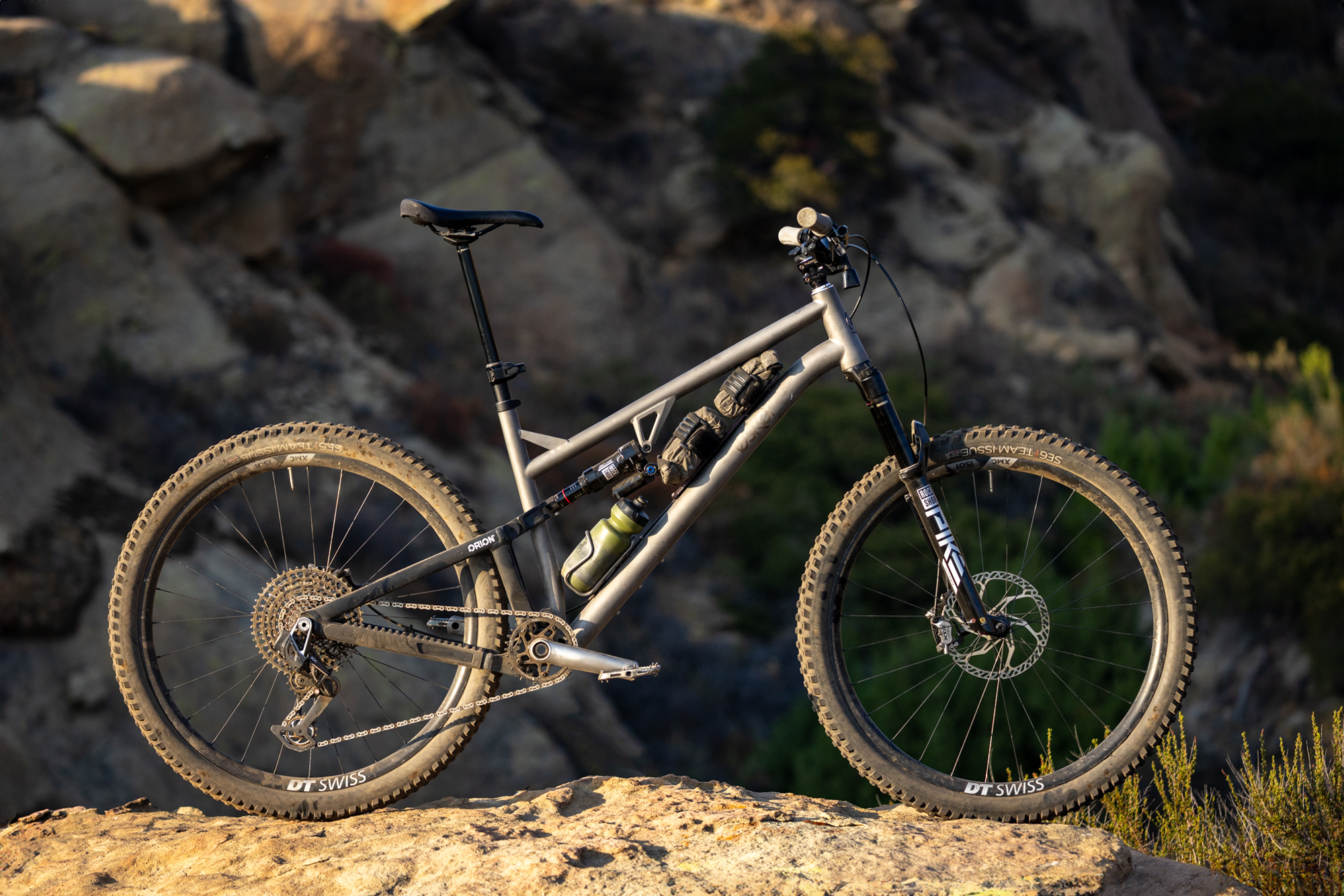When we talk about the Esker Howdy Ti, we could focus on its cutting-edge linkage design. Or its titanium frame. Or its pretty good value. But what stood out for Travis is how much fun it is … That, and the fact that it’s a cutting-edge titanium bike that’s a pretty good value.
There are a lot of different factors that might ultimately tip you into choosing one bike over another. Maybe it’s the spec and price. Maybe it’s the design and technology. And maybe it’s just the vibes. Normally, you’re lucky if the bike you want stands out in only two of these categories. My primary mountain bike, for example, performs like it was made specifically for my home trails, and it was really cheap. But I’ve got zero emotional connection to the brand. In contrast, my touring bike is dripping with personality and stuffed with smart features, but it’s a bit expensive for a steel hardtail. The Esker Howdy Ti, on the other hand, is a straight flush.
Esker Howdy Ti Quick Hits
- Titanium front triangle, alloy rear triangle
- 29” front and rear wheels
- 125mm rear travel, 140mm front
- Dave-Weagle-designed Orion Link suspension
- Full external cable routing
- Made in Taiwan
- 34.6 lbs (XL custom build w/o pedals)
- At time of publishing, a 10% tariff surcharge will be added to all sales
- $3,500 frame-only ($3,850 with tariff surcharge)
- $5,500 starting price for a complete ($6,050 with tariff surcharge)
- Alloy versions start at $2,000 for a frame, $4,000 for a complete ($2,200 and $4,400 with tariff surcharge respectively)

Esker Cycles does cool shit. They regularly give support to trailwork organizations, including the frame they donated and built to replace a bike the Lowelifes founder lost in The Eaton Fire. Esker Cycles also makes cool shit. The Lorax drop-bar MTB is named after a children’s book about environmental stewardship. Their Japhy and Smokey are sleek, simple, single-speed-able hardtails, while the Hayduke and the long-tailed Hayduke LVS were designed specifically for bikepacking. Those are some vibes I can get behind. But I had never heard of Esker when I first met their debut full-suspension bikes.
The Elkat that dropped in 2018 and the Rowl that followed in 2020 looked like any other carbon all-mountain machines. But they were the first (and only) bikes to feature Dave Weagle’s unique Orion Link suspension, which satisfies my design/technology lust quite nicely. That’s why I was so happy to see Orion Link emerge from years of hibernation with Esker’s introduction of the 125 mm Howdy and 145 mm Woodsy. Their metal frames, Forest-Service mascots, and external cable routing were rich with vibes. And I was pleasantly surprised by their value, including the titanium Howdy I’m here to talk about today.

I’m currently writing this from some point along the tariff roller-coaster. Esker is navigating it as well as they can. In hopes that things will eventually calm down, they’ve added a 10% surcharge to their bike and frame sales instead of permanently raising their prices. So, the titanium Howdy frame (with aluminum rear triangle) and rear shock will effectively increase from $3,500 to $3,850. And that’s still not bad. There are very few production titanium full-suspension frames to compare it to, but a Chromag Darco Ti frame (with aluminum/steel rear triangle) is $4,730, and may eventually pass on its own tariffs to US buyers.
I’m sticking to frame-price comparisons here because Esker takes such a unique approach to build kits. You get a lot of choices at checkout. Like, you can opt for boutique-level suspension but base-level wheels, or vice-versa. Same with cockpit, brakes and drivetrain. Even if I could find a fair apples-to-apples build to compare from another brand, Esker would still have an edge because they offer you the freedom to spend where you want to spend and save where you want to save.
Then there’s the all-aluminum version of the Howdy, whose frame and rear shock go for $2,000 ($2,200 with surcharge). I’d put that up against an Ibis Ripley AF frame for $2,500, or a Trek Top Fuel AL frame for $2,700. Of course, the alloy-frameset market is also a little slim on competition now that carbon is king. But as Esker told us when they launched the Howdy and Woodsy, maybe it’s time for a coup d’état.



By some very specific metrics, carbon can still be “better” than metal. It can be lighter, and can offer designers some pretty granular tunability of strength and ride quality. That has not changed. What has changed is literally everything else. Geometry is better, suspension is better, drivetrains are better, brakes are better. Tires, wheels, cockpits, pedals, hell, shoes are better than they were ten years ago. Saving a pound in frame weight used to be a proportionately meaningful way to increase ride quality. Now, according to Esker, it’s a drop in the bucket.
Plus, getting the carbon monkey off their back allowed them to continue working with their manufacturing partner in Taiwan, a country that most carbon frame manufacturers have left to set up in China. Going metal also allowed Esker to improve sustainability and affordability, while staying true to their brand identity and still offering some pretty advanced tech.


That brings us to Orion Link. Think of it as two systems working together. One system is a dual-short-link mechanism similar to DW link, but one of those short link’s pivots is concentric with the bottom bracket. The other system is what compresses the shock. While the dual-link system determines axle path, ensuring that the drivetrain force and suspension motion cooperate as intended, the shock-compression system supports the rider exactly how Esker wants it to.

This does mean there are more pivots than most traditional dual-short-link or 4-bar designs. But Orion is naturally robust. The many connection points between rear and front triangle help limit some of the lateral flex that might otherwise shorten pivot-bearing life. And the bearings that surround the bottom bracket have a pretty massive 58 mm outer diameter. On that note, each bike includes the 48 mm socket bit you’d need to service them.


Weagle originally conceived Orion Link for motorcycles because it wouldn’t work properly with multiple front chainrings. That’s of course no longer an issue now that 1X has taken over. As long as the chain tension is originating from one reasonably predictable point in space, Orion Link is uniquely capable of preventing that tension from negatively affecting suspension motion. It allowed Esker to offer their desired balance of comfort and power under pedaling load, and not just at one narrow spot around sag. That behavior is optimized for more of the travel than on other linkage designs.
And it’s supported by a steady, predictable leverage rate so that sensitivity doesn’t descend into squishiness. This helps ease the burden on the compression damper, allowing Esker to run a slightly lighter damping tune, further improving bump sensitivity. The above leverage curve and anti-squat charts illustrate this, despite their lack of numbers. Dave Weagle is understandably protective of trade secrets.

Design Details
Surrounding that linkage are a few other smart design choices. The external cable routing was a breath of fresh air. And as evidence of the bikepacking in Esker’s DNA, they loaded the Howdy with accessory mounts. There’s even a below-downtube three-pack that, on my XL test frame, was low enough to fit a 48 oz Nalgene and still clear the front tire at bottom-out. Strap some bags to the handlebars and saddle, and the Howdy could easily double as a shredpacking bike.
But I’ll dock them a few points for the very tight in-triangle bottle space, which gets tighter if you’re not on an XL. And tighter still thanks to the position of the dropper-cable’s entry port. Choose your bottle and cage carefully. Or just choose your shock carefully. Opt for an Öhlins or Cane Creek inline shock at checkout, and you’ll have plenty of space for a 26 oz bottle or maybe even bigger.


Structurally, the frame is remarkably well thought-out. Esker chose alloy for the rear triangle and lower links because of its stiffness, and for its ease of machining given that those bits house most of the bearings. As a side note, it’s pretty impressive Esker managed to offer 2.6” tire clearance without abandoning normal Boost spacing or their relatively tight 435mm chainstay length.


The front triangle is butted, cold-formed 3/2.5 titanium. And the two-piece CNC-machined titanium bottom-bracket yoke is a work of art. There’s no need for a flexy, unsightly second bend in the downtube, and there’s a huge amount of surface area connecting everything. That yoke is also pretty burly. During my test period, it once suffered a violent direct hit. I swear my ears are still ringing. To my surprise, though, it barely left a scratch. That helped erase any worries that this frame is titanium just for titanium’s sake. Sure, its telltale matte pewter turned a few heads at a few trailheads, but there’s not a pretentious bone in the Howdy’s body. It’s all business.

Esker Howdy Ti Ride Impressions: Climbing
It’s hard to make a modern, properly adjusted 125(ish) mm bike truly “bad” at climbing. What is hard is making one that stands out as “good.” To give two examples, I keep going back to the Revel Rascal as the most supple and comfy climber in the 130mm-and-under club, while the Pivot Trailcat SL is the most firm and sporty. Because the 140mm-travel Esker Rowl naturally leaned towards the supple-and-comfy end, I expected the Howdy to do the same. But it didn’t.

What first struck me after finally dialing in my suspension settings was how steady the Howdy would remain under moderately forceful pedaling. On my personal bike, I’m used to riding a gentle wave as I spin up the hill. Not necessarily a “bounce,” exactly. Just that I’m kinda rising and falling as my weight shifts. It’s a symptom of my preference for very light damping, which as I mentioned, Esker prefers, too. But I remember regularly looking down at the Howdy’s shock and seeing it nearly frozen just past sag. I could make it bounce, of course, but not much, and not in a way that felt like it would cost a significant amount of energy over the course of a ride.

This kinda surprised me. It had been five years since I rode the Rowl, but I remember it floated like a cloud. The Howdy was decidedly firm with the pretty reasonable 28-ish-percent sag I copied and pasted from my personal 125mm trail bike. But I hadn’t fully unlocked the Orion Link’s magic. To be clear, there wasn’t anything wrong with those initial settings.
It was nothing like my early rides on the Specialized Chisel, which left me hung up every time I dared pedal through a rocky section. The Howdy actually had some XC pep with very few drawbacks. But I knew it had more to offer. I started slowly trying less and less pressure, half looking for a piece of the Rowl’s hoverbike sensation, half testing the limits of the Howdy’s steadiness. What I found (at 33%, as near as I could measure) was something better.

The Howdy still remained steady. Instead of hovering indifferently over bumps under heavy pedaling load, it shaved off their sharp edges. And the more I pushed it, the better it did. Instead of backing off the pedals and finessing my way over obstacles, I mashed through them. Again, the Howdy didn’t eagerly give up all its travel the moment I hit a bump, but no matter the pedaling load, it always gave up enough. Just for yuks, I dropped the pressure a little further. It lost that steadiness I had come to like, and I was suddenly bombarded with pedal strikes, but it was still pretty practical under calm, seated pedaling.
That capped off a series of anecdotes that convinced me of the Orion link’s talent for staying composed under pedaling load almost anywhere its travel, which means it’ll suit almost any rear-suspension feel preference. But I think I found its sweet spot in my just-past-30%-sag setting. Within the spectrum of mid-travel suspension behaviors, that still put the Howdy on the more racy, supportive side. It utilized the Orion witchcraft simply to avoid hanging up in extreme situations, while focusing on delivering power everywhere else.

The geometry helped. I have zero notes on a 77° seat tube angle on a 125mm bike. Slide the saddle back, and it’s great for mixed, undulating terrain. Slide it forward, and it’s perfect if your routes put a widowmaker climb after every descent. I was able to keep it right in the middle, thanks in part to that supportive suspension. It’s a good example of how the Howdy’s various traits work together to provide exactly the experience a bike in this travel range sound. But like I said, designing a 125mm bike that can climb isn’t that big a feat. Making one that can shred is.

Esker Howdy Ti Ride Impressions: Descending
To get the stack-height conversation out of the way, the large and XL Howdy actually measure slightly taller than average. I still appreciated having my 50 mm DOOM Lucky Riser bars, but Esker is heading in the right direction here. Beyond that, few other numbers stood out. The reach measurements are pretty familiar if you’ve shopped for a bike in the past five years. And the 64.8° head angle is progressive without seeming like it’s got something to prove. But those 435mm chainstays (across all sizes) point to Esker’s motivation to keep the Howdy playful. And Esker isn’t typically afraid of long stays. They have a hardtail whose rear-center can stretch as far as 454 mm, to say nothing of the 600+ mm chainstays on the Hayduke LVS. Sure, Orion Link would prevent Esker from shifting the front triangle’s pivot locations to offer size-specific rear-center lengths (which is how most brands do it). But I think there’s more to it than that. I think the Howdy doesn’t just want to be stable and fast. It wants to get squirrely once in a while.


That supportive suspension helps the Howdy highlight its strengths as a moderate-travel trail bike. While the Crossworx Lite 290, the Revel Rascal, and the distant outlier Forbidden Druid are all supremely capable high-speed descenders, they’re all pretty businesslike. They’re more fast than fun. The Howdy, on the other hand, values speed and style almost equally. But it took me a while to get there. That suspension-setup journey began just shy of (firmer than) 30% sag. And although the bike behaved great when pushing my luck through one particular high-speed boulder field I know well, I rarely need (or want) to hit that hard.

Unsurprisingly, the ride got more and more predictable and comfortable as I steadily lowered the shock pressure. But surprisingly, I could still get squirrely when I wanted. There’s a reliable platform that kept me from sinking through the midstroke unless I really abused it. That familiar boulder field would almost always bury the O-ring, but it was very rare that I actually felt the moment it got there. I actually spent some time with no volume spacers in the shock. That’d be a reasonable setup for riders who liked what I said about how the Howdy climbs, but who plan to hug the ground a little more on the descents. Once I really got to know the bike, though, I stopped hugging the ground.

Even after softening my settings, the Howdy responded extremely well to being pushed around. I could pop it into the air without necessarily needing a feature to get me there. And when there was a feature, the suspension stayed firm and predictable. But I usually leave the sculpted lips for my dirt-jumping bike. Most times, I was manhandling the Howdy, I was skipping it across loose and not-so-loose rocks. My favorite thing to do on this bike was to make subtle, unnecessary direction changes when I probably should be sticking to the fastest, safest line. A tiny, coordinated flick of the ankles and shoulders could set the Howdy into a brief drift that was still pretty well controlled.
The initial small-bump performance is good enough to keep the bike from getting bounced off-line. The light damping helps with that, but if I stroke my chin hard enough while looking at the leverage-curve chart, I may also be able to credit that to the slightly more linear early stroke. The Crossworx Lite 290 actually had a regressive early stroke, making it outrageously eager to get into its travel. The Howdy isn’t that extreme, but its first few millimeters are uncommonly yielding. Of course, there may be something else at work…

So … Titanium?
I haven’t gotten a chance to ride the aluminum Howdy, so I can’t offer a conclusive assessment of the titanium version’s unique nuances. Of course I ride plenty of other aluminum bikes, but there are a lot of variables. A full-suspension frame isn’t a handlebar. I can’t point to something the Howdy did on the trail, and confidently credit the material alone. But I can say that the frame feels like I’d want a lighthearted trail machine to feel. Bikes like the Howdy are very interactive. Or, at least they should be.


I want to be a pilot, not a passenger. And yet, I want the bike to give me feedback. The Howdy is good at that. It doesn’t feel dead like the two-wheeled 2×12’s I used to ride when I thought I needed an enduro bike on my home trails. The Howdy does have a pleasant amount of initial give when entering and exiting those unnecessary direction changes I mentioned. It affords the bike a layer of calm in situations that are anything but.

To be clear, I’ve felt this same thing on bikes made of other substances. The carbon Norco Optic had a light chassis, and it would be mercifully compliant in the above-category rock gardens I forced it through. And my alloy Giant Trance is appropriately springy when recovering from a slide. The howdy feels similarly alive, and don’t say that out of any specific fondness for titanium. But I’m still human. I can’t deny that there’s something beautiful about it.

That’s probably not how I should end this review. Beauty is in the eye of the beholder. The things that’ll stick with me after my time with the Howdy are much more universal. Esker took the fun-first principles that define a good short-travel shredder and used elegant, cutting-edge technology to make the Howdy more versatile, capable, and efficient. Then, they offered it in dozens of configurations to fit your style and budget. And of course, Esker has some pretty cool vibes if you care about that sort of thing.
Pros:
- Responsive, nimble, sprightly, and all other related clichés.
- Eager and efficient climber
- No unwelcomed frame flex and a hint of welcomed frame flex
- Wide tire/mud clearance
- External cable routing
- Lots of accessory mounts
- Wide range of smart build-kit options
- Impressive value
- It’s titanium
- It’s also available in aluminum
Cons:
- Not as naturally plush or ground-huggy as some bikes in this category
- Tight bottle clearance
- Orion Link has more moving parts than most designs
See more at Esker Cycles


